VOLUME 116/08 | SEPTEMBER 2024

HIGH-PURITY ALUMINA
DIGITAL MINING
MINING EXCELLENCE BENEATH THE SURFACE

VOLUME 116/08 | SEPTEMBER 2024

DIGITAL MINING
MINING EXCELLENCE BENEATH THE SURFACE
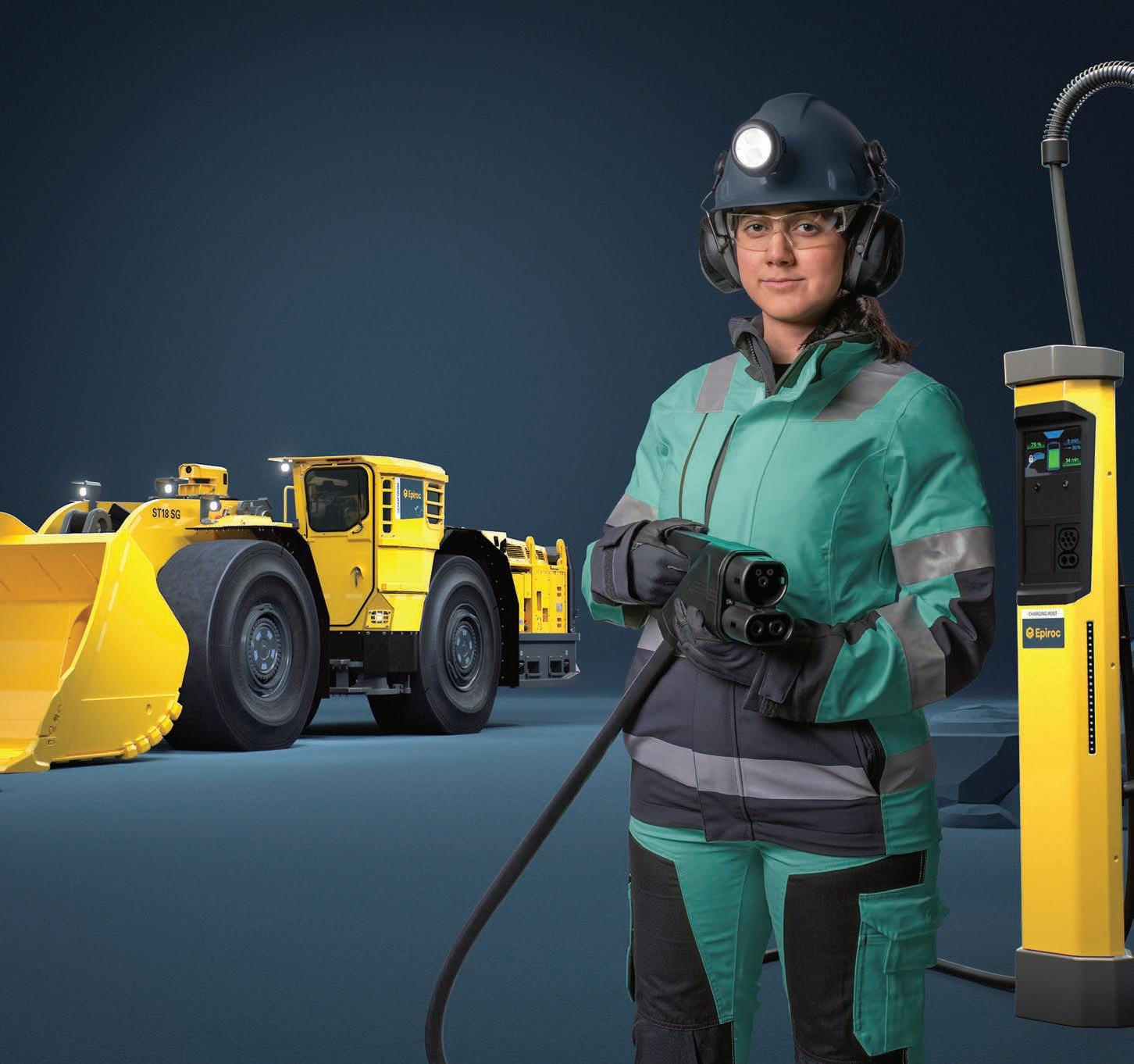
United. Inspired.
The zero-emission Scooptram ST18 SG is built for demanding underground applications, offering 20% longer drivetime and up to 5 hours on one battery charge. Automation-ready with Epiroc’s advanced systems, it reduces CO2 emissions by 648kg during an 8-hour shift. Prioritising safety, it features the highest energy density in the industry. Its electrical drivetrain enhances productivity with unmatched acceleration and traction, improving the local working environment by reducing heat, water vapour, and noise.



Queensland Mining & Engineering Expo (QME) celebrated its 30th year with a record-breaking event in July. With more than 300 exhibitors showcasing their technologies and innovations, QME welcomed in excess of 5000 delegates to the Mackay Showgrounds. Having been on the ground at the event, it really felt like the entire Queensland mining industry had made its way to Mackay for the expo, with many miners seemingly popping in immediately after a shift to peruse the exhibition floor.
QME 2024 proved the importance of face-toface events, not only because of the networking and relationship-building opportunities on offer but also because of the potential for product discovery.
And an event of QME’s stature is just as important for the Queensland mining industry as it is for the local community, turning the city of Mackay into a hive of activity for three days.
The September edition of Australian Mining provides the opportunity to reflect on QME 2024, with a post-show review highlighting some of the event highlights and featuring exclusive exhibitor interviews.
Elsewhere in this edition, we focus our attention on the underground mining industry, with several key mining equipment, technology and services (METS) companies discussing how they are enabling safer and more efficient operations under the surface. This includes Epiroc and its 18-tonne ST18 SG batteryelectric underground loader, which is the most powerful loader yet in the original equipment manufacturer’s battery-electric range.
CHIEF EXECUTIVE OFFICER JOHN MURPHY
CHIEF OPERATING OFFICER CHRISTINE CLANCY
GOUP MANAGING EDITOR PAUL HAYES
EDITOR TOM PARKER
tom.parker@primecreative.com.au
ASSISTANT EDITOR ALEXANDRA EASTWOOD alexandra.eastwood@primecreative.com.au
JOURNALISTS
OLIVIA THOMSON olivia.thomson@primecreative.com.au
Komatsu highlights a digital success story, with its collaboration, with Centennial Coal enabling an important step change in the miner’s maintenance practices.
Hexagon is also featured, with its collision avoidance system boosting safety outcomes underground. The Hexagon Underground Collision Avoidance System (UG CAS) can provide 360° operator awareness for surrounding vehicles and equipment.
This edition also offers the opportunity to celebrate the success of Alpha HPA, which is set to establish the world’s largest singlesite high-purity alumina products refinery in Gladstone, Queensland. We sat down with Alpha HPA managing director Rimas Kairaitis to found out more about the company’s novel solvent extraction purification technology.
Looking further south, Victoria has long been a historical gold mining jurisdiction, and while there seemingly isn’t the same gold fever in the state as there was during the gold rush in the 1860s, a slew of exploration companies are looking to commence mining operations once again. This includes Southern Cross Gold and its Sunday Creek gold-antimony project.
We were able to catch up with Southern Cross Gold managing director Michael Hudson to see how the company is progressing, and his insights were fascinating.

Throughout the years, Komatsu’s continued investment in core capabilities and strategic acquisitions has connected smart, diverse people and cutting-edge technologies with a shared belief that partnerships are the best way to solve challenges and meet society’s needs.
As the world grows and evolves, the people who power modern society and develop infrastructure count on partners they can trust to empower them and create value.
For a century, Komatsu has been by your side with ‘dantotsu’ quality, reliability, insight and support. Through manufacturing and technology innovations, Komatsu partners with its customers to create the solutions needed to achieve a sustainable future where people, businesses and the planet can thrive together.
Tom Parker Editor
KELSIE TIBBEN kelsie.tibben@primecreative.com.au
DYLAN BROWN dylan.brown@primecreative.com.au
CLIENT SUCCESS MANAGER
JANINE CLEMENTS
Tel: (02) 9439 7227 janine.clements@primecreative.com.au
SALES MANAGER
JONATHAN DUCKETT
Tel: (02) 9439 7227 Mob: 0498 091 027 jonathan.duckett@primecreative.com.au
ART DIRECTOR
MICHELLE WESTON
michelle.weston@primecreative.com.au
Cover image: Komatsu

QME continues to go from strength to strength, with the 2024 edition breaking exhibitor and attendance records.
18 UNDERGROUND MINING
An electrification bellwether Australian Mining sat down with Epiroc to discuss the company’s 18-tonne ST18 SG battery-electric underground loader.
22 UNDERGROUND MINING
A Matrix of safety and efficiency Matrix Design Australia is expanding its reach across the country through three new distribution partners.
32 UNDERGROUND MINING
E15: A special delivery
Choosing the right support vehicle for an underground mine can significantly increase the productivity of the fleet and reduce operational costs.
42 EQUIPMENT
A historic milestone for Hastings Deering Hastings Deering recently delivered the 6000th Cat D11 dozer to the Lake Vermont coal mine in Queensland. Australian Mining looks at how the Cat dealer made it happen.
46 RECONCILIATION
Balancing opportunity with responsibility
A mining company’s Reconciliation Action Plan provides a solid framework to better support Indigenous communities.
54 EQUIPMENT
A powerful Advantage
When HSE wanted to upgrade its 2500hp Cummins QSK60 engines, Cummins’ Advantage solution was the obvious choice.
62 INDUSTRY INSIGHT
Australia’s critical commodities
Australian Mining takes a look at the outlook for three commodities that will be critical to the energy transition.
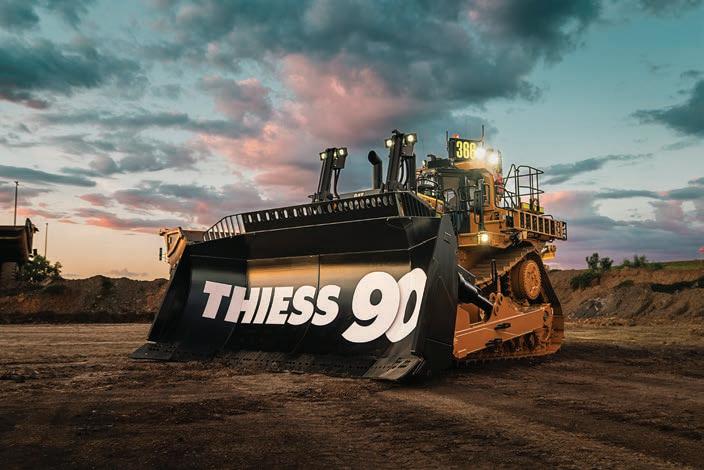
68 EVENTS
In the event of excellence
Early-bird registration is now open for the WA Mining Conference and Exhibition, with this year’s show set to be better than ever.









KEEP UP WITH THE LATEST EXECUTIVE MOVEMENTS ACROSS THE MINING SECTOR, FEATURING DE GREY MINING, FORTESCUE, RIO TINTO, AND MORE.
De Grey Mining welcomed Geoff Fenton as the new general manager – operations of the Hemi gold project in Western Australia.
Fenton has over 25 years of experience in mine and technical operations and will commence his role at Hemi on September 2.
In the role, Fenton will be responsible for the operational readiness of Hemi, as well as the transition from development to operations. He will be responsible for the selection of mining contractors, major supply contracts and building out the operations team.
De Grey managing director Glenn Jardine said the company is pleased to welcome Fenton to the role.
“Bringing Geoff into the business as we prepare for construction will provide an early focus on operational readiness for a successful commissioning and ramp-up phase of Hemi through to steady state operations,” Jardine said.
Fenton’s recent roles have been as senior project manager at Hancock Prospecting/Roy Hill and general manager operations and planning at the Karara iron ore operation.
In his role at Hemi, Fenton will work alongside project director Peter Holmes to guide senior management in achieving mining and processing objections and ensuring legislative and regulatory compliance.
A big reshuffle marked the month of July at Fortescue, with a new chief operating officer (COO) and chief financial officer (CFO) appointed in a bid to establish a more “lean, impactful, and agile” company.
Current chief corporate officer Shelley Robertson was appointed COO after joining the company in October 2023.
Fortescue said Robertson is an experienced executive with a career spanning 30 years in oil and gas, mining and renewable energy.
Acting CFO Apple Paget officially moved into the role of group CFO after serving 11 months acting in the role.
Apple joined Fortescue in January 2023 as group manager finance and tax and has 25 years’ experience as a finance executive.
Assistant secretary Navdeep (Mona) Gill has also been moved up to company secretary.
“The company must continually evolve to ensure it remains lean, is best positioned to deliver on its strategy and generate the maximum value for shareholders,” Fortescue said in a statement.
“The streamlined One Fortescue team will be reflective of Fortescue’s board, compromising of nearly 50 per cent women.
“Diversity will continue to be a key measure of our performance, with new targets implemented to drive diversity across the business.”
In August, Noel Pearson, a prominent Indigenous leader, social advocate and lawyer, joined the Fortescue board as a nonexecutive director.
Pearson is the founder of the Cape York Partnership, an organisation focused on advancing economic and social outcomes in northern Queensland. He also established Good to Great Schools Australia, which aims to improve educational results for all Australian students, and the Cape York Land Council, a key body representing Indigenous people in the region.
“I am honoured to be a member of the Fortescue board and I look forward
to making a contribution to this diverse, progressive, and successful business,” Pearson said.
“Fortescue is a proud Australian company that is led by its values from mine site to the boardroom – something I have great respect for.”
Rio Tinto recently welcomed Katie Jackson as the new chief executive officer (CEO) of its copper business.
Jackson holds international experience in the energy sector, having worked in operational and commercial roles for companies such as Shell, Anadarko, Equinor and BG Group.
Jackson is currently National Grid Ventures’ president, where she is responsible for the development and operation of large-scale energy infrastructure assets. Jackson will begin her tenure at Rio Tinto on September 1.
“I am inspired by Rio Tinto’s ambition to deliver the materials the world needs,” Jackson said.
“It is an exciting time to lead the copper business when we have such a central role to play in delivering a low carbon future and I believe my current role delivering major infrastructure projects will help me bring a new perspective.
“I look forward to collaborating with our teams across the globe, in partnership with communities and governments, and lead the business to an even stronger future.”
Jackson replaces Bold Baatar, who is set to become Rio’s chief commercial officer in September.
“Katie brings diverse experience from across the energy sector,” Rio Tinto chief executive officer Jakob Stausholm said. “Her leadership will be invaluable as we shape our copper business for a successful future.”
Global Lithium Resources recently announced the appointment of Ron Mitchell as executive chair.
Mitchell joined Global Lithium in March 2022 as executive director and was then appointed as managing director two months later.
Since May 2022, Mitchell led the signing of an offtake agreement with Canmax, bringing in Mineral Resources as an investor, strategic mergers and acquisitions, and the delivery of a 69.6-million-tonne resource base across the Manna and Marble Bar lithium projects in Western Australia.
“It is an honour to be appointed executive chairman of Global Lithium at this pivotal time in the company’s development,” Mitchell said.
“I look forward to continuing to lead Global Lithium towards the important
milestones in front of us, including transition from explorer to developer.”
The board also appointed current non-executive director and founding director Dianmin Chen as executive director, effective immediately.
As executive director, Chen will work closely with Global Lithium’s project development and executive teams to complete the Manna definitive feasibility study in 2024, as well as work towards a final investment decision in 2025.
“I am also delighted that Dr Dianmin Chen has been appointed executive director,” Mitchell said.
“As the original founder of Global Lithium and with his extensive background in the mining industry, Dr Chen’s expanded role will be a great asset to the development of Global Lithium and the Manna lithium project.”
Mitchell’s appointment coincides with the resignation of non-executive chair Geoff Jones.
Austin Engineering has appointed Sybrandt (Sy) Van Dyk as its new managing director and CEO, taking effect from July 1 2025.
Van Dyk is an experienced financial and resources industry executive who has been president of Perenti’s drilling services division since October 2023.
Before DDH1 was acquired by Perenti in October 2023, Van Dyk had
Sand Quarries Australia Pty Limited, a wholly owned subsidiary of MAAS Group Holdings Limited, has been convicted and ordered to pay a fine of $210,000 in Dubbo Local Court for two water pollution offences. The prosecution was brought by the Environment Protection Authority (EPA).
The offences occurred at the Rawsonville Quarry, also known as Dubbo Sands (the Quarry).
In January 2023, an unknown quantity of polluted water was discharged from the Quarry into the Macquarie River. The water from the Quarry contained high levels of sediment and caused significant erosion to the riverbank. The offences contravened s 120 of the Protection of the Environment Operations Act 1997.
This is Sand Quarries Australia Pty Limited’s first conviction, and it remains committed to reducing adverse environmental impacts and supporting the Dubbo community.
On 24 June 2024, Dubbo Local Court convicted Sand Quarries Australia Pty Limited of the offences and ordered Sand Quarries Australia Pty Limited to:
1. Pay a fine of $210,000
2. Prepare plans of action to restore the environment and prevent the recurrence of the offences.
3. Pay the EPA’s legal and investigation costs; and
4. Publish this notice.
been DDH1’s managing director and CEO since October 2018.
Prior to his tenures at Perenti and DDH1, Van Dyk worked at Macmahon Holdings as CFO from March 2014 to June 2015. He was then promoted to the managing director and CEO positions, both of which he served until October 2016.
Bruce Cleaver holds extensive commercial and mining experience. He was previously CEO of De Beers Group, a global diamond company, from 2016 to early 2023. He then became co-chair of the company, a role Cleaver served until the end of 2023.
Sand Quarries Australia Pty Limited convicted of water
Van Dyk also spent almost 13 years at WesTrac, working in various roles such as chief operating officer WA, CFO and acting CEO.
Before becoming De Beers’ CEO, Cleaver had been at the company since 2005. During those 11 years, he was general counsel and held various executive roles spanning business development and strategy.
Sand Quarries Australia Pty Limited, a wholly owned subsidiary Limited, has been convicted and ordered to pay a fine of $210,000 for two water pollution offences. The prosecution was brought Protection Authority (EPA).
“I am delighted to be given the opportunity to lead Austin from FY26 (the 2025–26 financial year),” Van Dyk said. “David has built Austin to be a fully integrated, global business, and I will be steadfast in my focus on continuing that work.
On July 1, Cleaver became chair and a non-executive director of Gemfields Group, a UK-based gemstone company listed on the Johannesburg Stock Exchange (JSE) and the Alternative Investment Market.
“I will bring my expertise in operational performance and customer focus to ensure Austin remains the global market leader in customised heavy haulage mining equipment.”
At AngloGold Ashanti, Cleaver will serve as a member of the audit and risk committee and the social, ethics and sustainability committee.
The offences occurred at the Rawsonville Quarry, also known Quarry).
Also joining the company was Nicky Newton-King, the former CEO of JSE. Newton-King is a corporate finance and securities regulation lawyer who holds broad expertise in legal, business, regulatory, capital markets and sustainability matters.
In January 2023, an unknown quantity of polluted water was into the Macquarie River. The water from the Quarry contained and caused significant erosion to the riverbank. The offences Protection of the Environment Operations Act 1997 .
Van Dyk replaces David Singleton, who will retire as managing director and CEO on June 30 2025. To ensure a smooth transition, Van Dyk will commence a handover period with Singleton on May 1 2025.
AngloGold Ashanti has appointed two new independent nonexecutive directors, taking effect from July 22.
While at JSE, Newton-King was key in modernising the stock exchange through the implementation of the JSE’s socially responsible investment index, the first index of its type globally. AM
This is Sand Quarries Australia Pty Limited’s first conviction, reducing adverse environmental impacts and supporting the
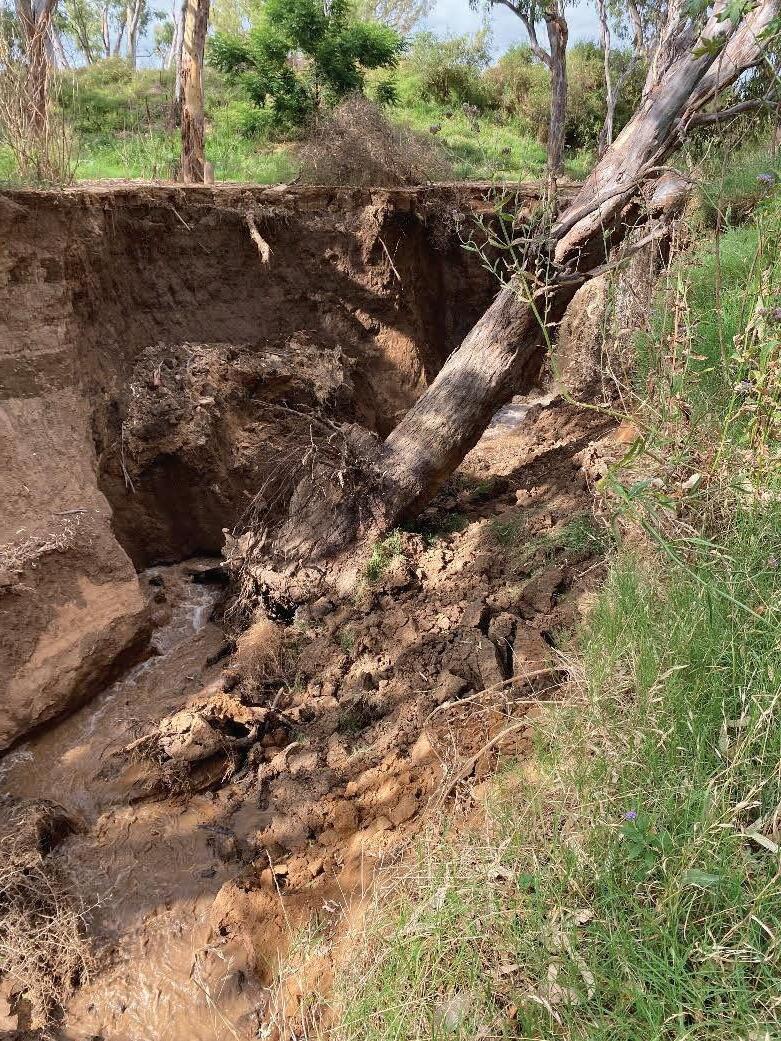

Fully electric system Remote controlled Flexible cutting profile
This simplified, automated method brings more control to the process and requires up to 50% less equipment than batch methods.
• 100% clean up ⎯ no secondary material removal required
• Up to 50% less equipment needed versus batch process

To get in contact with the Hard Rock team, scan the QR code.

STAGE 2 OF THE HPA PROJECT WILL COMPRISE FULL-SCALE PRODUCTION OF UP TO 10,000 TONNES OF HIGH-PURITY ALUMINA MATERIALS PER YEAR.

AUSTRALIAN MINING SAT DOWN WITH ALPHA HPA MANAGING DIRECTOR RIMAS KAIRAITIS TO DISCUSS THE COMPANY’S NOVEL SOLVENT EXTRACTION PURIFICATION TECHNOLOGY FOR ALUMINIUM.
Aluminium, like many metals, doesn’t spring from the ground fully formed – this essential commodity must first be made from bauxitecontaining alumina.
But the process of converting aluminium to high-purity alumina (HPA) can be energy-intensive, and with the global goal of reaching netzero by 2050 rapidly approaching, miners are constantly looking for more ways to limit their environmental impact while meeting the increased demand for HPA.
According to Global Market Insights, the HPA market size exceeded $US2.8 billion ($4.27 billion) in 2023 and is projected to grow to $US8.8 billion ($13.4 billion) by 2032.
The demand is driven by factors such as the increased use of light-emitting diode (LED) lighting, as well as HPA’s key role in lithium-ion batteries for the
electric vehicles needed for the global energy transition.
The importance of HPA was further highlighted when the Federal Government added it to its critical minerals list in March 2022.
HPA is at the heart of Alpha HPA, an ASX-listed company that operates a downstream chemical materials processing facility.
Alpha HPA managing director Rimas Kairaitis told Australian Mining that the company evolved out of an upstream mining business.
“Going back a few years ago, we were looking at extracting nickel, cobalt and aluminium from a resource in central New South Wales,” Kairaitis said.
“It was when we were assessing technologies to extract and purify aluminium into a high-value product that we connected with the technology provider we now work with.”
Traditionally, the mining industry takes aluminium metal, dissolves it,
then oxidizes it in a pure environment to produce HPA oxides and chemicals.
Because aluminium metal is energyintensive, this process produces high amounts of carbon and chemical emissions and creates a significant amount of waste, which can cause harm to the environment. It is also one of the most expensive metals to produce.
However, Alpha HPA’s purification process is changing the game. Dubbed Smart SX technology, this process uses established solvent extraction (SX) to transform aluminium.
SX is commonly used on metals such as copper, zinc, uranium and nickel, with about a quarter of the world’s copper going through an SX circuit.
Alpha HPA’s Smart SX technology has commercialised what the company is calling the “world’s first” adoption of SX purification on aluminium.
The technique isolates aluminium into a purified chemical process stream, which can be turned into a variety
of aluminium forms. By combining aluminium in its ionic form (AI+3) with oxygen, HPA is produced.
By combining AI+3 with water via Smart SX technology, HPA hydroxides can be created. Combining AI+3 with sulphates produces ultra-pure aluminium sulphates, demonstrating the technology’s flexibility and versatility.
“The technology was recognised as being quite novel as it was able to extract aluminium from any aluminium-bearing solution and deliver a high-purity process stream that allowed us to make HPA and other HPA products,” Kairaitis said.
“It was this that made us realise this world-first technology required our sole focus. Rather than operating an extractive mining process, we’re better off leveraging consistent, semi-refined input that could be provided from alumina refineries in the Gladstone region of Queensland.”
Smart SX sees up to 70 per cent lower total carbon emissions in comparison to historical HPA processes by not using aluminium metal as feedstock.
Instead, it uses alumina hydrate from Rio Tinto’s Yarwun alumina refinery near Gladstone, operating at atmospheric pressures and lower temperatures.
“The alumina hydrate is consistent and relatively pure already,” Kairaitis said. “We prepare that material to implement into a solution to present to the extraction technology.
“This is a more efficient use of the technology as it simplifies the business in that we no longer manage extraction of minerals. We are purely in the mineral processing sector.”
As part of its decarbonisation efforts, Alpha HPA recycles 100 per cent of its key chemicals as by-products. Alpha HPA’s proprietary technology requires reagents to purify raw materials, which blasting systems company Orica manufactures at its plant in Yarwun, Queensland.
Alpha HPA sends the by-products to Orica and they are returned as reagents via a waste-free process.
“The technology works through high volume reagent flows that come in and out of the process,” Kairaitis said. “Under a set of
“By being in close proximity to Orica, it allows us to have an almost zerowaste facility … we have by-products coming in and by-products going out, with the net cost to our business being lower and more environmentally and commercially sustainable.”
Further cementing Alpha HPA’s presence in Gladstone is its soon-tobe established HPA products refinery, which is benefiting from the company’s established relationships with Orica and Rio Tinto.
“We’re leveraging Orica infrastructure that’s 50 metres away and Rio Tinto’s aluminium processing infrastructure that’s 2.5 kilometres
“It’s incredibly lenient having your key inputs within close proximity to the business.”
Alpha HPA describes its HPA First project as its Smart SX Technology “in action and at scale”.
Set to be one of the largest single HPA refineries in the world at 10-hectares, the HPA First project comprises two stages.
Stage One is currently in production and represents the first commercial application of Alpha HPA’s Smart SX technology to produce 99.99 per cent pure aluminium products.
“Stage One has been a key enabler for
“It’s allowed us to operate our Smart SX technology at a small commercial scale to produce aluminium products across our full range for our customers and deliver them at a volume that is meaningful and de-risks the process with respect to the project’s technical and commercial components.”
In May 2024, Alpha HPA made a final investment decision (FID) on Stage Two of HPA First, which followed the successful construction, commissioning, and operation of Stage One.
The Stage Two FID is supported by a $400 million loan from the Federal Government, an amount comprising


THE GLADSTONE FACILITY REPRESENTS THE FIRST COMMERCIAL APPLICATION OF ALPHA HPA’S PROPRIETARY LICENSED SOLVENT EXTRACTION AND REFINING TECHNOLOGY.

raising by Bell Potter Securities and Macquarie Capital, as well a share purchase plan.
The Stage Two FID allows Alpha HPA to begin project execution and construction, which is expected to commence in August 2024.
Once operational, Stage Two will create 120 full-time job opportunities for the local community and generate more than 300 jobs during construction. The site will run on 100 per cent renewable energy, further decarbonising the process.
“All the engineering is well advanced, and that will see us in production by late 2026,” Kairaitis said.
“Stage Two is full-scale commercial implementation of the Smart SX technology … The operational knowledge that builds (in Stage Two) is an important de-risking step because we’re taking skilled people and training them in a new process.
“Through this training, they gain a discrete skillset and become the only people in the world that can run our technology.”
for their ultra-high purity requirements and product specification demands,”
Kairaitis said.
“We will continue to add new names to the business as we work through technical qualification. Unlike a traditional mining business, we don’t have one or two customers. We’re a specialty materials business that might have 30 or 40 customers. It’s quite a different model.”
Further aiding Alpha HPA’s global expansion is its memorandum of understanding (MoU) with Orica, which will see the companies investigate the feasibility of establishing a new HPA manufacturing facility in North America similar to the one in Gladstone.
“We see a lot of interesting demand coming out of North America,” Kairaitis said.
“Geopolitically, they have a lot of focus on reshoring supply chains. As a result, the forecast demand in North America for the semiconductor sector is looking promising. Having a facility in North America in five to 10 years
the Smart SX technology because we’re going to run up against not having enough material to meet demand, so we’ll need facilities,” Kairaitis said.
Alpha HPA’s product range goes beyond HPA. It also includes products made from alumina hydrates, aluminium nitrates and aluminium sulphates.
we’re in a wonderful position to have been funded and are now progressing to make our materials and selling them,” he said.
“For the remainder of 2024, we want to advance Stage Two of the HPA First project to the construction phase, hold our schedule and budget and keep adding customers to the business.” AM


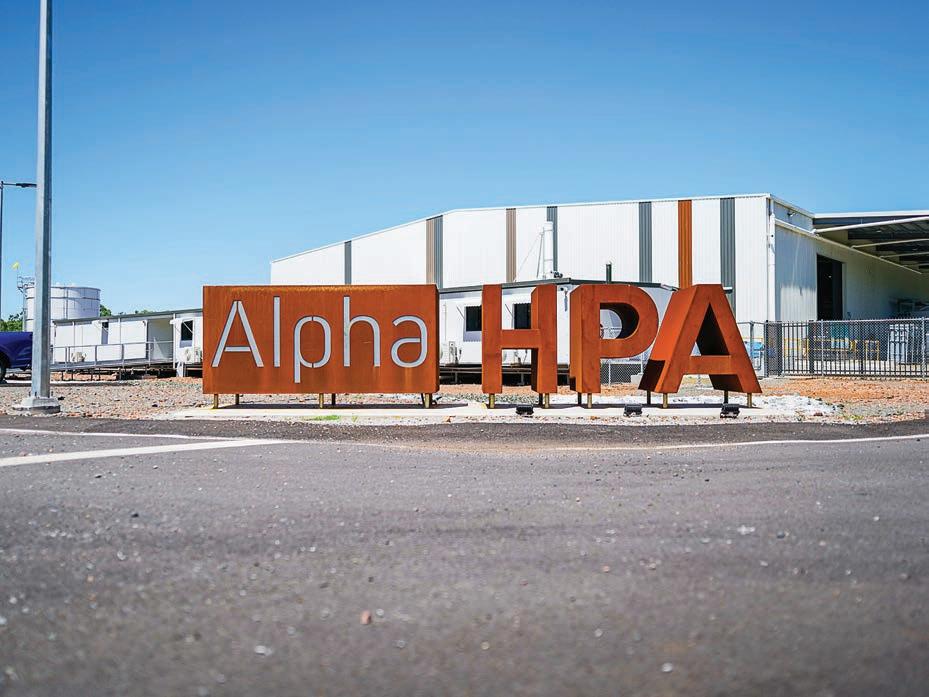


As Australia’s largest regional mining event, the Queensland Mining and Engineering Exhibition (QME) welcomed over 5000 visitors to Mackay Showgrounds over three days in late July, hosting over 300 exhibitors and 29 seminar sessions.
The Seminar Series, sponsored by Komatsu, opened with a keynote address from Federal Resources Minister Madeleine King, who highlighted the importance of holding events like QME to remind people of the value regional centres like Mackay provide to the economy.
“People in Mackay and in central Queensland understand how important the resources industry is to Queensland’s economy,” she said. “And Queenslanders understand how important the resources industry is to the prosperity of the state and nation.”
King said the whole country feels the benefits of a strong resources industry but implored the mining sector to not rest on its laurels.
“The economy is changing,” she said. “The nature of global trade is changing … Australia needs to respond to these
EVERYTHING FROM DIGGERS AND DOZERS WERE ON THE GROUND AT QME 2024.
changes so we can create jobs and wealth for future generations.”
The 500 Pavilion hosted the Decarbonisation Accelerated program on the Wednesday, with BHP vice president climate Graham Winkelman giving the opening keynote address.
“In the 2022–23 financial year, BHP’s operational greenhouse gas emissions were already 32 per cent below the baseline,” he said. “This performance has been achieved primarily by introducing renewable electricity via power purchase agreements.
“The path ahead of us remains consistent with our operational greenhouse gas emissions targets, and we continue to make good progress towards it.”
On hand at QME 2024, Australian Mining caught up with a range of the country’s brightest mining equipment, technology and services (METS) companies to discuss why events like QME are so important.
Komatsu had its GD955–7 grader on display at QME – a machine specifically built for mining operations, able to grade
33 per cent more area per hour than the previous model.
The GD955–7 is well matched to larger haul trucks, making it a strong addition to mining fleets. The machine also comes standard with Komatsu’s 360° camera system, KomVision, housing a five-camera system to provide a view around the vehicle.
Komatsu also sponsored the QME Seminar Series, with Komatsu Australia sustainability product manager Kevin Mascarenhas discussing the company’s sustainability strategy.
Mascarenhas’ presentation highlighted how Komatsu integrates eco-friendly technologies in its machinery, optimises their use and reduces environmental impact through efficient manufacturing and operations.
When asked about the importance of events like QME, Mascarenhas said it provides an important opportunity to connect with the workers that own and operate Komatsu machinery.
“Komatsu is a global business, but the people that work on and operate Komatsu machines, they attend shows like this,” he told Australian Mining “Operators have the opportunity to understand what Komatsu’s


global strategy looks like and how it translates into their sites bringing in new technologies like autonomy or electrification like batteryelectric machinery.”
Mascarenhas said there is so much innovation on offer at events like QME, with plenty to be gained from walking the grounds and engaging with other exhibitors.
“Australia is one of the most advanced mining industries in the world,” he said. “We’ve pioneered automation and many other mining solutions and events like QME enable people to see what everyone’s working on and where the industry is heading.”
Having been part of the event for the past decade, Hastings Deering sees QME as an important opportunity to connect with the community.
“We rarely get the chance where we’re not at the coal face to meet our customers in a different environment and have that opportunity to catch up and build on our partnerships,” Hastings Deering executive manager for site performance Matt Small told Australian Mining.
Small said Hastings Deering is nudging 1000 employees in Mackay alone, highlighting the company’s strong presence in the regional city.

“People expect us here and we expect to be here,” he said. “We’re part of the community, we’re tapping 1000 employees and have 68 apprentices here in Mackay, and their families expect us here as much as our customers.”
Hastings Deering had the Cat 988 XE wheel loader on display at QME 2024, which Small said was a “good size for an event like this”.
“The 988 XE wheel loader has an electric drivetrain, which provides many different efficiencies including greater fuel economy,” he said.
An electric drivetrain has the potential to reduce the total cost of ownership of the 988 XE, with reduced wear and tear a key benefit, while the loader has proven its ability to meet or exceed production targets.
Small said customers largely do their own legwork and research, with events like QME important to “see the iron in the flesh”.
FLS has built a strong presence in north Queensland, with many of its plant and technologies fitted at coal and hard rock mines across the region.
FLS Asia Pacific head of eastern region sales Karl Spaleck said events like QME provide an important opportunity for companies to highlight their commitment to the region.
“We’ve got great innovations and equipment, and we’re also finding ways to better service our customers,” Spaleck told Australian Mining
“We see QME as an opportunity to show people who we are and demonstrate our presence in the region – we’ve got service centres in Mackay and Rockhampton to support our north Queensland customer base.”
Spaleck said FLS’ REFLUX technologies – which offer enhanced separation efficiencies in mineral processing – are fitted at mines in north Queensland, while the company’s grinding mills and crushers are also located throughout the region.
“When attendees hear that you can reduce tailings, electricity and water, for example, these are things that sometimes don’t get highlighted in the day-to-day running of an operation,” he said.

“But if you look at a yearly consumption rate, you can see how much you can save, and you can turn that into million-dollar savings, so it’s a significant number. People can get awareness of that through conversations had at QME.”
Dredge Robotics had it all at its QME booth as the company showcased its cutting-edge robotic dredging technologies.
Attendees had the opportunity to explore Dredge Robotics’ advanced systems that integrate automation and precision to streamline dredging processes, reduce operational risks, and improve environmental outcomes.
Dredge Robotics chief executive officer Antony Old said attendees were pleasantly surprised at how the company’s products can effectively and safely dredge ponds without damaging the protective liner.
“We had people come up to us and say they didn’t know this technology existed,” Old told Australian Mining
“In other dredging processes, you typically have a person on a barge, in an excavator or in the pond digging with equipment. You’re exposing your staff to whatever’s in the pond, but with the robotic dredging system, those risks are totally eliminated.
“Our robots are versatile, allowing them to operate in various environments from small assets to large tailing dams, all while maintain efficiency.”
Dredge’s fleet of robots can cut the need for a scheduled shutdown as the robot can clean tanks with all
types of sediment, from light mud to compacted clay. This includes sediments that have low or high pH levels, cyanide, corrosive liquids and heavy metals.
“Our online robotic solutions use an advanced suite of sensors and GPS to clean with pinpoint accuracy while your wastewater assets remain in service,” Old said.
“People didn’t realise we can desludge your wastewater ponds, raceways, digesters, oxidation ditches or sedimentation tanks.”
AusProof was a prominent participant at QME, recognising the critical importance of reconnecting with customers and industry peers.
The event provided a valuable platform for AusProof to engage directly with clients, reinforcing relationships that have been pivotal to the company’s success.
AusProof Queensland sales representative Craig Feil said the face-to-face interactions are vital for understanding customer needs, discussing innovative solutions, and receiving direct feedback.
“To be able to help someone in person and take feedback from customers is where we find the most value at QME,” Feil told Australian Mining.
“You may speak to a customer once or twice a year and not know what they look like other than their email or phone number.”
With a passion for innovation and exploring the unknown, AusProof’s research and development (R&D) team is always looking for the next
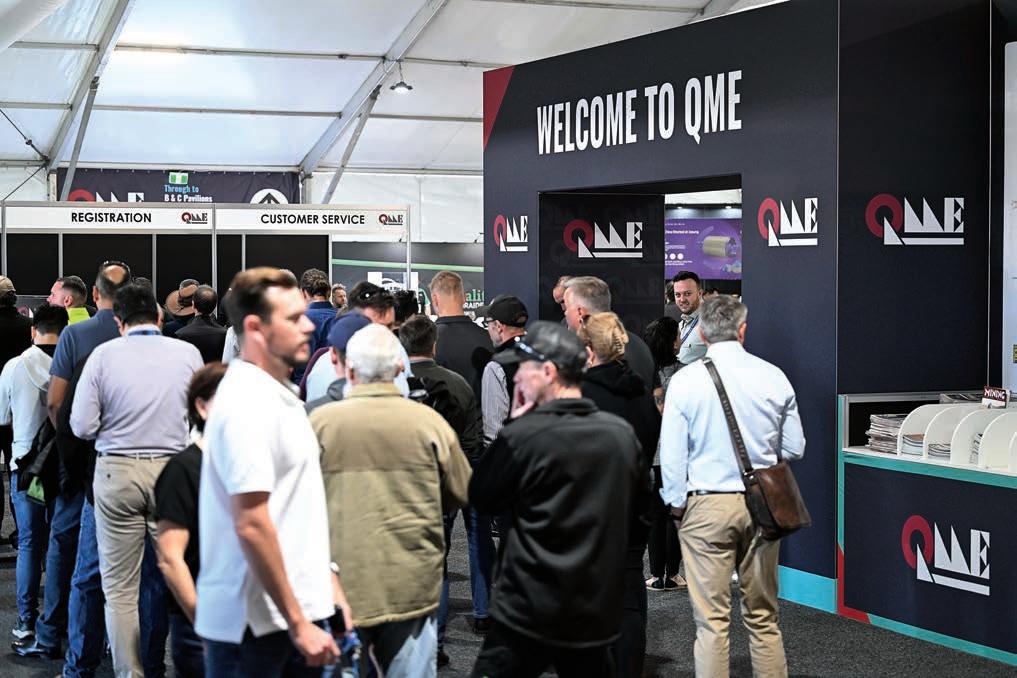
MacKellar
MacKellar used QME as an opportunity to foster relationships with mutual exchanges.
QME provided the perfect backdrop to celebrate the company’s ongoing work and collaboration on Queensland projects such as the Jellinbah, Carmichael, Callide and Middle Mount coal mines.
MacKellar general manager, business development Dave White said QME allowed the company to engage with
“It’s good to get an understanding of the suppliers in the region as suppliers are so important to us,” White said. “We are also here to fly the flag for MacKellar as a place of choice to work.”
White highlighted the major players involved in the event such as Anglo American and Coronado, making QME a prime networking opportunity.
He also noted MacKellar’s strong regional reputation and ambitious growth plans, including geographic and commodity diversification into critical
mining, civil works, and infrastructure construction, Mackellar showcased its extensive capabilities, supported by a robust fleet and a workforce of nearly 1500 employees.
Revizto
Revizto used QME as an opportunity to network extensively across the mining sector.
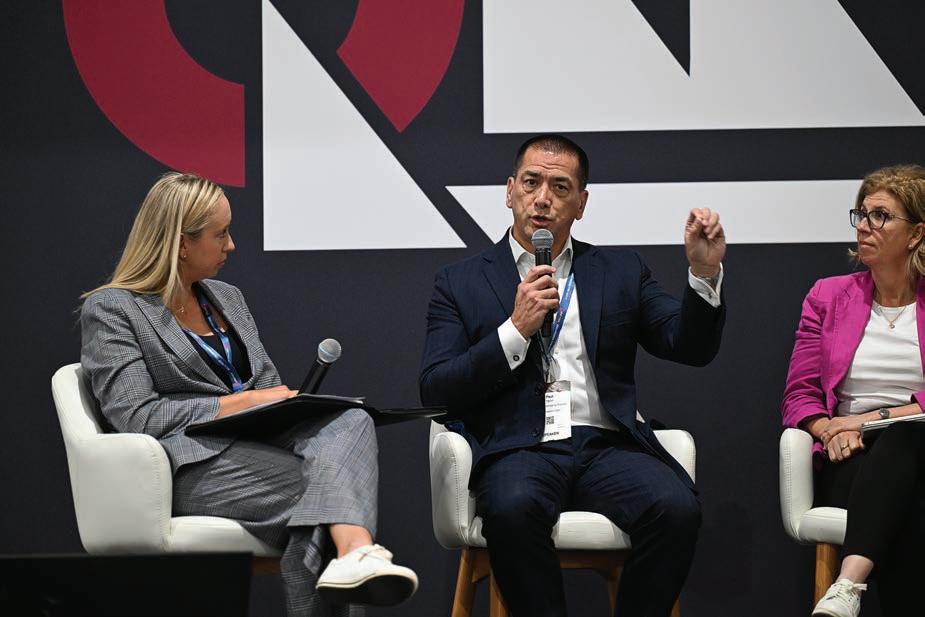
Highlighting the company’s evolution from dry hire services to comprehensive
Revizto Asia Pacific sales executive Nick Seibel said the company saw plenty of value in engaging with a diverse array of professionals from different regions and specialties, including international attendees.
“It’s been great to network with a large number of people who have come from different areas, different sectors of mining and different places,” he said.
The primary focus was on introducing Revizto’s digital engineering solutions which facilitate collaboration, design coordination and on-site delivery using 2D drawings, drone scans, and 3D models.
“We’ve been looking at introducing Revizto to the mining sector ... it’s been great to introduce new technology that is immensely useful for industry,” Seibel said.
QME provided a balanced mix of meeting new contacts and reconnecting with existing clients, fostering meaningful conversations and potential collaborations.
With record-breaking attendance numbers and the introduction of new and innovative technology, there’s little doubt that QME 2024 was one for the history books. AM
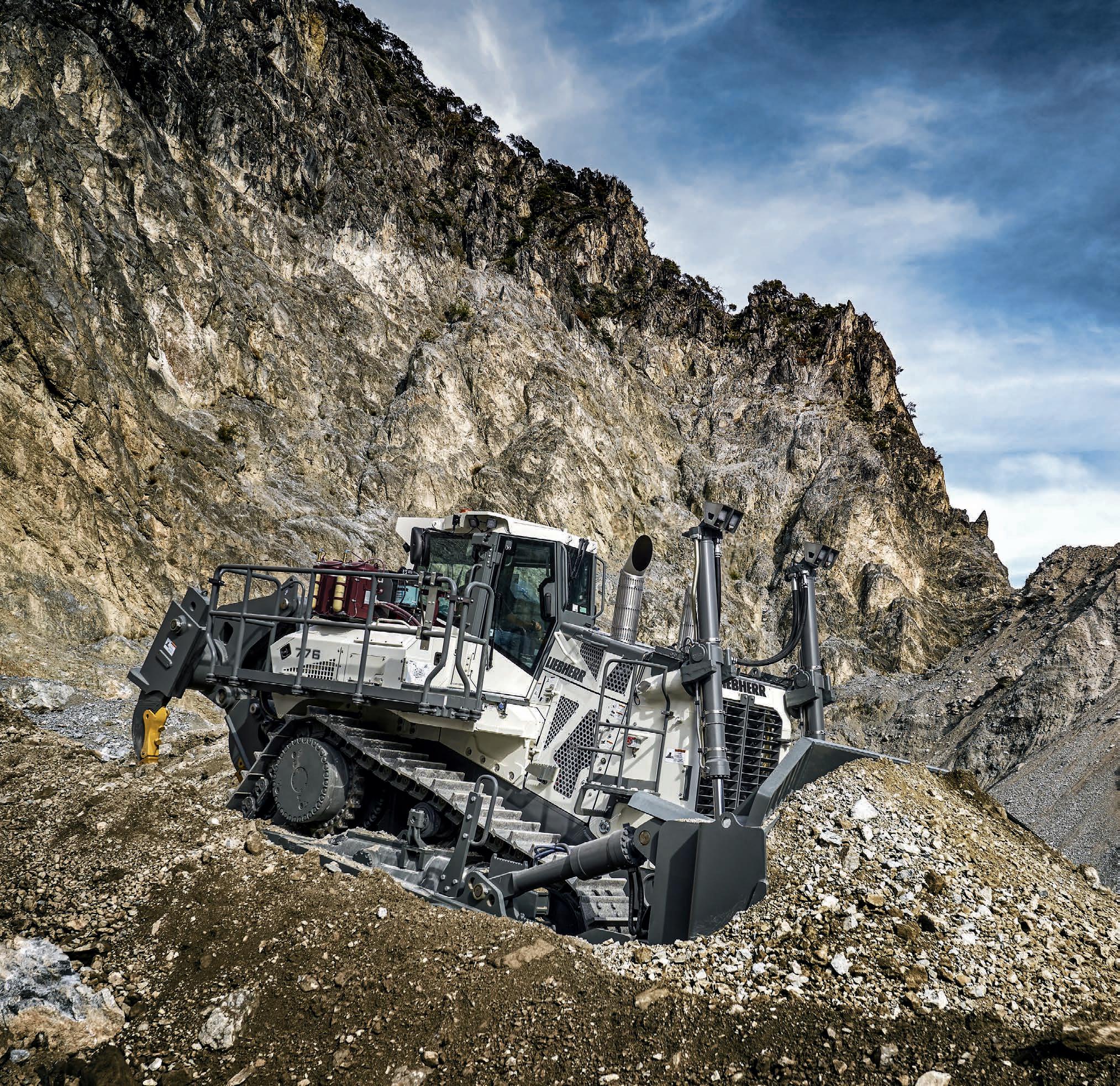
–

–
AUSTRALIAN MINING WITH EPIROC TO DISCUSS THE COMPANY’S 18-TONNE ST18 SG BATTERY-ELECTRIC UNDERGROUND LOADER.
The mining industry is changing, with traditional practices increasingly challenged as heightened sustainability obligations are placed on miners.
Through measures such as the Australian Government’s Safeguard Mechanism, companies that aren’t vigilant about managing their carbon footprints are being penalised, with potential impacts to profitability.
And the need to decarbonise is only set to increase going forward, with more and more miners adopting electric technologies to best position themselves ahead of a green future.
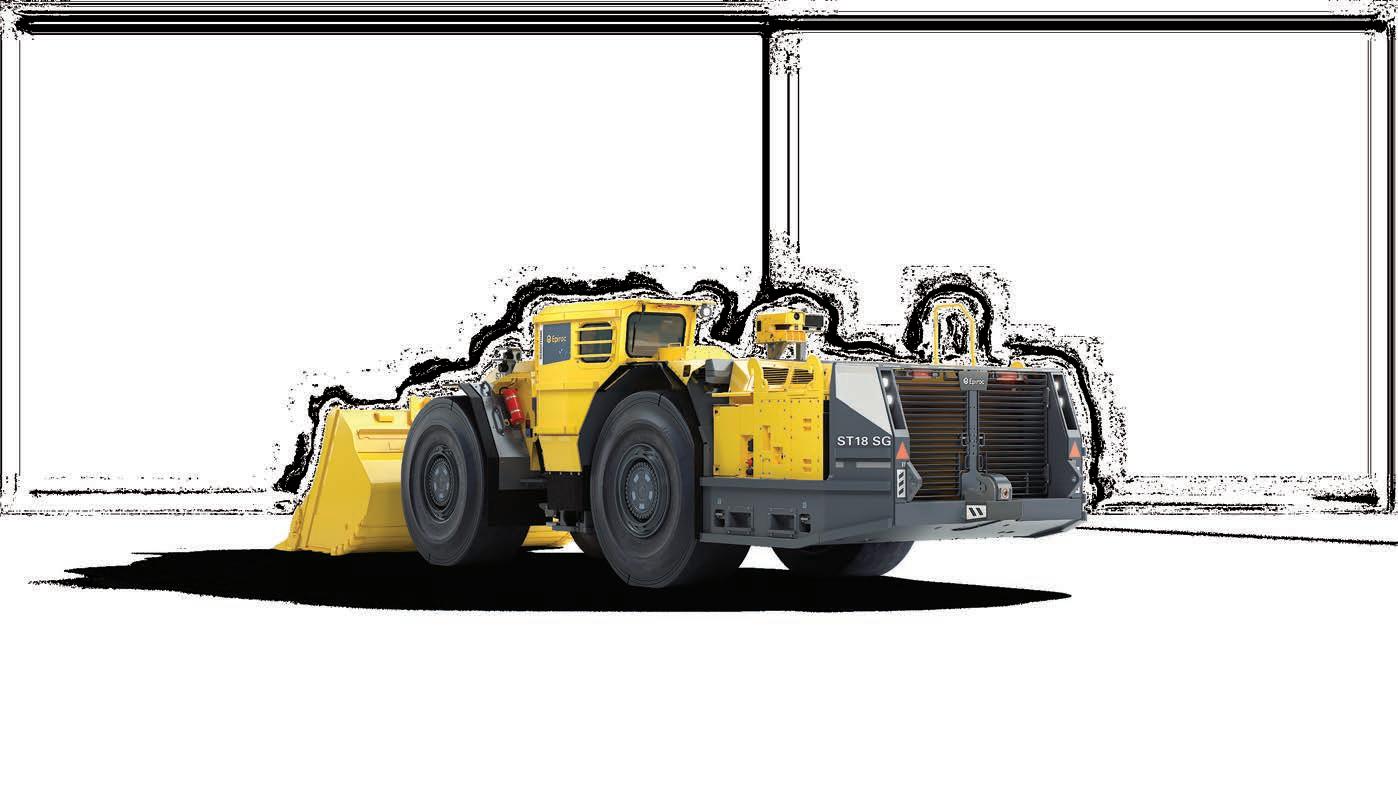
A key electrification partner is Epiroc, a global original equipment manufacturer (OEM) and digital pioneer driving new frontiers in mining innovation.
Epiroc recently introduced its 18-tonne ST18 SG battery-electric underground loader, the most powerful loader yet in Epiroc’s battery-
gas emissions.
“The ST18 SG is the evolution of our ST18 S diesel product,” Epiroc’s Australasia regional application expert, material handling, Cameron Kings told Australian Mining.
“We’ve brought the machine into a BEV (battery-electric vehicle) spec but kept many of the proven characteristics of the ST18 S, with the front-end the same and the operating system largely
to less vibration,” Kings said. “The machine also emits zero DPM (diesel particulate matter) of course, which is becoming increasingly important in an underground environment.”
Such is the quiet nature of the machine, Kings explained how workers can freely have conversations within an underground mine while the ST18 SG trams back and forth.
The ST18 SG also has its
dirt, an operator of a diesel machine needs to be mindful of, ‘What’s my engine doing? If I bog down too much, I’m going to lose pile penetration and lose my hydraulic capability’.
“Whereas the battery-electric ST18 SG has two isolated systems, with a single traction motor for the propulsion circuit, so the machine can drive completely independent of the hydraulics, which are powered by their

“So when you’re digging, from a throttle perspective operators only have to concentrate on pile penetration. Then as you use the controls to manipulate the boom and bucket, they’re on a separate circuit.
“You’ve got the auxiliary motor ramping up and down, controlling the hydraulics so you’re getting optimal hydraulics while you’re digging, but then you’re also getting optimal traction by controlling the machine with the throttle pedal.”
Kings said the ST18 SG’s ability to deliver 450kWh of usable battery capacity is a “significant jump” from other machines on the market, resulting in fewer charging stops and longer uptime.
There is also capacity to further prolong battery life with opportune charging.
“The good thing about these batteries is you don’t have to charge them from empty to full,” Kings said.
“When we talk about a charge cycle, we’re talking about energy in and energy out. We can charge from 20 per cent to 50 per cent, unplug the machine and use it, then bring it back.
“With opportune charging, we look at the application. If you’re extracting material from one heading, once the heading is depleted, you’ve got 45 minutes to plug it back on the charger.

“Depending on available charging infrastructure, the battery can take around 90 minutes to charge from 10 per cent to 90 per cent with current technologies. After 45 minutes, it gives you a good 30 to 40 per cent of charge back in the battery, which is ample to then go and do the next heading.”
Kings highlighted a raft of safety benefits too, with the ST18 SG boasting a thermal management system.
“Regardless of how you wish to charge your battery, our battery is always being
life by keeping temperatures in the correct range so as not to overheat the battery.”
Epiroc has also installed other safety measures on the ST18 SG, including a high voltage interlock loop (HVIL).
“The idea of the HVIL is, if you go to the machine and it’s live, and you open a cover or a lid on a box that may have voltage in it, the HVIL cuts the machine out and shuts the battery down,” he said.
“Every cover on the battery has a HVIL switch on it, so any time there’s
And as more and more deployments are proven successful, the pool of electric adoption is growing wider.
But, as Kings explained, it’s not a “flick of the switch”.
“I was involved with installing the first Epiroc battery machine into Australia, and, like any foundational technology, there were some hurdles,” Kings said. “While there are those in the industry enthusiastic about going to a full battery fleet, they need to understand that there is a lot of

Ex-certified and suitable for use in underground operational sites, including Group 1 hazardous environments, AusProof’s stainless steel products can also be used in metalliferous sites if a higher level of durability is desired.
Restrained plugs and receptacles range from 660V - 3,300V, with 11kV couplers available for your high voltage needs. Reduce downtime while increasing safety and maintenance efficiency through replaceable flamepaths, with other features and accessories available to further aid in these areas.
Do you have a question about what solution will suit your site? The AusProof team is available to answer your questions and help you find the ideal cable coupler to meet your needs.
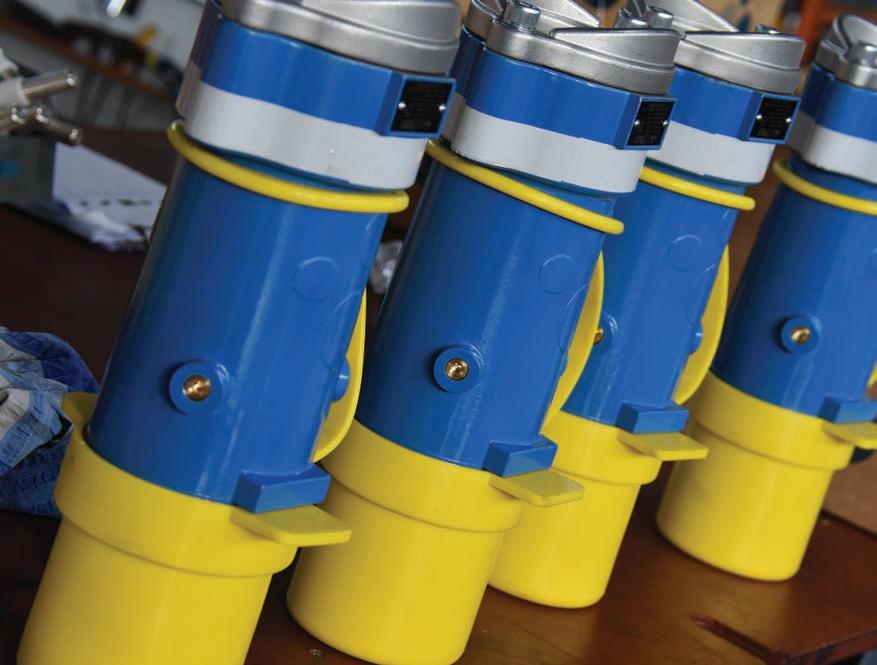
AUSTIN ENGINEERING HAS BECOME A PROMINENT NAME IN THE INTERNATIONAL MINING INDUSTRY FOR ITS INSPIRED ENGINEERING SOLUTIONS AND SERVICES.
Austin Engineering is driving innovation in the underground mining industry with its advanced truck bodies and tyre handlers.
The company’s latest offerings aim to enhance safety, efficiency, and cost-effectiveness, reinforcing its position as an esteemed provider of mining equipment.
Austin Engineering chief executive officer David Singleton said the company is dedicated to delivering high-tech, custom-designed products that cater to the specific needs of mining operations worldwide.
“Each of our truck trays are custom designed to suit particular sites, payload requirements, and other applications, ensuring customers get the very best out of their equipment,” Singleton said.
The JEC underground truck tray is one of the standout products in Austin’s range.
Designed with a curved structure, the JEC tray ensures safe ore transport while minimising material hang-up. Its adaptability allows the tray to be mounted on any underground truck chassis using hoist and pivot pins.
The tray incorporates several key features, including solid impact plates and curved leading edges for impact resistance, shallow angular transitions to reduce carryback build up and reinforced areas for structural protection.
Development of Austin’s underground truck bodies dates back to 2010 when a major mining client approached the original equipment manufacturer with issues related to significant carryback.
The presence of wet material was impacting their overall payload
capabilities, and the client needed a solution.
Austin’s engineering teams collaborated closely with the miner, addressing challenges such as high material impact, abrasion from minimal blasting practices, and confined space risks.
The resulting tray design offered solutions to these issues, including improved carryback reduction, increased wear resistance, and enhanced operational efficiency.
“The JEC underground truck body design was a result of having worked collaboratively with our client to provide a solution for a particular problem,” Singleton said.
“This has enabled our client to achieve continuous improvement and deliver the lowest ‘cost per tonne’ solution for their operations.”
In addition to its truck bodies, Austin Engineering has developed a range of tyre handlers for both surface and underground applications. These tyre handlers have contributed to the development and evolution of today’s dual-arm tyre handler industry standard, which dates back to the 1990s.
The company’s dual and threearm tyre handlers, with between 2500–10,000kg capacities, are fully hydraulically controlled. This feature can deliver variable force and enables precise control when moving the tyre handler.
Austin’s dual-arm tyre handler is a cost-effective option designed for versatility across the entire tyre and rim spectrum and are fully adaptable to loaders, telehandlers and tool carriers.
The dual-arm tyre handler offers features such as body and pad rotation, side shift capabilities, and a quick

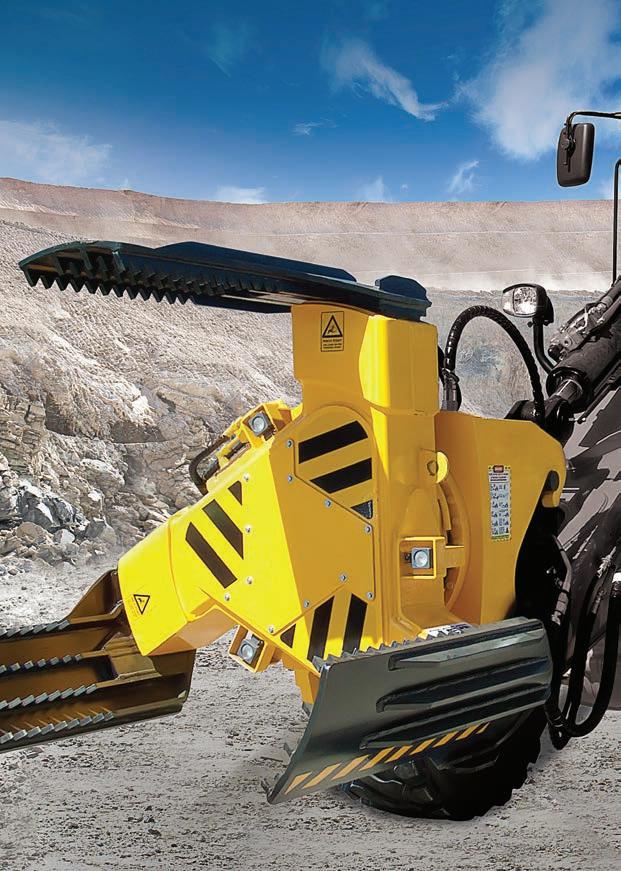
hitch for added convenience. Optional accessories like crane jibs and fork frames further enhance the tyre handler’s functionality.
The JEC T3 three-arm tyre handler is in a league of its own when dealing with confined spaces. It has a 30° slew capability for precise alignment, fully adjustable clamp arms, and safety lock valves.
Austin designed the JEC T3 tyre handler in response to a serious accident in 2010 involving a tyre change on an underground loader in the Goldfields region of Western Australia. This highlighted the risks associated with traditional tyre handling methods.
Having effectively addressed these risks, with safety features including added protection from flying debris in case of a tyre explosion and the ability to compress the tyre sidewall without causing damage, the JEC T3 tyre handler is currently being successfully used in mines across Australia and internationally.
Austin provides customer support for the lifecycle of its products, including inspection, maintenance and
spare parts. The company also provides customer support for its Mainetrack asset management and wear monitoring system fitted to its trays and buckets.
Operating across four continents, Austin designs its products to meet the specific needs of different mine sites and commodities. Having this global experience results in efficient operations and a strong investment return for Austin customers.
Looking to the future, Austin is focusing on product design and innovation, particularly as the mining industry’s needs evolve.
The company is committed to creating sustainable solutions, which include reducing steel usage, increasing payload capacity and minimising carbon emissions.
“We firmly believe that this process will ultimately result in better products that will reduce impacts on the environment and support the transition to a more sustainable future,” Singleton said.
“While these represent challenges to the whole industry, they also offer opportunities to evolve the way we do business.” AM


MATRIX DESIGN AUSTRALIA IS EXPANDING ITS REACH ACROSS THE COUNTRY THROUGH THREE NEW DISTRIBUTION PARTNERS.
Safety has always been at the heart of Matrix Design Group, an international company that provides operations-friendly applications that meet the mining industry’s ever-changing regulations.
As part of its global expansion, Matrix founded its Australian branch in March 2022 to support the Australian and New Zealand markets with its leading safety technologies: the IntelliZone proximity detection system (PDS) and OmniPro Vision AI visual artificial intelligence collision avoidance system.
Matrix’s new Australian distributors are further aiding this reach.
In 2016, Matrix formed a strategic partnership with Monitech Mine Monitoring Systems, which saw Monitech become the sole South African distributor of IntelliZone.
“We saw what Matrix did in South Africa with a distributor, and it worked really well,” Matrix Design Australia and New Zealand general manager Pieter De Klerk told Australian Mining.
“The success of our relationship with Monitech in South Africa really helped establish the business model we
like-minded engineering companies with strong values and first-class technical capabilities, who are highly customer focused.”
After considering several options, Matrix chose Specialised Engineering Technologies (SET) as its New South Wales distributor, Cap Coast Engineering Services (CCES) as its Queensland distributor, and Nolara Automation Solutions as its distributor in Victoria and South Australia.
When a distributor sells and delivers Matrix’s solutions to a mine site, they use their local experience and understanding of working with large original equipment manufacturers to help customers understand specific Matrix applications.
“Matrix Australia started two years ago but the company has been in the Australian market since 2018, so the distributors knew about Matrix’s products by working on the mines and seeing trials take place,” De Klerk said.

“Once we officially partnered with our distributors, we jumped straight into the technology, which they picked up very quickly.”
Through this training, SET, CCES and Nolara learned best practices for installation, various software
many adjustments for fine-tuning to the customer’s needs. When the team needs additional support, Matrix Design Australia is at their disposal.
“If you take the three distributors and the Matrix employees in Australia, we probably have 400–500 years of combined experience in underground mining,” De Klerk said.
SET
SET general manager Jacob Brown said SET and Matrix have had a close working relationship for over 12 months.
“Since becoming involved with Matrix, I’ve been extremely impressed with the company’s international business structure,” Brown told Australian Mining. “Matrix has key


“They are very supportive. Whenever we need help, they’re always there to pick up the phone and respond to emails within a quick timeframe, which makes our job as distributors easier.”
SET distributes both IntelliZone and OmniPro. IntelliZone is designed for use on various types of underground mobile equipment, allowing users to create customisable caution, shutdown and operator zones.
It has been fully IECEx-certified for underground coal in Australia since 2018.
Brown first heard about IntelliZone while working as an electrical engineering manager across multiple underground coal mines in NSW.
“PDS has been discussed over the years, but there was always a sense of uncertainty about reliability and how these systems would be practically implemented,” he said.
“I attended my first IntelliZone presentation at a mine in Narrabri in early 2023 and the feature that stood out to me was the patented SharpZone technology and its ability to shape the zones.
“The SharpZone technology is a game changer and what sets the Matrix
product above competitors who utilise basic bubble zone technology.”
IntelliZone detects workers in lowvisibility or obscured line-of-sight locations and zones, automatically extending or contracting based on mobile equipment direction and speed.
“The SharpZone technology provided SET with the confidence that the product could be successfully implemented in a reliable and practical way as it allows people to stand in safe positions while still completing their job,” Brown said.
IntelliZone is durable, easy to maintain and complies with EMESRT (Earth Moving Equipment Safety Round Table) levels 7 and 9.
“IntelliZone has an easy interface to work with, learn, configure, change and commission,” Brown said. “Everything about it is well designed and set out.
“The solution’s componentry is sent to Australia from the US, but all the IntelliZone enclosures and kits get manufactured and assembled locally in Australia.
“Matrix has a local Queensland warehouse stocked of kits and spare parts that are easy to access. This means
we aren’t relying on shipments coming from overseas.”
SET is currently implementing IntelliZone at seven NSW mines, all of which have different machines, operational challenges and mining techniques.
“With IntelliZone, you can customise it to suit each mining application,” Brown said.
“We will set up a particular set of zones and configuration files for one mine, which will work perfectly for them. Then we go and adjust it for the next mine because they might have a different operating technique which requires slightly different safe standing zones.
“That’s the biggest advantage with this solution.”
Established in 2021, CCES offers engineering solutions across a range of disciplines, including proximity detection and collision avoidance.
CCES first encountered IntelliZone in 2017.
“I first met Wes Chitwood, Matrix vice president of international operations and the US Matrix team when they came to a mine I was working at in a technology role,” CCES owner and director Loz Hemmings said.
“The IntelliZone system was demonstrated in an office environment and although it ticked all the boxes for me and my project, the appetite at the time wasn’t there for the company in terms of a PDS solution.
“Following my departure from the company, the creation of CCES and having known De Klerk for many years, we started having conversations about how the two businesses could complement each other.”
It was the ease of use, repeatability and software-based structures in IntelliZone and OmniPro that made CCES want to represent Matrix in Queensland.
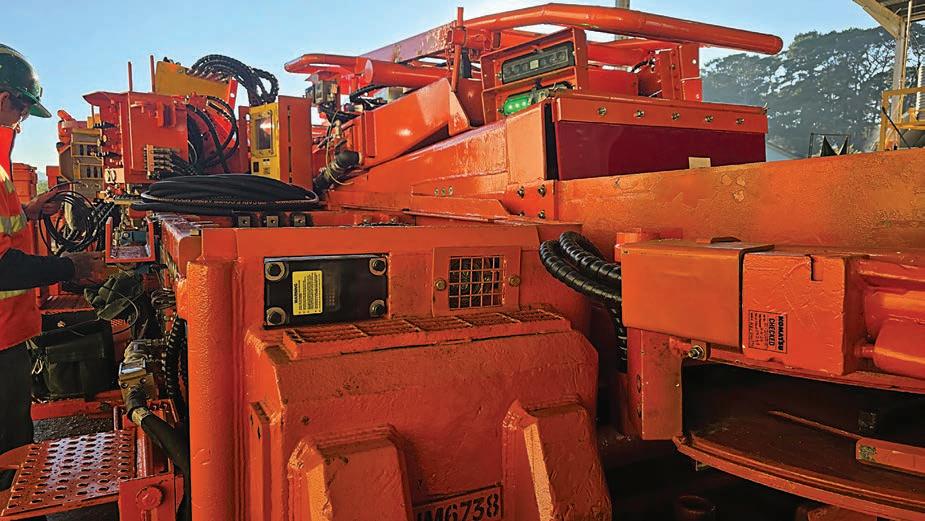
“A core selling point for me is that we want to give a customer consistency and reliability with the solutions we provide, and the Matrix systems fit this mould,” Hemmings said.
Through CCES, interest for Matrix’s solutions is increasing, with enquiries coming from several mine sites and active demonstrations taking place.
“I am excited to see what the future brings with Matrix’s greater presence in Australia and the way the system can evolve as it embeds itself into the Australian mining industry,” Hemmings said.
Backed by more than 15 years in the mining industry, Brendan Nolan founded Nolara Automation Solutions in 2021.
The company is dedicated to bringing automation to big and small businesses. A way in which Nolara does this is by distributing OmniPro across Victoria and South Australia.
“The Matrix values and goals align with those of Nolara,” Nolan said. “Matrix’s products are focused on improving safety in the workplace, which is the most vital application for automation.”
OmniPro uses visual AI technology to immediately detect personnel or objects moving in the projected travel path of mobile equipment, even in lowlight and all-weather conditions.
Like IntelliZone, OmniPro creates zones within the view of the camera that can alert the operator if someone is close to the machine. These zones can be customised to meet specific needs.
Again, like IntelliZone, OmniPro generates caution zones in yellow and alert zones in red. OmniPro also minimises nuisance alerts that often desensitise workers to alarms and operates without the need for personal wearable devices or tags. The technology can identify individuals in any posture.
“OmniPro brings cutting-edge AI technology into practical application for increasing safety of people around machinery,” Nolan said.
“At Nolara we are focused on building solutions through automation, and OmniPro is a central building block for applications that keep people safe from harm.”
With distributors locked in on Australia’s east coast, Matrix is looking to further expand in Western Australia and the Northern Territory in the near future.
“We’re also doing a lot of work in New Zealand and there is a lot of interest in Papua New Guinea, so the plan is to continue expanding in those areas,” De Klerk said.
Backed by experience, intelligence and now three Australian distributors, Matrix provides award-winning safety solutions that speak for themselves.
CAPS
COMPRESSORS
BACKED BY OVER FOUR DECADES OF EXPERIENCE, CAPS AUSTRALIA IS DELIVERING THE NEXT GENERATION OF AIR COMPRESSORS.
The Australian mining sector has long had a focus on keeping its operations efficient. To achieve this goal, emphasis must be placed on the machinery being suited to the climatic conditions in which it operates.
Air compressors are a key part of supporting mining applications such as exploration drilling, maintenance, blasting and underground ventilation systems.
With more than four decades of experience, 10 Australian branches and 24–7 maintenance and emergency breakdown services, CAPS endeavours to lead the industry through its compressed air and power solutions and services.
As part of its efforts to provide those services, CAPS has been supplying Ingersoll Rand equipment since its conception. This long-founded partnership has recently led to CAPS joining the Ingersoll Rand family, giving CAPS the ability to increase its portfolio of products and continue to deliver its range of solutions.
“The air compressors from Ingersoll Rand have been proven to be durable and reliable, especially within the mining industry,” CAPS compressed air product manager Paolo Lazzari told Australian Mining.
Ingersoll Rand’s stable of compressors includes the M Series M160, a single-stage rotary screw air compressor that delivers a capacity of 918 cubic feet per minute at a maximum working pressure of 8.5 barg and 160-kilowatt nominal motor rating.
Key features of the M160 compressor include its motor, which operates at peak efficiency under full-load conditions to help ensure maximum energy savings, and its airend, which requires minimal maintenance.
Another feature that makes the compressor stand out in the market is its cooling air configuration, which sees the cooling air flow from side-to-side, rather than coming in from the side and being discharged from the top.
“You don’t want the hot cooling air to recirculate back into the compressor, causing it to overheat and operate inefficiently,” Lazzari said. “The Ingersoll Rand cooling system keeps it at optimal performance temperature.”
Using its technical expertise in adapting standard compressors, CAPS tailors M160s to meet the needs of specific mining operations.
“We take a standard machine and modify it to suit the required application by configuring a 400volt motor to 1000 volts, the latter of which is standard voltage in the mining industry,” Lazzari said.
CAPS offers an underground miner’s pack that features a M160 compressor, a miner’s pack skid and frame, outdoor modifications, a high-dust filter, an incoming power isolator, marine windows, a VR2400S wet air receiver, and an automatic detection firesuppression system.
“We add marine windows to the controller to ensure the brains of the compressor do not fail under harsh conditions, as well as an incoming isolating switch to the power,” Lazzari said.
“Furthermore, we take the compressor and package it completely, with the air receivers, isolation valves and safety valves all certified for mining applications.
“Overall, we take a standard globalleading product and ensure it is fit for purpose for the harsh conditions of Australian mining applications.”
With so many services on offer, CAPS continues to be a customerfocused company dedicated to providing the best possible aftermarket support.
“CAPS already stocks approximately 98 per cent of the consumable parts for M160 compressors,” Lazzari said.
“We hold spare parts at our head office and at all our branches across Australia. Our service agreements further our support of customers,
with our qualified service technicians going out to site to perform the correct service intervals.”
The CAPS underground miner’s pack has become a tried-and-true solution to multiple mine sites in Western Australia, with one using the solution for more than 80,000 operating hours.
“They were so impressed with the longevity of their machine and the way it’s been operating, that they’ve made the pack a standard feature on the mine site,” Lazzari said.
“Whether they need compressed air on the surface or underground mining packs, we are the first port of call.” AM

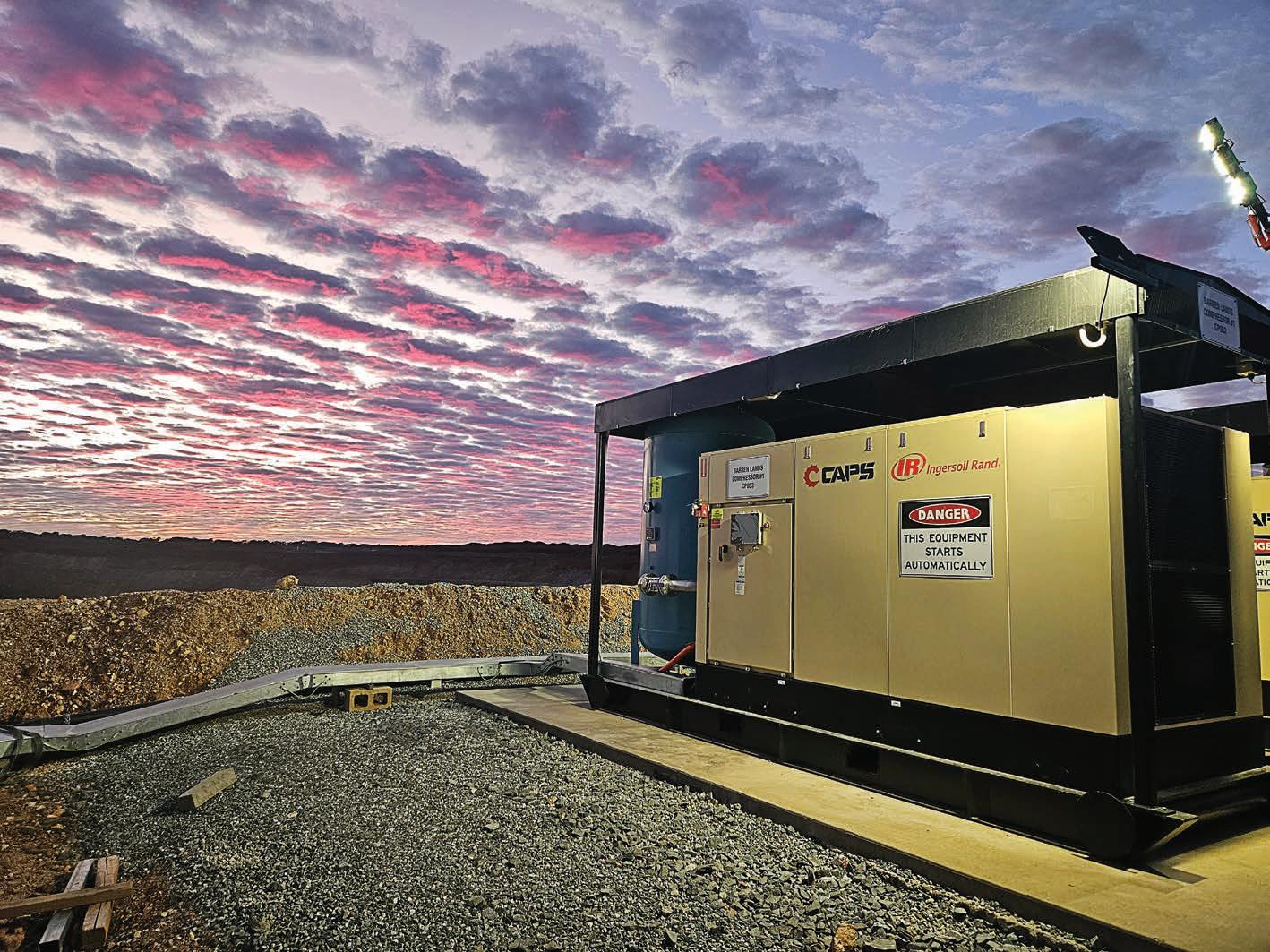



The Integrated Extraction Simulator (IES) is an innovative simulator that enables rapid evaluation of processing scenarios across the mineral extraction value chain to enhance plant productivity, optimise economic value, and minimise the environmental impacts of mining activity and mineral recovery.
By seamlessly integrating physics-based equipment models with machine learning, IES enables optimisation of all or part of an operation. Accessible via a web-based platform, it delivers operational insights that guide short, medium and long-term optimisation goals.
To learn more about IES and how it can support your operations today, please contact your local Orica representative, or visit orica.com/IES
To increase the profitability of underground mining operations, it’s essential to maximise mineral extraction while controlling costs. Significant among these costs is underground ventilation, which is critical to ensuring safe and efficient underground operations.
As Smart-VOD operations manager Stuart Twiss explained, there are ways to minimise ventilation costs.
“Historically, the capital expenditure (capex) of ventilation system components were a major part of total ventilation costs, leading to standardised inventory with limited fan size options,” Twiss said. “This often resulted in oversized fans running inefficiently, especially during shorter development stages of a drive.
“Ventilation requirements evolve as declines and drives are developed. Optimising ventilation starts with a good ventilation network designed by experts. The network should effectively and efficiently ventilate working areas without impacting operations.”
A ventilation on-demand (VOD) system overlays a well-designed ventilation network and helps to optimise the system.
“VOD provides a practical approachto energy savings by tailoring ventilation needs based on real-time demand by recognising that most mine drives are vacant for large portions of the working week,” Twiss said.
“In a drive with a dual-stage fan, both stages may be required during bogging, shotcreting and blast clearance processes, whereas a singlestage fan provides sufficient air for other activities.
“Whole-of-mine VOD systems involve substantial capex. However, incremental approaches targeting ‘lowhanging fruit’ can yield significant savings with minimal investment.”
Key components of ventilation ondemand systems:
• A method of controlling air delivery, such as a variable speed drive (VSD), variable output fan, dual-stage fan, dual-speed fan or dampers
• A demand control signal, which is crucial for achieving energy savings, more so than the control method itself
• A monitoring and reporting system, which allows for continuous performance tracking to ensure the system operates efficiently
There are three main methods used to implement ventilation ondemand in the Australian mining industry.
The first is manual control, which commonly sees an operator on the surface manually controlling underground fans using a supervisory control and data acquisition (SCADA) system.
The second method is schedule-based control, where the shift work schedule is entered into scheduling software that controls underground fans using a SCADA system.
The third method of implementing VOD is automatic control, in which fans are controlled based on vehicles in a ventilation zone, which can include other factors such as air quality.

Twiss said ventilation energy costs make up a large portion of a mine’s total expenses and can significantly impact key financial metrics such as the all-in sustaining cost (AISC).

SYSTEM INVOLVES AN INCREMENTAL APPROACH TO ENERGY SAVINGS.
“A mid-sized gold mine deploying ventilation on-demand in the 10 most active areas on-site can reduce AISC by 10 per cent, significantly enhancing profitability,” he said.
A recent addition to the VOD arena is Smart-VOD’s VOD-as-a-service.
“In this case VOD can be delivered incrementally and without capex,” Twiss said. “VOD-as-a-service can be implemented in a single working area, or across several working areas in a mine.
“The system can additionally control primary ventilation fans for further savings, speed-up exhaust of blast gases and allow accelerated return to mining operations after a blast.
“Offering a detailed dashboard, Smart-VOD displays system status in real-time, along with savings and vehicle location information.”
By targeting ‘low-hanging fruit’ in ventilation on-demand implementation, miners can yield substantial energy savings without significant upfront costs.
“Smart-VOD offers an adaptable and scalable ventilation solution that enables mines to achieve immediate and impactful cost reductions, ultimately improving sustainability and profitability,” Twiss said. AM

Optimising Sustainable Mining Operations: Your Partner for Shutdowns, Logistics and Maintenance

Scan the QR code to find out more!

Empowering Industries. Building Futures. One lift at a time.
HEXAGON IS INTRODUCING ITS UNDERGROUND COLLISION AVOIDANCE SYSTEM AS PART OF ITS EFFORTS TO INCREASE SAFETY IN THE INDUSTRY.
As mining goes deeper and deeper underground, the need for smarter and more robust safety measures continues to increase.
Hexagon, a leading digital reality solutions provider, understands this situation well. The company’s approach to mine safety – ‘everyone gets home safely’ – has seen it develop some of the premier solutions in the mining sector.
But Hexagon isn’t content to rest on its laurels. The company is continuously developing new technology to make mining even safer, and its customers will soon be treated to a new kind of technology in underground safety in the Hexagon Underground Collision Avoidance System (UG CAS), providing 360° operator awareness for surrounding vehicles and equipment.
“Safety is a core pillar at Hexagon, and we are always working on innovating and improving in the mining safety solutions space,” Hexagon head of product – underground Mateus Quintela told Australian Mining
“Right now, there is a huge opportunity to increase safety in the underground mining market. UG CAS was developed to enhance safety and efficiency in mining operations, even in the most challenging environments.”
While UG CAS deployments are still in progress, Hexagon is looking forward to sharing success stories about the system soon.
“Hexagon is well established as an expert in mining safety, with over 60,000 Hexagon CAS installed in surface mines worldwide,” he said. “Now we’re bringing our extensive safety expertise underground.”
Hexagon’s UG CAS works by providing vehicle operators with 360° awareness via non-intrusive cabin display units when travelling at any speed and in all conditions.
Operators see other vehicles’ locations and where they are heading. The system incorporates path prediction and leverages auditory and vibration alarms that alert drivers to collision risks.
This innovative technology is easy to install and quick to configure.
UG CAS isn’t the only new Hexagon solution turning heads in the industry. The company acquired HARD-LINE in July 2023 in a bid to strengthen its mine safety, automation and underground offerings.
The acquisition added more than 28 years of global experience to Hexagon’s already substantial pedigree in the industry.

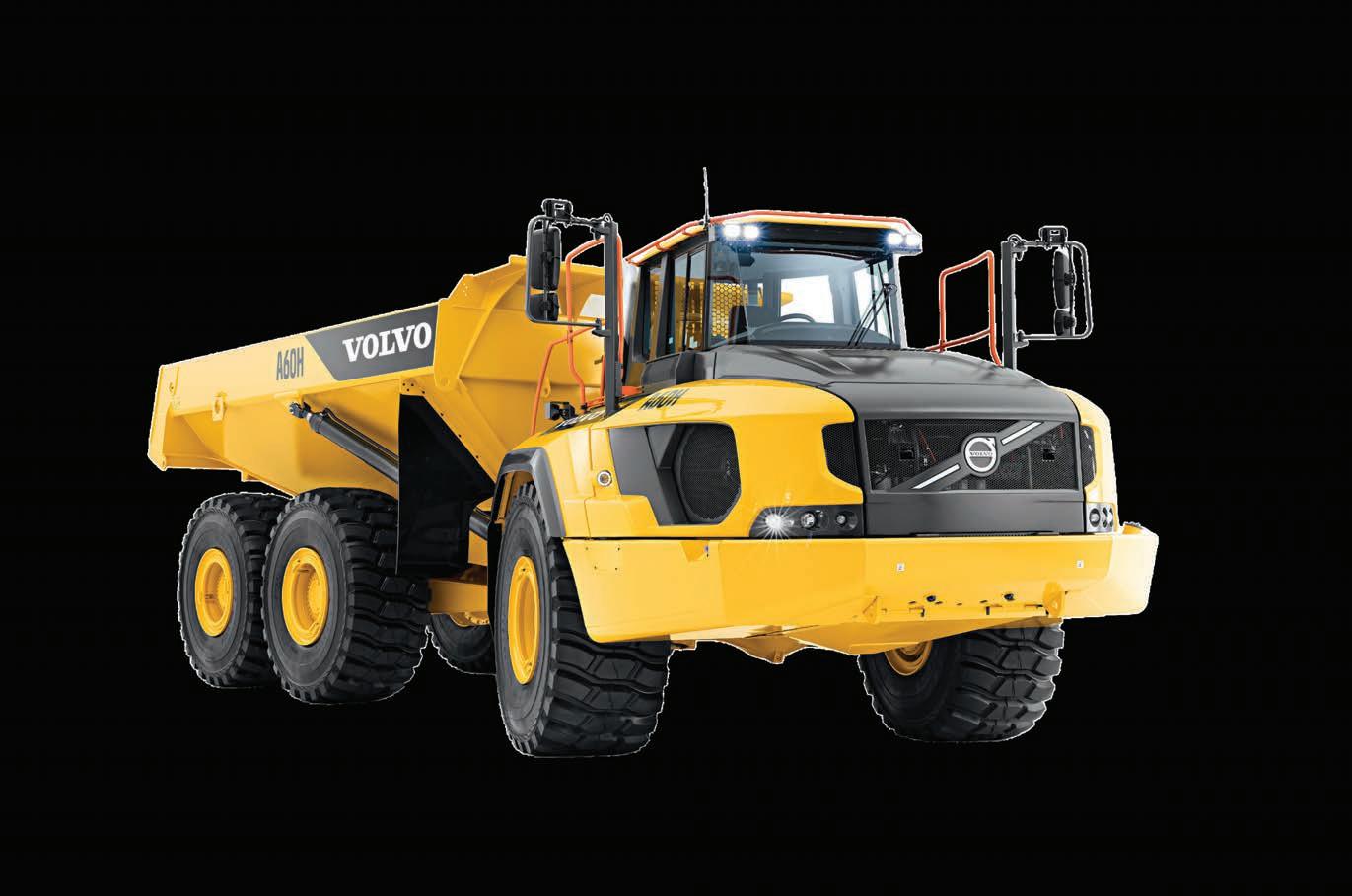

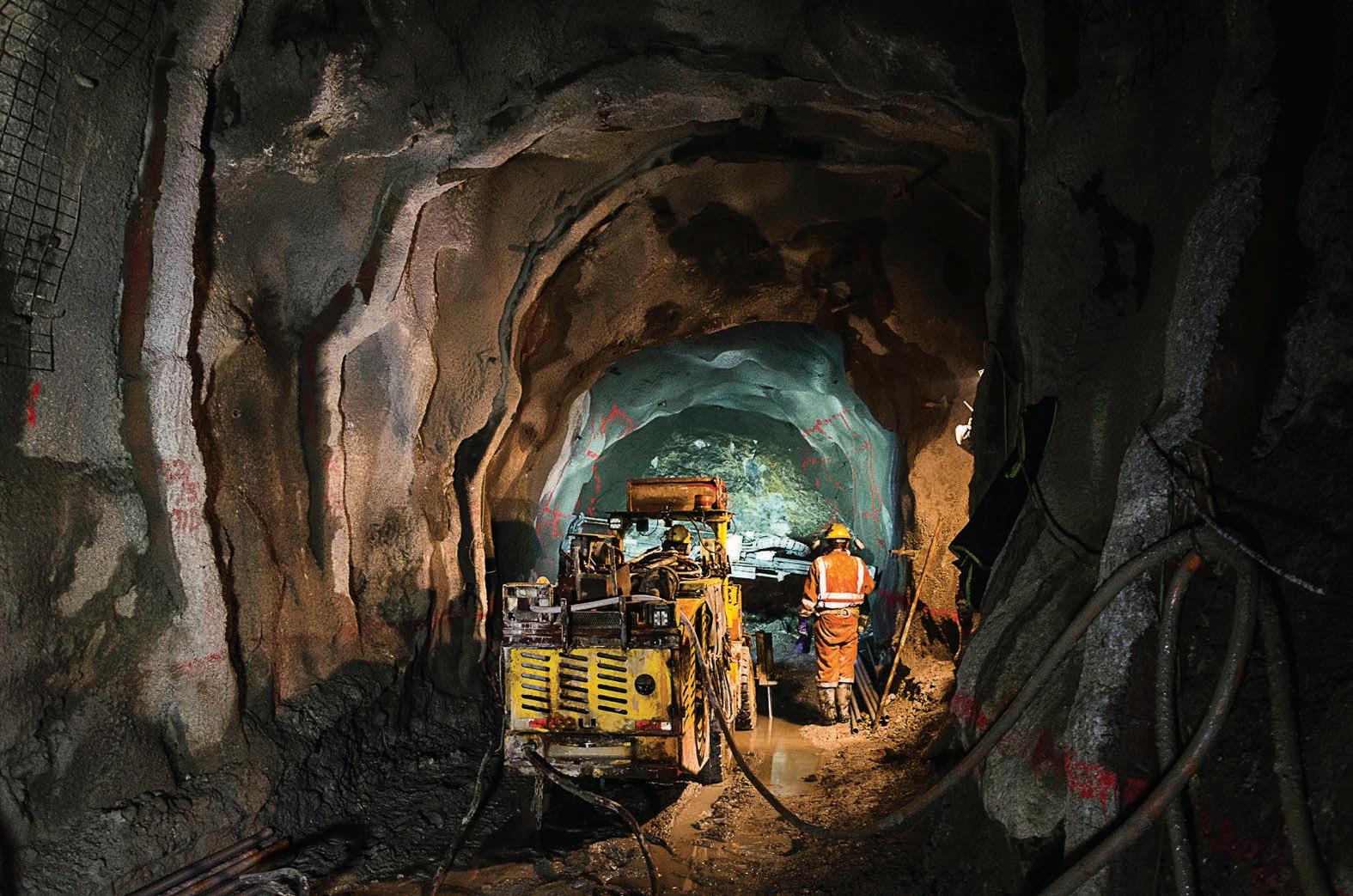


55-ton payload
Move more material in less time
6x6 traction Unstoppable in tough terrain
Haul Assist
Optimise your hauls with real-time data
VOLVO A40G • 24m³ • 39,000kg • 347kW
Spacious cab
Robust design
Fast cycle times

Comfortable and ergonomic design
Built for the toughest quarry conditions


VOLVO A45G
• 25.1m³
• 41,000kg
• 347kW

Get more done in less time


VOLVO A60H
• 33.6m³
• 55,000kg
• 492kW












Centennial Coal faced a challenge at its Springvale mine in New South Wales: parts were wearing out faster than expected.
Springvale uses longwall mining methods to extract coal, but an expansion into new territory had brought with it harder lithology, meaning harder wear on critical parts and equipment.
“We really went through hell on the first block,” Springvale mechanical engineering superintendent – production Hayden Ticehurst told Australian Mining. “Our usual maintenance program didn’t cut it, and we needed data quickly.”
That’s when the coal miner contacted mining equipment solutions specialist Komatsu.
Starting with the implementation of a simple tool for gathering data on part usage, the team at Komatsu quickly realised the mine would need a more holistic solution to keep Springvale on track.
Enter the company’s asset management program (AMP) which, according to Komatsu’s reliability engineer Rob Hancock, allows Springvale to look at the intricacies of its operations like never before.
“We gather machine metrics, such as tonnes produced, from a customer’s machine and combine it with data gathered from tailored maintenance and production inspections on site,” Hancock told Australian Mining tracking each piece of equipment and its parts, we can generate a HART (health and remaining time) report that predicts wear.


“We then use that data to predict any unforeseen problems the mine may face and schedule maintenance and part replacement accordingly, reducing unplanned breakdowns.”
Komatsu’s AMP takes every aspect of the mining chain into consideration, helping Springvale improve equipment availability, reduce unplanned downtime, and mobilise actively, rather than reactively, to the wear of parts.
Komatsu field service coordinator Craig Roberts was on-site to implement the AMP. He said a key pillar of the AMP’s success comes from building up a site-specific resource.
“The AMP builds a history based on conditions,” Roberts told Australian Mining. “It’s not a history of what wear Komatsu might get out of a certain part nation-wide; it’s about giving the
customer tailored information they can use to plan maintenance, overhaul costs, and plan for the future.
“It has been a massive step-change to take Springvale’s asset management from an excel spreadsheet to a fully realised mobile rounds platform that’s set for the service engineer.
“The whole process has since been streamlined with data able to be input into tablets underground and uploaded as soon as they reconnect with Wi-Fi, allowing greatly improved timeliness in getting reports to the customer.”
As Komatsu ramps up the AMP’s scope, it has the potential to integrate data from a range of metrics like vibration, oil, and digitised work procedures.

An embedded service engineer is now also on-site three days a week to help Springvale make the most of its new world of data.
“That ongoing support is there to assist Springvale with every aspect of its asset management,” Roberts said.
“Clear communication lines in place help Springvale and Komatsu work together to optimise the mine’s parts and maintenance planning into the future.”
Before the implementation of the AMP, Ticehurst said Springvale wasn’t making full use of its service engineers.
“If you send your service engineers underground for tasks like changing oil and parts, you’re missing out on the opportunity to break the mould of predictive maintenance,” he said.
“By treating our original equipment manufacturer (OEM) engineers like the experts – and not just labour hire –we are leaning on their knowledge and we are able to get results we’ve never seen before.
“By approaching the AMP collaboratively with Komatsu, we have gone from a spreadsheet to a fully-fledged data collection and consultation process.”
Looking to the future, the relationship between Springvale and Komatsu is set to go from strength to strength as it continues to optimise the miner’s operations.
“It takes work to build up a data history and put a plan in place to use it and the team effectively,” Ticehurst said. “But the results are so worth it.” AM




CHOOSING THE RIGHT SUPPORT VEHICLE FOR AN UNDERGROUND MINE CAN SIGNIFICANTLY INCREASE THE PRODUCTIVITY OF THE FLEET AND REDUCE OPERATIONAL COSTS.
Elphinstone’s new range of E15 underground support vehicles is designed to thrive in the harshest underground hard rock mining environments.
The E15 is a highly configurable, 15-tonne nominal base platform, comprising an agitator (7m3), delivery truck, fuel and lube truck, and water tank for dust suppression.
The E15 Delivery is the second model in the series to be released, adding another application to the existing Elphinstone E10 (formerly WR810) and rapidly expanding the E15 support fleet with new configurations in development.
“We are expanding the range of applications to meet the underground support equipment requirements of our customers,” Elphinstone global sales and marketing manager Tim Mitchell said.
With a payload of 16,500kg, the E15 Delivery ensures parts, components, equipment, and maintenance personnel are transported safely and securely throughout the mine.

The 4.5m x 2.5m deck features a steel tread plate floor bordered by multiple tie-down points and provision for ratchet load binders. Dual-sided threepoint access with high-visibility green handrails is enhanced with a cleverly designed removable guard rail system and onboard storage.
Other features include five storage compartments and a hand wash dispenser.
The Hiab X-HiDuo 092 crane features a rated lifting capacity of 8.8m and a 7.7m outreach, providing a reliable solution for day-to-day heavy lifting.
“Operated by manual lever control or wireless joystick remote, the operator can manoeuvre loads from a distance with built-in intelligence and automatic speed control for safe and effective load handling,” Mitchell said.
Safety features include emergency crane stops located on the manual control station, a wireless joystick remote and a programmed exclusion zone to prevent lifting over the operator cabin.
The stabiliser legs manually pivot and extend, featuring levelling sensors and easy pack-up for safe transit.
An A-frame front axle suspension combined with the oscillating hitch and air-suspended seats delivers a high level of machine comfort to the operator and passengers.
An optional feature of the E15 is the front and rear hydraulic jacks. The front jacks operate with a park function to enable the operator to safely exit the cabin with the engine operating.
The rear jacks are used to level or lift the machine. All jacks can lift the machine off the ground for changing tyres.
The intelligent electronic speed control utilises a high-capacity electromagnetic driveline retarder, engine speed and the correct transmission gear to control speed while descending into the mine, hence reducing wear and tear on the service breaks, parts and components.
All service points are conveniently located at ground level for servicing.
Downtime during maintenance is reduced markedly on the E15 due to clever engineering and design features, incorporated with service personnel in mind.
Quick change air filters and 500hour oil service intervals reduce downtime and keep machines in operation longer. A centralised onboard service centre includes fast fill, evacuation, and fluid sample points for analysis.
“Product support, parts and components are readily available through Elphinstone and our authorised Caterpillar dealers,” Mitchell said.
The C7.1 ACERT Tier 4 final engine arrangement is optional, offering 151 kilowatts (kW) of power and adhering to European Union Stage V exhaust emission standards
WITH A PAYLOAD OF 16,500KG, PARTS, COMPONENTS, EQUIPMENT, AND MAINTENANCE PERSONNEL ARE TRANSPORTED SAFELY THROUGHOUT THE MINE.
The C7.1 ACERT Tier 3 engine arrangement rated at 168kW is the standard option for less stringent emission regulations. Matched to the engine is a Cat five-speed (three-speed reverse) transmission fitted with a lockup torque converter.
The on-board warning and protection system continuously checks all critical machine functions for early warning and fast fault finding, recorded for analysis.
Safety is a priority
Safety is one of the most important aspects of any piece of machinery employed in the mining world.
“The majority of key safety items on the E15 are mandatory base machine options,” Mitchell said.
Safety features include firewalls and heatshields, machine interlocks, and centralised isolation points. Optional features include an integrated fire suppression system and metallic fuel water separators made from a nonflammable material.
Emergency stops are fitted as standard inside the cabin, at ground level on the front left-hand side of the machine and located near the access ladders on the left and right hand side of the deck.

clear 180-degree view, and a dial controller for the retarder, speed and implement controls.
At 2.4m high, the low-profile frontmounted operator cabin features three-person seating, climatecontrolled air conditioning, ergonomic central driving position with a
Operator comfort and convenience are further enhanced with an aircooled compartment for lunchbox storage, cupholders and smartphone charging ports.
Integrated into the operator station is ROPS/FOPS roll-over and falling object protection for the operator
in compliance with Australian ISO standards.
The driver’s seat is a ‘T’ seat with air suspension, and the crew seats are a standard ‘T’ optional seat with air suspension.
Ideal for training purposes, the seating arrangement allows a complete crew to travel collectively rather than deploying an additional light vehicle for personnel transport.
Ergonomically designed machine controls are located nearby for the operator to control the machine functions with minimal effort. The result is greater concentration on vehicle operation, with reduced operator fatigue.
The oscillating hitch provides superior operator comfort, four-wheel ground contact and reduced wear on the hitch and steering components.

“The E15’s oscillating platform prevents the transfer of rough conditions from the rear frame into the front frame,” Mitchell said.
“The benefit is a far superior ride by allowing the rear frame to oscillate and reduce stress on the hitch and frames.”
With E15 Delivery and flat decks in production, the Elphinstone team is confident the E15 range will continue to grow in popularity among customers both in Australia and overseas.
“We’re looking forward to exhibiting on stand 13751 at MINExpo in Las Vegas this September,” Mitchell said.
“We’ll be displaying an E15 Delivery (with wireless remote crane and flat deck) and a MED210 mine extraction device used for extracting bogged or buried machinery underground.”
MINExpo will be held from September 20–24 in Las Vegas. AM

MINERAL PRODUCTION WAS ON THE UP FOR VARIOUS MINERS THROUGHOUT THE JUNE QUARTER, WITH SUBSTANTIAL RECORDS ACHIEVED.
Australian miners continued their solid run for the second quarter of 2024, with some achieving record results.
Commodities such as copper, lithium and iron ore saw an uptick, while many major projects remained on track for completion.
Australian Mining takes a look at some of the highlights.
BHP’s copper business continued to thrive, with the Big Australian recording a nine per cent increase in copper production across its assets in the 2023–24 financial year (FY24).
The result was largely driven by record production at the Spence and Carrapateena mines in Chile and South Australia respectively, with Spence producing 255,000 tonnes (t) and Carrapateena producing 322,000t.
BHP’s Escondida mine in Chile, the world’s largest producer of copper concentrates and cathodes, produced approximately 1.13 million tonnes (Mt) of copper during FY24, its highest production in four years.
“We finished the year with a strong fourth quarter, achieving several
production records and we are meeting current production and unit cost guidance for all commodities,” BHP chief executive officer (CEO) Mike Henry said.
BHP’s Western Australia Iron Ore (WAIO) business also demonstrated
on the back of ongoing incremental improvements along its supply chain as we progress toward our medium-term goal of increasing production to greater than 305Mtpa (million tonnes per annum),” Henry said.
Rio Tinto
Decarbonisation was highlighted by Rio Tinto CEO Jakob Stausholm as a key priority for the major miner.
Stausholm said the company’s operational performance continues
“Construction of the Simandou high grade iron ore project in Guinea is advancing at pace, the ramp up of the Oyu Tolgoi underground is on track and we are set to achieve first production from the Rincon starter plant by the end of the year.”
Rio installed carbon-free aluminium smelting cells at its Arvida smelter in Québec, Canada and is investing in a research and development facility to test a low-carbon ironmaking process in WA.

Mineral Resources (MinRes) achieved higher than expected shipments of lithium and a steep increase in prices for the key battery material during FY24.
Total MinRes production volumes in FY24 rose by nine per cent year-on-year to 269Mt, despite a 12 per cent quarter-on-quarter dip in production, which was attributed to reduced mine development at Wodgina and Mt Marion in WA.
Despite this MinRes saw a significant jump in its annual lithium shipments from Wodgina and Mt Marion, with year-on-year increases of 41 per cent and 46 per cent, respectively.
Wodgina produced 212,000 dry metric tonnes (dmt) of spodumene concentrate, while Mount Marion’s production hit 218,000dmt, both aligning with FY24 guidance. Bald Hill also reported a 19 per cent increase in spodumene concentrate production over the previous quarter.
Total iron ore shipments for FY24 were within guidance at 18.1 million wet metric tonnes.
MinRes’ Onslow Iron project in WA achieved several milestones in the June quarter, including the sale of a 49 per cent interest in the project’s dedicated haul road to Morgan Stanley Infrastructure Partners for $1.3 billion.

Fortescue shipped 53.7Mt of iron ore during the June quarter, representing a 10 per cent increase on the same quarter in 2023.
The increase was a record for the iron ore giant, bringing its total shipments for FY24 to 191.6Mt.
Total ore mined across Fortescue’s operations stood at 216.9Mt for the year, while the total processed reached 189.9Mt.
Fortescue Metals CEO Dino Otranto said the milestone marked an outstanding quarter by the team,
achievement and shows a 28 per cent improvement from the previous year,” Otranto said.
Fortescue Energy CEO Mark Hutchinson confirmed hydrogen remains a key pillar of the company moving forward.
“As we lead the world in industrial decarbonisation, we remain steadfast in our commitment to green hydrogen,” Hutchinson said. “Our financial discipline will ensure that we focus hard
only on those projects that are economic
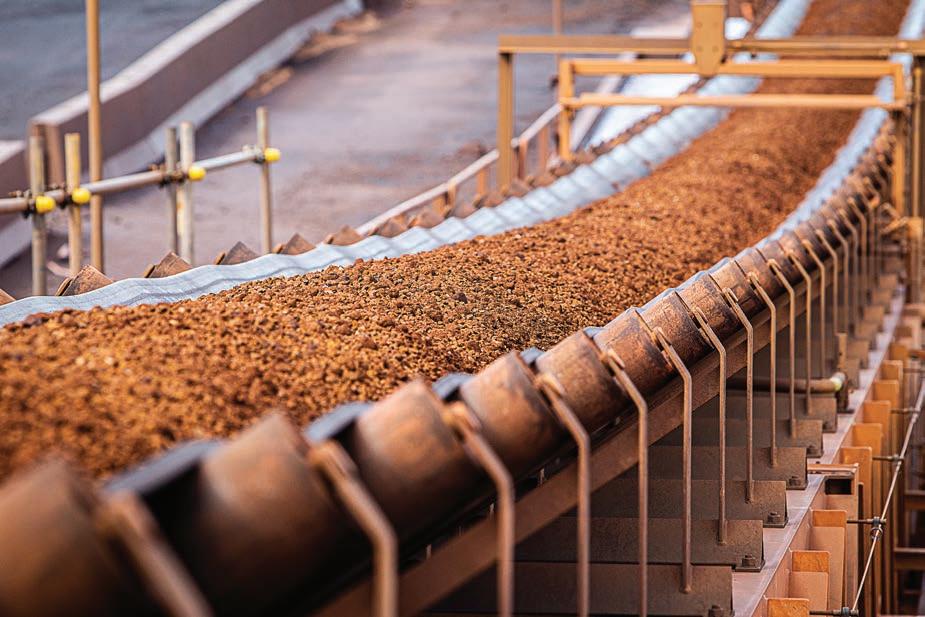
plans to position itself as a more clearly defined entity.
“Looking ahead to FY25, we’re seeking to achieve record shipments with guidance of 190–200Mt,” he said.
“As part of bringing together Metals and Energy into One Fortescue, we are simplifying our structure and removing duplication that will ensure Fortescue is lean, impactful and can move quickly to seize opportunities.”
Strong sales and continued portfolio transformation were the markers of a solid quarter for South32.
At the major’s Hillside Aluminium smelter in South Africa, production reached a record 720,000t in FY24, while the Cannington mine in Queensland saw a 10 per cent increase in payable zinc equivalent production, producing 285,200t.
“We delivered another quarter of improved operating performance, achieving sequentially higher volumes across the majority of our operations, and remain on track to achieve FY24 operating unit cost guidance,” South32 CEO Graham Kerr said.
“Our performance enabled us to capitalise on stronger commodity prices, lift sales volumes and release working capital, boosting cash generation in the quarter.”
South32 invested $US372 million of growth capital expenditure at its Hermosa project in Arizona.
“Construction and permitting are tracking to plan at the Taylor zinclead-silver deposit at Hermosa, the first phase of a regional-scale opportunity to supply commodities critical for the global energy transition,” Kerr said.
South32 is expected to finalise its sale of Illwarra Metallurgical Coal in NSW to an entity owned by Indonesian-based Golden Energy and Resources and Brisbane-based M Resources by the first quarter of FY25.

WHITEHAVEN SUCCESSFULLY COMPLETED THE TRANSITION OF ITS NEWLY ACQUIRED DAUNIA AND BLACKWATER COAL MINES IN QUEENSLAND.
Following Whitehaven’s successful acquisition of the Daunia and Blackwater coal mines in Queensland, Daunia produced 1.3Mt of run-of-mine (ROM) coal during the quarter.
The coal miner said production at Daunia was impacted by delays such as the time it took to transfer assigned rail paths from BHP, the previous owner of Daunia, to Whitehaven.
Pilbara Minerals
Despite the disruptions, Daunia produced 1Mt of saleable coal, with sales equalling 900,000t.
Blackwater welcomed a strong 3.6Mt in ROM coal production and 2.3Mt in sales, with Whitehaven progressing a potential sell down of about 20 per cent of the operation to global steel producers as part of a strategic joint venture.
“Transition and integration activities progressed smoothly during the first quarter of ownership, and
Strong revenue and record spodumene concentrate production were among the highlights for Pilbara Minerals in the June quarter.
The company produced a strong 226,200t of spodumene concentrate at a unit operating cost of less than $591/dmt, a 26 per cent increase from the previous quarter.
Pilbara Minerals credited the strong performance to the full utilisation of the P680 primary rejection facility at the Pilgangoora operation in Port Hedland, WA.
Ore mined in the quarter increased by 20 per cent to 1.84Mt compared to the prior quarter, while lithium processing recoveries increased to 72.2 per cent from the previous quarter’s 65.3 per cent.
“Improved recoveries were due to improved plant stability and run-time facilitated by the optimised performance of the primary rejection facility and the execution of a suite of initiatives including the use of mobile crushing and ore sorting,” Pilbara Minerals said.
The P680 and P1000 expansion projects remain on schedule and on budget, with the new P680 crushing and ore sorting facility achieving its first ore in the first week of July.
activities undertaken at Lynas Malaysia.
“During the June quarter, the ramp up of the Kalgoorlie facility continued and the first shipment of mixed rare earth carbonate was dispatched to Malaysia,” Lynas managing director and CEO Amanda Lacaze said.
“While production volumes remain low as processes are stabilised, the ramp up is proceeding in accordance with plan.”
A five-year mining services contract was awarded to Carey Mining at the Mt Weld operation, with the company removing waste material above the orebody and bringing a new fleet of equipment to the site.
The Mt Weld expansion project’s Stage 1 (concentrate dewatering) was completed, with commissioning having commenced. Stage 1 is expected to be completed by the end of September.
“Construction of Stage 2 continues to ramp up and construction of the tailings storage facility has commenced,” Lacaze said.
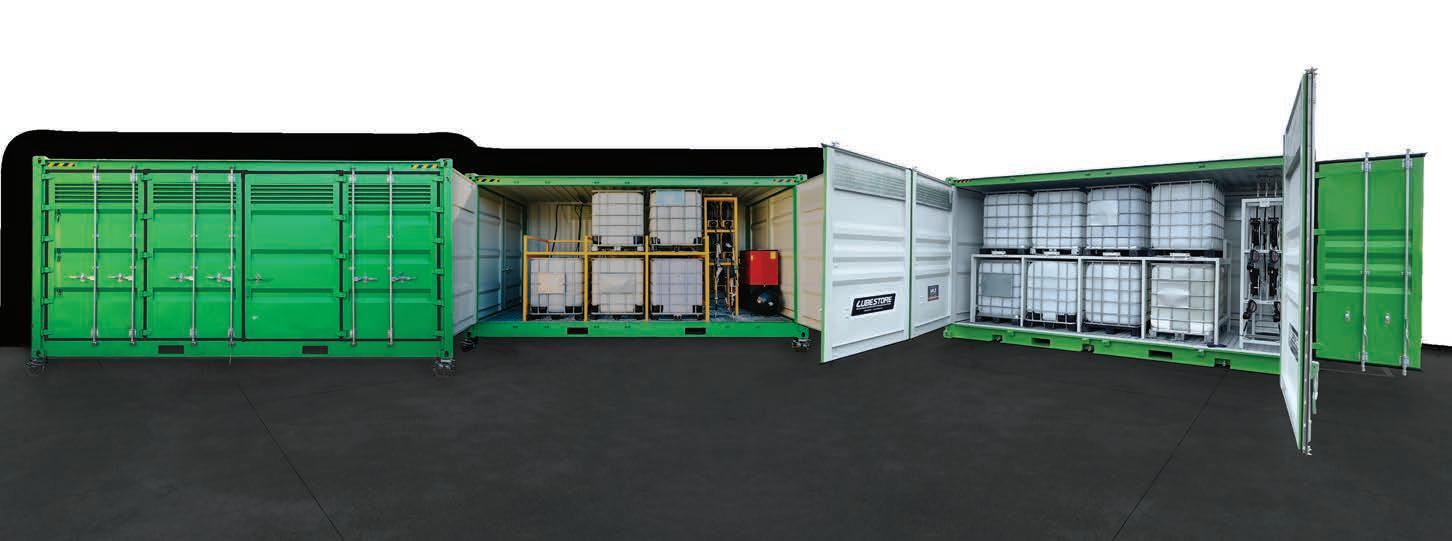
we are already seeing the benefits of diversification and exposure to the supply-constrained metallurgical coal market,” Whitehaven managing director and CEO Paul Flynn said.
Lynas Rare Earths
Lynas saw a decrease in production, with 2188t of total rare earth oxide and 1504t of neodymium and praseodymium produced in the June quarter.
The decrease from the previous
“Construction of Stage 2 (balance of plant) is now expected to be completed by the end of FY25. Commissioning activities for Stage 2 will progress concurrently with construction as individual circuits are completed.”
After facing tough conditions in the March quarter, Australia’s major miners have achieved several records across their operations and have plans in place to achieve an even stronger





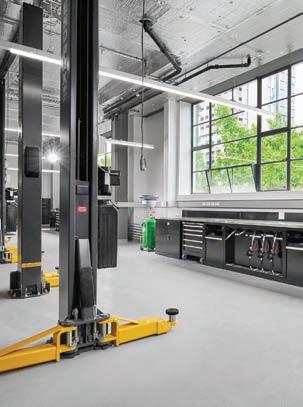

Environmental permits and approvals are key milestones mining companies must achieve before they can bring a new mine online.
And while operators must demonstrate compliance pre-mining, they also have an obligation to maintain their environmental standards during and after production.
To better position themselves during both pre-mining and production phases, miners are turning to technology to gather faster and more comprehensive environmental insights – and Dendra has become a key partner on this journey.
Through its RestorationOS solutions, Dendra deploys drone and remote sensing technologies to map and survey large areas of land. Artificial intelligence (AI) is then used to analyse and convert the data into actionable insights.
While ‘boots-on-ground’ surveys have been the traditional data capture method, regulators are increasingly understanding the advantages that remote-sensing alternatives can offer.
As more regulators have their ‘aha moment’ regarding the upside of AI and environmental technology, Dendra is working closely with its customers to
ensure their data capture puts them in the best position to expedite approvals and satisfy reporting requirements.
“We work with our clients to capture insights on their rehab to help them manage and meet their regulatory reporting needs,” Dendra Australia ecology manager Jason Webb told Australian Mining
“Then, as we enhance traditional survey methods with Dendra insights, we can slowly move towards fewer ground surveys and more remote sensing. As spatial ecology keeps evolving, it is increasingly being used in the industry.”
While Dendra’s technology is relatively new in the mining industry, the company’s footprint is rapidly expanding.

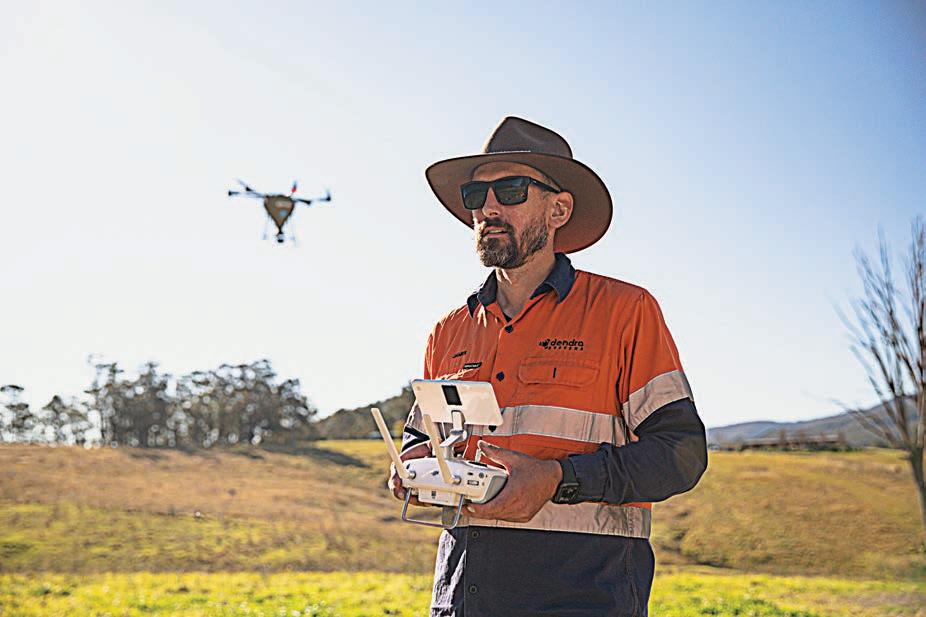
Dendra welcomed a record number of customers in 2023. This coincided with the company increasing its mapping capacity, which improved by a multiple of four across the 12 months, meaning more hectares can be surveyed more quickly.
Dendra has also evolved its aerial seeding technology to the point that it can spread up to 44 hectares a day of native seed mixes – a 10-fold increase in just a decade.
And there is further advancement to come, with research and development
“Our ecology-trained AI is getting faster, more accurate and more scalable, meaning we’ll be able to take on more clients over larger areas and deliver our solutions faster,” Webb said.
“As our scalability increases, our output will increase, further increasing the ability for spatial ecology to enhance traditional ground surveys in the mining industry.”
Enhancing traditional ground surveys with spatial ecology means Dendra’s technology and insights will become increasingly used in the industry and applied in environmental approvals for pre-mining and rehab.
submissions and traditional ground surveys, leading to more discussions on the best ways to incorporate remote sensing into biological surveys across Australia,” Webb said. “Bringing new technologies together with biological ground surveys gives new opportunities to progress rehab and mining towards better environmental outcomes and helping mine sites meet regulatory compliance.
“Species-level analysis and identification has been the main focus of Dendra’s work for the past few years. As we enhance ground surveys, we believe we can achieve an even stronger footprint and be integrated into many different types of flora surveys.”

In today’s mining industry, Webb said, ground surveys are supplemented by aerial surveys. But Dendra wants to “flip this around”.
“We want to get to a point where aerial surveys are enhanced by ground surveys, integrating the two approaches together,” he said. “This reduces time and people on ground, and it increases remote detection accuracy, because rather than doing a few subplots around the site as is done with traditional ground survey methods, we could survey and assess an entire mine.”
As it invests in more R&D and achieves further uptake and more regulatory exposure, Dendra is driving a new paradigm in ecosystem restoration and environmental management.
“It’s only a matter of time until regulators understand the gravity of Dendra’s faster, more scalable and more reliable environmental solutions.” AM


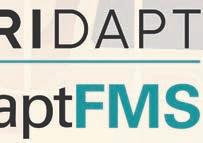

The ultimate digital fuel management and emissions tracking platform is good for the bottom line and the environment.


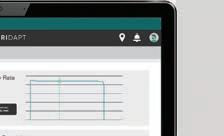

AdaptFMS manages over 30 billion litres of fuel annually for BHP, Rio Tinto, Pacific National and 150 more mining and rail operations worldwide.
From oil and diesel to emerging future fuels, AdaptFMS delivers transactional security and transparency across the entire fuel chain while documenting carbon footprints at the mine site.



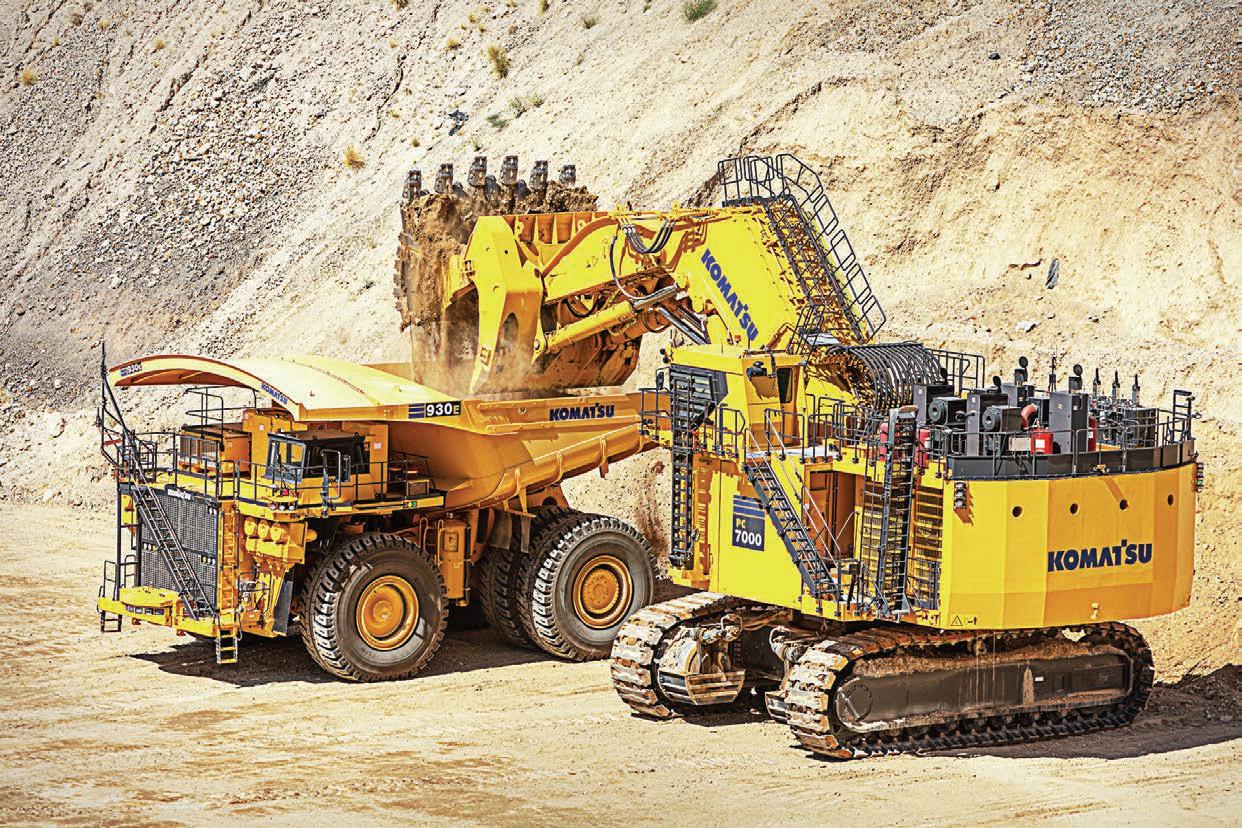
As a global giant in the development and supply of technology, equipment and services for the mining industry, Komatsu is well-placed to help the mining industry innovate into the future.
With a fleet of more than 750 autonomous haul trucks commissioned worldwide, Komatsu customers have hauled more than 10 billion metric tonnes of material and are adding to that milestone at a rate of over six million metric tonnes per day.
Additionally, 10 Komatsu autonomous trucks have achieved a benchmark of 100,000 autonomous hours each, a first in the mining industry.
Komatsu launched the FrontRunner autonomous haulage system (AHS) in 2008, marking the world’s first commercial application of an AHS.
In the years since, Komatsu has continued to innovate alongside customers to meet their evolving needs and offer tailored autonomous solutions to promote enhanced operations on a mine-by-mine basis.
Komatsu FrontRunner trucks run completely autonomously – they are not
remotely controlled – with a full truck fleet able to be monitored by a single controller located up to thousands of kilometres away.
Able to operate around-the-clock, 24-hours-a-day, seven-days-a-week, FrontRunner trucks deliver significant safety, productivity, reliability, performance and operational benefits to mine fleet owners.
Each truck incorporates a combination of vehicle controllers, precision GPS, an obstacle detection system (ODS) using radar and laser, and a wireless network system developed by Komatsu.
The mine’s central controller assigns required routes to each truck, whether overburden hauling or ore hauling.
Each loading tool is fitted with an integrated touch-screen computer showing the location, direction of movement and speed of all items of mobile plant within the FrontRunner fleet’s operations area.
As each truck approaches the loading area, the loading tool operator uses an on-board touch-screen computer to “spot” the truck to the correct loading location, “telling” the truck when it can move into position to be loaded, then
once it is loaded that it can move off to the dump area.
In dumping, the autonomous system is able to handle the different requirements of the mine, depending on the material to be dumped and where, whether it is fixed crusher plant locations for mined ore or overburden waste dumps.
The value customers create from implementing a Komatsu AHS is tangible in terms of promoting improved safety practices, productivity and cost reduction.
FrontRunner achieves these benefits through its predictable fleet management, dependable production, and enhanced component life by leveraging Komatsu’s people, process, and technological expertise. For example, customers who have adopted AHS have seen significant improvements in tire and brake life and reductions in overall maintenance.
The FrontRunner system enables increased operational metrics and provides customers a trusted partner with a wealth of industry experience to assist in driving their operations forward.
Some of the key advantages of the FrontRunner AHS system include:
• more accurate component life prediction because they are consistently driven to their optimum operating characteristics at all times
• reduced tyre wear, as they constantly achieve their optimum travel speeds, gear shifts and braking requirements
• lower fuel consumption
• increased productivity and production, by not needing to stop for shift changes or crib breaks, longer periods between service requirements, and minimised unscheduled downtime.
“Since paving the way with the first commercial autonomous haulage operation in the marketplace 17 years ago, Komatsu is proud to continue being an industry leader in autonomy,” Komatsu business development manager – autonomous systems Martin Cavassa said.
“Our highly skilled AHS team comprises of application and technical experts, as well as training and support specialists who possess in-depth knowledge and expertise.
“In every engagement, we bring that expertise to the table to help our customers achieve all the value that FrontRunner can deliver to their operations.” AM

www.brokk.com/au


HASTINGS DEERING RECENTLY DELIVERED THE 6000TH CAT D11 DOZER TO THE LAKE VERMONT COAL MINE IN QUEENSLAND. AUSTRALIAN MINING LOOKS AT HOW THE CAT DEALER MADE IT HAPPEN.
Building a dozer from scratch is no small feat.
But that’s exactly what Caterpillar did almost 40 years ago when the company constructed the first model of the D11N dozer, a large mining dozer built to withstand the most challenging conditions.
“The first D11N dozer was introduced in 1986,” Hastings Deering Toowoomba operations manager Justin Butcher told Australian Mining. “It’s a derivative of the current D11 dozer.”
Over the last 38 years, the original equipment manufacturer (OEM) has worked to make the D11 dozer tougher, stronger and more efficient through each iteration.
“It’s a reflection on our commitment to continuous improvement,” Butcher said. These efforts have more than paid off, with Cat dealer Hastings Deering delivering the 6000th D11 dozer to the Lake Vermont coal mine in Queensland in July.
Located 20km north of Dysart, Lake Vermont is an open-cut mine owned by Jellinbah Group and operated by Thiess since 2007.
According to Hastings Deering resource industries account manager Matthew Leabeater, Thiess has operated D11 dozers across its operations for several years.
“Hastings Deering, in partnership with Caterpillar, delivered the 6000th D11 dozer to Thiess to acknowledge the contractor’s significant involvement, ownership, and investment in D11 dozers over the years,” Leabeater told Australian Mining
“Keenly involved in the D11 dozer, Thiess has also been one of the leading users of SATS (semi-autonomous tractor system), highlighting their familiarity with the machine.”
The 6000th D11 dozer is fitted with Cat MineStar Command solutions, which enables an operator to remotely control up to four dozers from an office or operating station.
Cat MineStar Command is designed to help the machine perform repeatable processes, including loading the blade, pushing, dumping and grade control with consistent accuracy.
“By using Cat MineStar Command, you’re removing operators from the machine,” Leabeater said.
“Dozers can have a pretty big impact on the human body because of the bouncing and the vibrations, so taking operators out of the vehicle has health and safety benefits.
“The flip side of that is you’re not having to stop the dozers for operators to take a break because once the machines are set on a system they keep going back and forth. This means you can run a dozer for 24 hours, only stopping to refuel.

“There is no other OEM that offers autonomous dozing.”
The D11 dozer’s torque divider and stator clutch automatically free up the stator when torque is not required, delivering higher drive-train efficiency

fuel efficiency.
The vehicle’s high-horsepower reverse speeds up non-productive travelling for faster cycle times, leading to greater output and efficiency.
The D11 also delivers a reduction of up to six per cent in overall cost
AS OF

previous model.
“Cat MineStar Command is about consistency and accuracy, which brings productivity and safety enhancements,” Butcher said. “The D11 is our largest and most powerful dozer.”
Once it was decided Hastings Deering would deliver the 6000th D11 dozer to Lake Vermont, a group of Thiess representatives travelled to Peoria, in the US state of Illinois, to witness the machine come off the production line.
“They got to shake hands with representatives from Caterpillar and Hastings Deering and view the machine,” Leabeater said. “From there, the machine was shipped from Peoria all the way to Brisbane. From concept to delivery, it took eight to 12 months.”

While the building of the 6000th unit was the same process Hastings Deering follows when building all D11 dozers, the company wanted to make this one special.
Once the dozer arrived in Brisbane, it was transported to Toowoomba for assembly. Butcher described Hastings Deering’s Toowoomba branch as the D11’s “centre of excellence”.
“We see a number of dozers pass through here for assembly,” Butcher said. “Our team are specialists for that product line.”
The vehicle’s assembly took place over a six-week period, where features such as window tinting, mine-site radios, and the auto lubrication system were fitted.
“When the 6000th D11 came through for assembly, fitment of minesite extras and customisation, we really made sure it was built to the highest quality, and when it was delivered to Lake Vermont, there was never an issue,” Butcher said.
“I suggested we put a gold emblem on the front of the machine to mark the occasion and to differentiate it from the rest of the dozers in the fleet,” Leabeater said.
Coinciding with the 6000th D11 dozer delivery is the 92nd year of Hastings Deering operations, cementing the company as one of the top Cat dealers globally.
Thiess is also celebrating a big birthday in 2024, with the company commemorating 90 years of operations. Since 1934, Thiess has expanded across seven countries and three continents, making it a truly global company.
Hastings Deering and Thiess have worked together on various Australian mining operations throughout the years, and this relationship is only getting stronger.
“Thiess is very grateful for the support that comes with working with an OEM dealer model as opposed to just dealing straight with the OEM,” Leabeater said. “Hastings Deering has a significant footprint in Queensland.
“We’re there from order through to delivery and the lifecycle of that machine; it doesn’t just start and finish with the buying and selling of a machine.”
“To me, that’s the biggest differentiator between us and our competitors. We have all the resources and support in the region to make sure when the machine goes to work, it stays at work.”
Looking ahead, Hastings Deering is looking to deliver a new D10 dozer to Lake Vermont.
“The first next-generation D10 dozer is like the baby brother of the D11,” Leabeater said. “It’s a new model that’s only been released within the last 12 months.
“Lake Vermont will get the first next-gen D10 as part of Thiess’ fleet. It’s expected to be delivered in about a month’s time, which is exciting.”
The D10 dozer is innovative by design, with industry-leading technologies and feedback from the field enabling Caterpillar to deliver a dozer that evolves with every model.
Burning less fuel, the D10 dozer is up to six per cent more efficient than its predecessor. It also guarantees up to an eight per cent reduction in maintenance and repair, ensuring less downtime and reduced costs due to longer component life and improved serviceability, durability and overall productivity.
Leabeater said Hastings Deering is always looking for new opportunities to continue supporting Thiess at Lake Vermont.
“We have a very good relationship with Thiess’ leadership team at Lake Vermont and we want to continue working with them to build that partnership going forward,” he said. AM
THE EVOLUTION OF FEEDER-BREAKER TECHNOLOGY IS TRANSFORMING MINING OPERATIONS BY IMPROVING EFFICIENCY AND SAFETY.

FEEDER-BREAKERS REDUCE THE NEED FOR MULTIPLE PIECES OF EQUIPMENT AND MINIMISE MATERIAL-HANDLING TIME.
The consistent and efficient processing of run-of-mine (ROM) materials is crucial in mining operations to minimise downtime, reduce operational costs and enhance overall productivity.
Feeder-breakers have long been a staple in this industry, combining the roles of a primary crusher and a feeder in a single unit.
As the mining industry evolves, so too does the technology that supports it, and the modern feeder-breaker is a testament to this advancement.
A feeder-breaker is designed to receive ROM material and break it down to a size more easily managed by downstream processing equipment.
Combining two machines in one, a feeder-breaker consists of a drag chain
type feeder with a rotating breaker head at one end. The material is dumped or loaded directly onto the feeder portion of the machine, which then meters it toward the breaker head for breaking the lumps into smaller sizes.
This dual functionality simplifies the mining process, reducing the need for multiple pieces of equipment and minimising material handling time.
The result is a more streamlined and efficient operation that also enhances the overall sustainability of mining operations.
One of the key features of modern feeder-breakers is adaptability. These machines can be equipped with single or dual drag chain conveyors sized to various lengths and widths, the design of which can be tailored to suit different mining environments.

For example, feeder-breakers can be configured for both dump hopper and dozer push designs and as flat-bed or goosenecked units, depending on the specific requirements of the site.
This flexibility ensures that feederbreakers can be used in a wide range of applications, from coal mining to the processing of other friable materials.
“Feeder-breakers can be customised for different mining setups,” McLanahan sales specialist – crushing and screening Brad Anstess told Australian Mining.
“Whether it’s changing the feeding methods or adjusting the conveyor designs, this flexibility ensures they deliver top performance no matter the scenario.”
The breaker head, a crucial component of the feeder-breaker, is also customised for each application to ensure proper sizing.
Improper or inconsistently sized material can cause significant issues as it moves through the processing line, potentially leading to equipment damage, blockages and delays.
These problems not only affect the overall product quality but also increase downtime and operational costs. The design of each breaker head then depends on the size of the material it will process.
Replaceable carbide-tipped picks – or teeth – are sized specifically for each application and then installed in a lace pattern around a pick roll for precise material reduction.
These rolls come in various styles, diameters and lacing pattern configurations to meet the specific requirements of each application.
Additionally, the breaker head can be raised or lowered to further adjust to the material size required.
The design of feeder-breakers has also been optimised to improve maintenance and operational efficiency.
Modern units often feature varying designs for rear door access as well as drop-down discharge end doors that can serve as working platforms covering the discharge chute aperture.
These features allow easier maintenance and inspection and reduce downtime during change-out.
In addition to these practical benefits, modern feeder-breakers are designed with safety in mind.
They are equipped with various safety features, including automatic chain tensioning systems, non-contact thermal switches and automatic hydraulic access doors. These innovations help protect both the equipment and the operators, ensuring a safer working environment.
“Innovative safety features not only protect operators, but also ensure the longevity and reliability of the equipment, which is crucial for maintaining productivity in mining operations,” Anstess said.
For over 185 years, McLanahan has been a leader in mining equipment manufacturing, providing innovative solutions in areas such as crushing, feeding, scrubbing, and tailings and water management.
With a strong emphasis on safety and sustainability, McLanahan leverages its expertise to address the ongoing challenges faced by the mining industry today. AM
THE DROP-DOWN MAINTENANCE ACCESS PLATFORM ON A MCLANAHAN FEEDER-BREAKER.


Hardox® 500 Tuf is the latest grade of Hardox® wear plate. It combines the hardness of Hardox® 500 with the toughness of Hardox® 450. The wear resistance of Hardox® 500 Tuf makes it possible to increase the load capacity by using a thinner plate and still have the same outstanding service life. Or stay with the same thickness and increase service life by 30% or more.
Hardox® 500 Tuf can also double as a structural steel. Its high yield strength and toughness allow for lighter mining bodies that are resistant to dents and can take impact loads with less supporting structures.
Get the full story of Hardox® 500 Tuf at www.hardox.com

LIGHTER MINING TRUCK BODY
HIGHER LOAD CAPACITY
EXTENDED SERVICE LIFE
LESS FUEL ON EMPTY RUNS

RAPS ARE IMPORTANT FRAMEWORKS FOR MINING COMPANIES TO SUPPORT INDIGENOUS COMMUNITIES.
A MINING COMPANY’S RECONCILIATION ACTION PLAN PROVIDES A SOLID FRAMEWORK TO BETTER SUPPORT INDIGENOUS COMMUNITIES.
When Reconciliation Australia first coined the term Reconciliation Action Plan (RAP) in 2006, it was the beginning of a new, more inclusive future.
Based on the core pillars of relationships, respect, and opportunities, RAPs are a way for companies to provide tangible and substantive benefits for Indigenous peoples. They provide an unshakeable framework to contribute to the broader reconciliation movement.
There are four different types of RAPs: Reflect, Innovate, Stretch, and Elevate.
Reflect RAPs help prepare an organisation to engage in reconciliation meaningfully, while Innovate RAPs outline actions for achieving an organisation’s vision for reconciliation.
Stretch RAPs are best suited to organisations that demonstrate strong meaningful engagement with internal and external Aboriginal and Torres Strait Islander stakeholders, while Elevate RAP organisations have a proven track record of embedding effective RAP initiatives
in their organisation and are ready to take on leadership to advance national reconciliation.
Today, over 2700 organisations have formalised their own RAPs, showing their dedication to working with their surrounding Indigenous communities.
Australian mining companies have taken on the work of RAPs with gusto, creating a myriad of ways in which they give back to the communities in which they operate.
As Reconciliation Australia’s first corporate partner, BHP has been helping to set the standard for RAPs in the mining industry since 2002.
The Big Australian committed to its first RAP in 2007 and has been consistently updating and reforming its subsequent RAPs ever since.
BHP’s newest Elevate RAP, spanning 2023–27, is an amalgamation of its years of commitment to its communities.
“We’ve remained deeply committed to engagement, to listening and learning, and to ensuring we capture and integrate consideration of Aboriginal and Torres Strait Islander voices, values, knowledge and
perspectives in our decision-making,” BHP president Australia Geraldine Slattery said.
“Guided by our company purpose to bring people and resources together to build a better world, we will work to unlock a better future, together.”
BHP sees its RAP as a key enabler for Indigenous partnerships, where collaboration is key to achieving the best outcomes.
“Through this RAP we seek to partner with Aboriginal and Torres Strait Islander peoples, organisations and communities to achieve mutually beneficial outcomes through respecting rights and trusted partnerships,” BHP said. “We are building a partnership model based on trust, respect and voice to elevate Aboriginal and Torres Strait Islander voices in our activities and decision-making where it impacts on Aboriginal and Torres Strait Islander peoples and communities.”
And if past results are any indication, this strategy is working.
Since launching its 2013–15 RAP, BHP has almost tripled the number of Indigenous employees, up to 2445 from 819.
A total of $430 million has been spent on Indigenous businesses,
with BHP focusing on empowering Traditional Owner businesses.
Additionally, 100 per cent of new or major capital projects developed in Australia had Indigenous peoples’ consent, and all of BHP’s Australian assets implemented a framework for identifying, documenting and managing aspects of cultural significance.
These milestones have been a force for good both within BHP and in a broader setting.
“While BHP made these changes internally, it was using its influence to push for change in our broader community, taking a stance and advocating for the aspirations of the Uluru Statement from the Heart – including (the) First Nations Voice to Parliament,”Reconciliation Australia chief executive officer Karen Mundine said.
“It made a statement to the world that Aboriginal and Torres Strait Islander peoples deserve a seat at the table, and to have their perspectives listened to and acted upon.”
As BHP progresses with its 2023–27 RAP, it has made a number of key and ongoing commitments.

These include listening and learning from Indigenous people on the company’s public policy engagement opportunities, providing opportunities to connect and educate its workforces on matters related to reconciliation, and actively participating in industry forums discussing Indigenous policies and practices.
“These initiatives, among many others, are indicative of BHP escalating its commitments in order to increase Aboriginal and Torres Strait Islander involvement and agency in its business,” Mundine said.
“By leveraging its operations and the strong partnerships it has developed with the Aboriginal and Torres Strait Islander communities it works alongside, it will create lasting benefits for First Nations peoples.”
South32’s Innovate RAP sits handin-hand with its purpose to “improve people’s lives now and for generations to come”.
Chief executive officer (CEO) Graham Kerr said the activities outlined in South32’s RAP are more important than ever.
“We’ve always been proud to work with and support communities in the places where we operate,” Kerr said. “As a significant employer and investor in



Australia, it is a responsibility but also a privilege.
“While our previous RAPs have been successful, we must continue to challenge ourselves.”
South32 has carried forward a number of key learnings to implement into its 2024–26 RAP.
These include taking steps to make its workplaces culturally competent and safe, allocating sufficient human resources to meet the targets and elevating Indigenous voices within the organisation.
South32’s past RAP action points have been tracking well. In 2023, the company reached a milestone $30.4 million annual spend with Indigenous businesses, up $16.1 million in 2019.
Last year also saw the establishment of the GEMCO External Closure Steering Committee to work with the Anindilyakwa people in realising their vision for post-mine closure at Groote Eylandt in the Gulf of Carpentaria.
“This progress is thanks to the work and passion of our employees, as well as Aboriginal and Torres Strait Islander people who have guided us along the way by sharing their stories, beliefs and cultures,” Kerr said.
“We hold these relationships in high regard, and it is our ambition to strengthen them ever further through this RAP.”
Throughout the 2022–23 financial year, South32 had over 760 of its employees complete a structured cultural learning program and partnered with 24 organisations critical to delivering on the company’s RAP commitments.
Currently, the company has a goal of increasing its Indigenous workforce to two per cent by 2025, up from 1.5 per cent in 2023 and reaching the same proportion as the national population by 2030.
“Our RAP speaks directly to our purpose, and I look forward to working with teams across our business as we continue to support self-determination and in doing so, improve the lives of Aboriginal and Torres Strait Islanders peoples now and for generations to come,” Kerr said.
Whitehaven Coal
Whitehaven began its RAP journey in 2015 and has since set an ambitious pace in making reconciliation a priority in its business.
The company’s 2021–25 RAP is a Stretch RAP, the second of its kind in Whitehaven’s history. Company CEO Paul Flynn said the RAP is designed to be intergenerational in nature.
“In time, our workforce will include the children and grandchildren of our current Aboriginal and/or Torres Strait Islander employees,” he said.
“This holistic approach provides intergenerational support for children and their families … so local Aboriginal and/or Torres Strait Islander people see their immediate needs being addressed, in addition to creating the socio-economic preconditions for future generations to grow and prosper.”
Whitehaven has taken its RAP journey seriously since starting it in 2015. Back then, the company employed 40 Indigenous peoples across its workforce. In 2020, this number had jumped to 20 per cent Indigenous representation at the Maules Creek mine and a total of nine per cent throughout the whole company.
At the core of Whitehaven’s objectives is its vision to see the benefits of its operations extend beyond its direct workforce. With this in mind,








AUSTRALIAN MINING SAT DOWN WITH BOOM LOGISTICS TO DISCUSS THE COMPANY’S HOLISTIC ESG STRATEGY AND HOPES OF FURTHER OPERATIONAL EXPANSION.
Boom Logistics has become a key partner of the Australian resources sector, providing tailored logistics solutions for mine sites across the country.
The company has built a reputation for its lifting, shifting and maintenance services, facilitating everything from shutdowns to the construction and maintenance of dump trucks, excavators and draglines, and the building of infrastructure.
This includes contracts with Tier 1 miners all across Australia. In fact, Boom was recently awarded a five-year, $60 million contract with Newmont at the gold miner’s Boddington operation in Western Australia.
As Boom Logistics continues its evolution, the company is placing a key focus on its environmental, social and governance (ESG) strategy, with many initiatives in place to facilitate a sustainable mining industry.
When discussing Boom’s ESG strategy, chief executive officer Ben Pieyre emphasised the importance of prioritising each ESG pillar.
“While renewable energy is a significant component of our ESG strategy, we view ESG through a broader lens,” Pieyre told Australian Mining
“Our current ESG objectives include developing a sustainable approach to our carbon footprint, implementing sustainable business practices, and fostering social responsibility.
“We are committed to enhancing community engagement, supporting diversity and inclusion, and ensuring robust governance practices across all levels of our organisation.”
Pieyre said Boom’s current environmental initiatives are designed to minimise the company’s ecological footprint while driving industry-wide improvements. A key example is the introduction of the fully hybrid Tadano AC 4.080–1 crane, which is equipped with Tadano’s E-pack and a mobile electric crane power system, allowing for zero-emission crane operation while significantly reducing noise levels.
The Tadano AC 4.080–1 boasts a maximum lifting capacity of 80 tonnes, height of 69m, and a maximum load radius of 48m, providing an ideal solution for mining operations eager to limit their footprint.
“We have invested in hybrid and electric vehicles for our fleet, reducing reliance on fossil fuels, enhanced maintenance practices and focused on lowering emissions intensity,”
Pieyre said. “Additionally, we are implementing water-conservation techniques and waste management practices across all sites.
“These initiatives not only enhance our sustainability but also set a benchmark for environmental responsibility in the Australian mining industry.”
In an effort to keep itself accountable, Boom Logistics has made
significant progress in developing a strategic three-year roadmap for measuring, reporting and addressing emissions intensity. Boom has established baseline emissions targets, responding to the sustainability expectations of key customers, and managed its carbon footprint to ensure the company adheres to the Australian Sustainability Reporting Standards.
Boom Logistics also understands the importance of making a positive social difference in the communities within which it operates.
Among its social initiatives, Boom sponsors the National Basketball League’s Perth Wildcats, a junior rugby league in Blackwater, the Warnbro Swans Colts team in the Peel Cricket Association, and is actively involved in the Perth Running Festival.
“We are deeply invested in supporting our communities through various initiatives,” Pieyre said.
“We have partnered with sports organisations to promote health and wellness, and we actively support Indigenous programs to foster inclusion and provide opportunities for Indigenous Australians.
“These initiatives reflect our commitment to social responsibility and
THE TADANO AC 4.080–1 BOASTS
A MAXIMUM LIFTING CAPACITY OF 80 TONNES, HEIGHT OF 69M, AND A MAXIMUM LOAD RADIUS OF 48M.


our desire to make a positive impact beyond our core business activities.”
Boom Logistics is also expanding its efforts when it comes to supporting more inclusive and diverse crane and mining industries, implementing guidelines around selection bias so that when the company conducts its recruitment process, job opportunities are inclusive for everyone.
Boom also ensures its recruitment advertisements are focused on a specific job requirement, leaving it up to the applicant to determine whether an opportunity is a good fit for them.
As Australia’s only ASXlisted crane service provider, Boom Logistics understands the importance of upholding the highest standards of corporate governance to remain compliant.
But it’s not just enough for Boom to meet its obligations. The company has instilled a culture of corporate integrity to ensure it is going above and beyond.
“Being a listed public company brings with it a level of regulatory compliance but more so, on a day-to-day basis, governance at Boom is doing the right thing even when no-one is watching,” Pieyre said.
“We do it for our customers, our shareholders, our people and the communities in which we operate. Good governance is a cornerstone of sustainable business.”
Already a prominent brand in the Australian mining industry, Boom Logistics’ reputation is set to further strengthen as the company implements its ESG strategy and continues its operational expansion. Boom also understands the importance of integrating new technologies to improve operational efficiency and safety.
“Our long-term aspirations include leading the way in sustainable mining practices and leveraging technological


advancements to drive innovation in the industry,” Pieyre said.
“We see significant opportunities in using artificial intelligence for predictive maintenance, as well as in the adoption of renewable energy solutions. By staying at the forefront of these emerging trends, we aim to enhance our service offerings and deliver greater value to our clients and stakeholders.”
Boom Logistics is not just ticking the boxes when it comes to ESG; it is focused on embedding sustainability into the core of its business strategy.
This will strongly position Boom ahead of a clean-energy future where renewable technologies and solutions will be central to the success of mining operations and logistics. AM
HAZEMAG IMPACT CRUSHERS


Vale, WA 6155 info.australia@allmineral.com
AS IT PUSHES FOR A SUSTAINABLE FUTURE, BOOM LOGISTICS RECENTLY GAVE AWAY 1000 AUSTRALIAN NATIVE SAPLINGS AT THE PERTH GARDEN AND OUTDOOR LIVING FESTIVAL.


• Designed for economic processing of soft, medium-hard or hard rock.
• Modular system
• Feed sizes up to 450mm
• Reliable production up 700 t/h
IMPACT CRUSHER | HSI

• Designed for economic tertiary crushing of hard rock.
• Modular system
• Feed sizes up to 150mm
• Reliable production up to 160 t/h
• Production of crushed stone fines and high-quality stone chippings.
For more information, contact JACO BOTHA jaco.botha@allmineral.com or +61 439549 182 For fullproductrange, scan QR codeor visit www.hazemag.com





AUSPROOF’S ETHOS THAT MORE CAN ALWAYS BE DONE HAS BEEN CENTRAL TO ITS 30 YEARS OF POWERING AUSTRALIAN MINES.
Alot can happen in a second; a new idea can be formed, a deal can be struck, a milestone can be achieved.
There are 946 million seconds in 30 years. That’s 946 million opportunities to make a difference in an industry as dynamic as mining.
This is a concept with which AusProof managing director Aston Marks is very familiar.
With AusProof celebrating its 30th anniversary this year, Marks told Australian Mining that it’s impossible to define the last three decades in just a handful of moments.
“It’s the thousands of little successes that have brought AusProof to where it is today,” he said. “Every one of our 700 employees has had their own journey to get us here, their achievements are shared by us all.”
It takes a lot of work to become an industry mainstay, but Marks said there is one thing in particular a business needs in its repertoire to stay a successful course: adaptability.
“We’re continually tweaking and adapting how we do things, and that’s helped us stay ahead of the game,” he said.
AusProof offers electric cable coupler solutions in aluminium and stainless steel, with operating voltages ranging
from 660 volts (V) all the way up to 35,000V, and available ratings varying from 60 amps (A) to 800A.
The company’s products are used not just in the Australian market but around the world, with couplers supplied to Africa, the US, the UK, South America, and parts of New Zealand and Asia.
“We’re incredibly selective with our range,” Marks said.
“By focusing on continually developing our key products, we can continue to grow with the industry.”
AusProof’s research and development (R&D) team is always at work designing new products and redeveloping those already making an impact on sites across the world. Over its 30 years, AusProof’s R&D capability has grown in size and scale, continuing to seize opportunities as they come as part of its vision to “connect power throughout the world”.
Based in Gladstone, right in the heart of the Queensland coal industry, AusProof has an intimate understanding of what its mining customers need. That level of understanding was key in the development of the company’s Ex118BSSRF stainless steel coupler featuring a removable flange.
Even the slightest scratch on the surface of the coupler can potentially cause a spark to bleed through. In a coal mine, that could mean igniting
any gas in the vicinity, often with explosive consequences.
But AusProof’s removable flange means anyone with an Allen key and a spare few minutes can re-fit a new flange as soon as a scratch is detected, keeping the system flameproof while operations continue running.
“Our specifically-designed coupler is used in 99 per cent of Australian operations today,” Marks said. “It changed the game when it comes to safety and cost savings when it was launched, and nothing has been able to rival it since, save for our own innovations to optimise it further.”
Features on AusProof products like replaceable flameproof paths, insulation
that extinguishes arcs and faults, full phase-to-phase segregation with earth, and prevention of hot joints are part of the company’s focus on health and safety.
It’s innovations like these Marks said represent a prime example of AusProof’s ethos that more can always be done.
“Another solution can always be designed, another improvement can always be made,” he said, “AusProof is committed to manufacturing products that are modern, reliable, durable and, above all, safe.”
With 30 years under its belt and more innovations on the way, AusProof is proving it has the staying power to keep supporting the Australian mining industry for decades to come. AM

In 2017, mining contractor HSE began what would eventually become a successful upgrade of its 2500-horsepower (hp) Cummins QSK60 engines.
The aim was simple: HSE wanted to reduce its carbon footprint at the South Walker Creek coal mine in Queensland’s Bowen Basin.
When carrying out a cost–benefit analysis of upgrade packages, HSE realised that Cummins’ Advantage solution would be its best bet due to its myriad benefits. Longer engine life and improved fuel efficiency were just some of the features that shone through.
The proposal was to upgrade HSE’s Tier 1 QSK60 engines to the thennewly-engineered Advantage solution in its Komatsu 830E haul trucks.
A total of six units were upgraded initially, followed by a further five –all supplied by the Cummins Master Rebuild Centre in Brisbane.
But what exactly is the Advantage solution?
Cummins engineers in Australia and the US were proactive in developing a solution for the early-generation QSK60, allowing it to be upgraded to the latest diesel technology at overhaul time with no major change to the base 60L V16 design.
The key technology upgrade is to the fuel injection, with the early high-pressure unit injection system (HPI) replaced with the highpressure modular common rail system (MCRS) that now features on all of Cummins’ latest generation highhorsepower engines.

A
Longer engine life and reduced fuel consumption are key benefits that come with the upgrade to MCRS.
These benefits have been underlined at South Walker Creek mine, which is producing around 6.5 million tonnes per annum of run-of-mine coal from its open-cut operations.
Diesel particulate emissions are slashed by more than 60 per cent through in-cylinder combustion technology with no after-treatment. This is also a plus for maintenance, with less soot loading in the oil.
“By upgrading to the more technically efficient Advantage engine, we’ve significantly reduced our carbon footprint and diesel particulate emissions, and achieved major cost gains by burning less fuel and gaining longer engine life,” HSE maintenance superintendent Aaron Poli said.

It was established early on that fuel consumption was reduced by three per cent across the first six Komatsu 830E trucks using the Advantage engines.
This translated to a major drop in greenhouse gas emissions, with carbon dioxide reduced by more than 5.1 tonnes for six trucks, each operating 6000 hours per year.
Life-to-overhaul has also seen a significant increase.
The Tier 1 QSK60 engines were originally changed out at 22,000 hours, which was then extended to 26,000 hours based on fuel burn. The Advantage engines have increased life to 32,000 hours, with a recent unit taken out to 36,000 hours with no issues.
The longer life has eliminated one engine change-out in the 80,000-hour life of the truck chassis.
The Advantage engines also have minimal mid-life component changeout, with the longevity of the MCRS injectors of particular note in achieving full engine life.
Poli, who has been a maintenance superintendent at South Walker Creek mine for six years, rates Cummins’ support highly.
“If we do have a drama, it’s all handson-deck from the Cummins team in Mackay, from the fitter on the floor, up through to Wade Ford (product support
representative) to Glen Jones (branch manager),” he said.
“It’s not often I’ve seen a branch manager get involved as much as I have seen Glen Jones involved, which is a positive.”
Cummins has two site-based technicians at South Walker, Anthony Civello and Jeff Martin, who are acknowledged as being pivotal to the success of the Cummins product at the mine.
All MCRS engines returned to the Master Rebuild Centre have so far had no core damage or additional core charges, underlining the top-level maintenance practices at the mine. AM




ELGI EQUIPMENTS HAS RECENTLY DEVELOPED AND UPGRADED SEVERAL MODELS IN ITS DRILL DIESEL-POWERED SKID MOUNTED PORTABLE COMPRESSORS, DELIVERING EFFICIENCY, RELIABILITY, SERVICEABILITY, BETTER PERFORMANCE AND SPACE-SAVING GAINS.
Inconsistent and extreme operating conditions can make drilling a demanding industry.
The Drill diesel-powered skid mounted portable compressors from ELGi have been designed and built to meet the challenges of this industry and exceed expectations when it comes to delivering power, performance, reliability and low cost of ownership.
Finding utilisation in a diverse range of drilling applications, the PG 600S to PG 1500S Drill models, with free air delivery (FAD) from 600 to 1500 cfm, have recently undergone several design developments.
ELGi is especially excited about its PG 1200 – 500 S Combo machine which can run at 350 pound-force per square inch (psi) to 500 psi and PG 1500 – 400 S Combo machines which can run from 350 psi to 400 psi.
The company’s machines are designed with strong safety features, including emergency switches on both sides of the compressors and an integrated large fuel tank.
With better fuel efficiency, and lower cost per foot, this results in maximum savings and profit for ELGi’s customer.

The three-stage filtration system, which keeps dust out of the compressor, has also been introduced in the Drill along with mesh protection in the compressor air intake system, increasing operational life, and making the Drill compressors particularly suited for operations in dusty environments.
The new weld-free air intake system with three-stage air filtration ensures clean air enters the compressor with minimal pressure drop. This has enhanced operational reliability and extended the life of the compressor parts.

The user-friendly control panel now features an LED light for increased ease of use. This intuitive controller integrates all main instrument controls and monitoring systems. The operational condition of the system can be easily determined, and all system warnings are clearly displayed.
A range of further design developments have additionally contributed to enhanced safety features, improved serviceability and a more compact solution that has a much smaller footprint.
The entire range of ELGi Drill portable compressors offer efficiency thanks to the inclusion of the company’s unique rotary screw airend. The unique design reduces pressure losses and increases efficiency.
In addition, the airend ensures energy efficient compressed air supply for all demanding applications, with higher flow and better specific fuel consumption. Better maintenance intervals further assure an overall low cost of ownership.
The Drill compressors from ELGi gives customers faster drilling and better drilling averages from a compact, robust, and rugged package. With FAD from 600 to 1500 cfm, the powerful Drill compressors offer a reliable, fuel and energy efficient supply of compressed air, designed to operate in the most demanding of environments.
ELGi will be showcasing its new 500 PSI compressor package at DRILL24 on stand 10A in Perth from October 15–17. AM

Only Enduron® HPGR comes with a 10-year bearing warranty. Not that you’ll need it. After all, there hasn’t been one premature bearing failure to date. Enduron® HPGR delivers unmatched grinding efficiency, even when processing the hardest rocks, boosting mineral recovery. Expect ≥95% equipment availability, so operators can rest assured production targets
will be achieved whilst using the lowest possible resources. With lowest energy consumption and no water or grinding media required, typical operating costs for HPGR based circuits are over 20% lower compared to conventional SABC circuits whilst reducing comminution CO2 emissions by 30%. It’s no wonder we say Enduron® on and on and on.

The Schlam Hercules open-cut dump body continues to improve the payload capacity of all classes of haul trucks, across all commodities, the world over.
Engineered to meet the challenges of hard rock mining, the unique Hercules curved design offers a lighter body, with outstanding strength and durability.
Being lighter means your fleet can carry more payload every trip. With a payback period of as little as a few months, you’ll be rewarded with a solution that will keep delivering for longer.
Every Hercules is custom engineered to meet your unique site-specific requirements. We can also design and supply the right wear package, and even a wear maintenance program, to further extend the life of your Hercules body.
Maximise your payload productivity with the Schlam Hercules dump body.
schlam.com/hercules

A-FLO EQUIPMENT IS TAKING A HOLISTIC APPROACH TO MEETING THE AUSTRALIAN MINING INDUSTRY’S LUBRICATION AND REFUELLING NEEDS.
Family-owned-and-operated business A-FLO Equipment offers lubrication and refuelling equipment solutions to domestic and international markets.
The company has worked to establish itself as an expert in providing tanks and systems, workshop fit-outs and installations, general range box products, and service and maintenance,
A-FLO is recognised as a leading provider in Australia for innovative, cost-effective, and dependable diesel fuel solutions.
Drawing on over 30 years of experience in the Australian mining sector, A-FLO specialises in delivering customised solutions for safer, cleaner, and more efficient lubrication and refuelling processes.
According to A-FLO general manager Dean Cook, the company prides itself on providing dependable service and high-quality products, ensuring that customers have complete confidence in their operations.
“We understand the challenges of the mining sector, and our solutions are designed to meet those challenges headon.” Cook said. “Mining operations demand reliability. That’s why our products and solutions are engineered for durability and performance.”
This is a principle Cook said A-FLO integrates into its four key business pillars, with the first centring on the company’s extensive range of products.
A-FLO has equipment for oil, diesel,

and workshops. The company is also a leading supplier of AdBlue equipment, offering a wide range of products such as hose reels, pumps and tanks.
“We want to provide the best products on offer to the mining industry,” Cook said. “We only supply and promote products we have full confidence in.”
The second pillar of A-FLO is its turnkey workshop fit-outs and installations. The company provides everything from bulk oil tanks to pipe work, hose reels and gantries, oil control, guns, oil-monitoring systems, tank gauging, and high- and low-level alarms.
“We have developed our expertise through extensive experience, ensuring we understand the unique operational needs of our clients and what solutions truly work for them,” Cook said.
Cook emphasised the fact A-FLO only has a single chance to get its workshops right in an industry as timeand cost-sensitive as mining.
“We provide our customers with insights and recommendations which have a flow-on effect to the operational efficiencies of those sites and services.” Cook said.
Efficiency is a key consideration in A-FLO’s third business pillar: tanks and systems. This includes all above-ground storage tanks for diesel, oil, AdBlue, waste oil, coolant and petrol, as well as the fuel-management systems that accompany the tanks.
“We know that diesel is the secondlargest expense for businesses after wages. That’s why efficient fuel
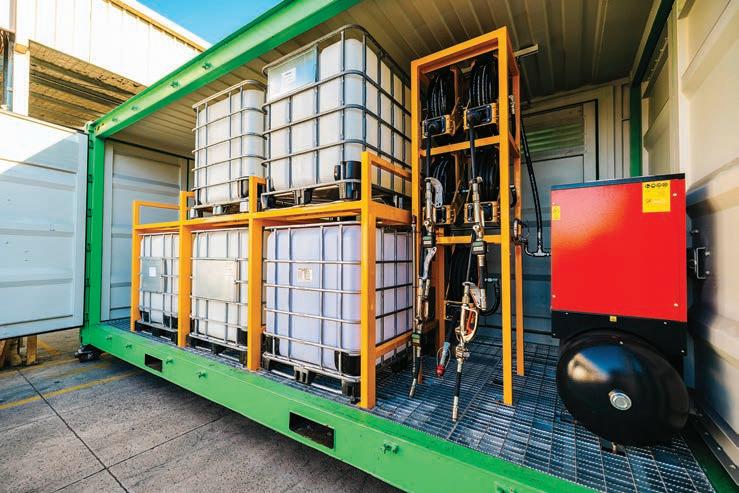
management is so important,” Cook said. “Our state-of-the-art tanks and advanced fuel-management systems are designed to meet this need.
“We offer custom designs and turnkey systems, working closely with our clients.”
The final pillar of A-FLO brings together the elements of the first three into a holistic approach to services and installations.
All A-FLO equipment is serviced and maintained by the company’s team of technical support experts nationally. A-FLO’s ongoing preventive maintenance programs are designed to ensure its products and installations stand the test of time in harsh, roughand-tumble mining conditions.
“Our services are set-and-forget, enabling operators to get back to what they do best while we supply, install and maintain all their lubrication and refuelling needs,” Cook said.
Looking to the future of A-FLO, Cook said the company is in the
service offering in Australia’s growing mining industry.
“We’re expanding our range with our new lube stores, which allow for a portable workshop that can be customised and engineered to any requirements,” he said.
“We’re also building up our team to support the mining industry, particularly with our tanks and systems, which are another example of our ability to customise our solutions for our customers.”
With plenty of projects in the pipeline and a growing network of customers across Australia, Cook said A-FLO’s success is thanks to its comprehensive approach to fluid handling, continuous innovation, and “market-leading solutions that continuously redefine industry standards”.
“What sets A-FLO apart is our ability to provide our customers with a full lifecycle ecosystem,” Cook said. “Our unique advantage is being a one-stop partner in lubrication and fuelling for

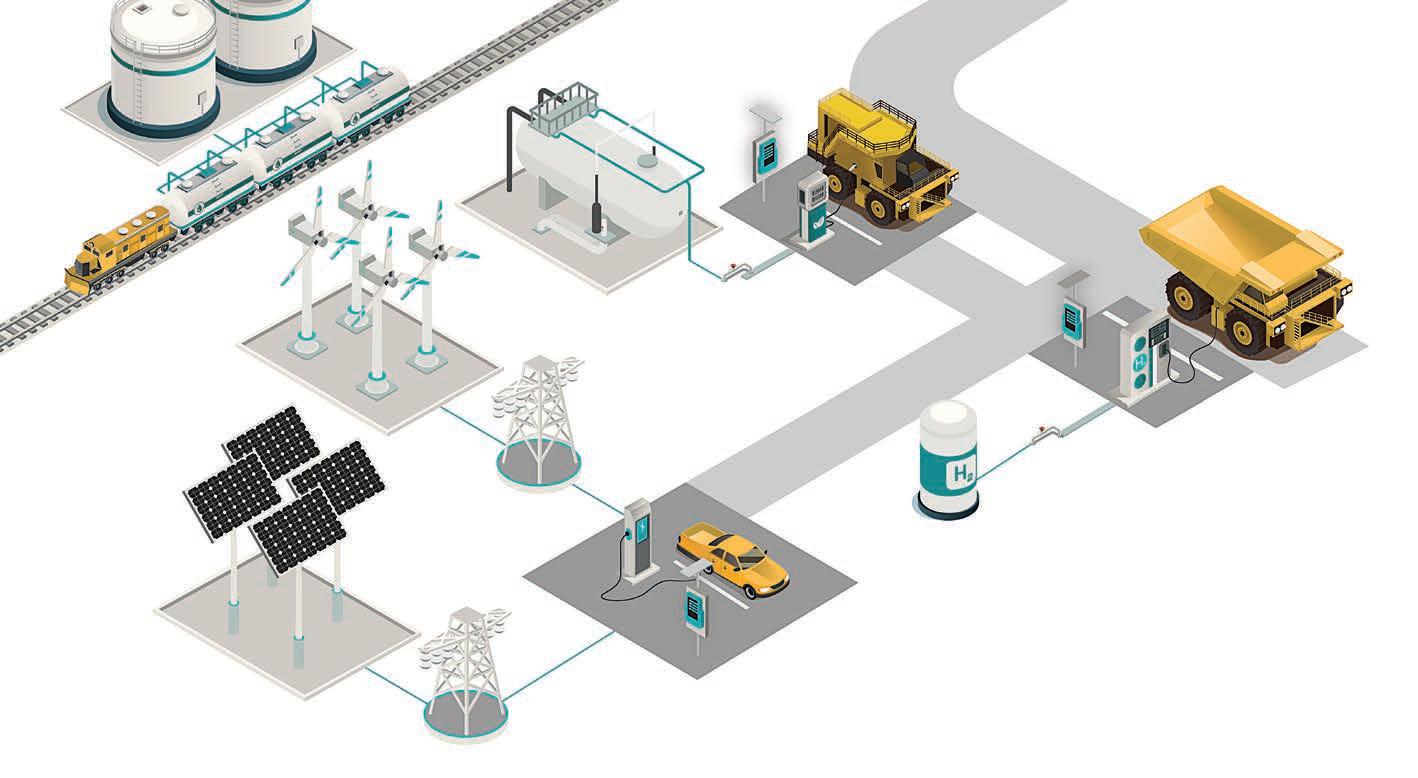
VERIDAPT IS ADVANCING ITS TECHNOLOGY SO IT CAN INTERFACE DIRECTLY WITH EVS AND ASSOCIATED INFRASTRUCTURE.
VERIDAPT HAS
SUPPORTED MINERS
ON THEIR FUEL-MANAGEMENT JOURNEY FOR MORE THAN TWO DECADES, BUT THE COMPANY’S NEXT MISSION MIGHT BE ITS MOST SIGNIFICANT.
The Australian mining industry will need to work with partners from all corners of the mining equipment, technology and services (METS) industry if it hopes for a streamlined energy transition.
While original equipment manufacturers (OEMs) will be critical in providing the decarbonised machinery, the technology sector is going to be equally – if not more –important in enabling the integration of this equipment.
Veridapt has been a forerunner in digital energy management for over 20 years and has a critical role to play in providing the platform, hardware and expertise to support a diversified energy mix.
Veridapt’s AdaptFMS is recognised as one of the most comprehensive fuelmanagement solutions for industrial industries. The company’s AdaptMAC hardware serves as the primary dataacquisition, authorisation and control device, while the AdaptIQ software application reports on fuel transactions and emissions across the supply chain.
With plenty of scope for further advancement, these systems are inherently adaptable and scalable to manage the complex energy profiles expected as part of the green transition.
As Veridapt readies its customers for what’s ahead, the company often asks the question, “How are you transitioning to clean energy?”
“It’s obviously not going to be a flick of the switch. Instead, it will be a transition over time,” Veridapt cofounder and chief technology officer Sean Birrell told Australian Mining
“Customers are going to end up with mixed fleets of EVs (electric vehicles), traditional ICE (internal combustion engine) equipment, and potentially hydrogen and other technologies as well.
“The requirements to report on your costs and energy use, and the need to manage your supply chain, those things are going to remain, but it’s going to be in a more complex environment. Fleets that previously relied on one energy source – diesel – will now have multiple sources of energy.”
This is where Veridapt comes to the fore.
“Some customers are already integrating EVs into their fleet,” Birrell said. “We’re working with these customers to visualise their mixedenergy footprint and understand the associated reporting requirements, and are starting to onboard other energy sources into the one platform.”
As Veridapt’s energy-management offerings have evolved over the years, the company has already overcome many of the technical hurdles that can come with proving a nascent digital solution. This provides a strong foundation for Veridapt to embrace future energy opportunities.
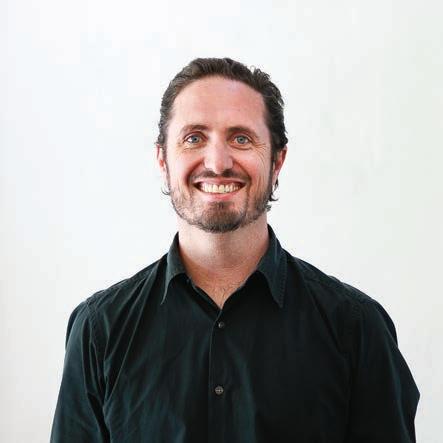
“By solving the monitoring challenges related to the diesel supply chain, we’ve already solved many of the technical problems you might face in monitoring the energy footprint of an EV fleet,” Birrell said.
“In mining, that is rugged, robust hardware that can survive in the field, is fit for purpose, and has the right communications options. Our IoT (Internet of Things) platform has been designed for that environment very specifically, so that gives us a strong base to build on.
“We are advancing our technology so it can interface directly with EVs and associated infrastructure – there are already open standards that support this communication. We also have the appropriate sensing technology that can be installed to monitor electrical loads from an EV or mixed fleet.”
As Veridapt evolves its energymanagement platform, the company will move with the industry as more and more reporting guidelines are introduced for decarbonised fleets.
“What we’re already seeing is demand for more accurate, real-time data around emissions, whether that
be for mandated external reporting or internal reporting against company objectives and goals,” Birrell said.
“Emissions are also more than just CO2, with the need to report on other gases such as nitrous oxide and sulfur oxide. There’s also increasing focus on other emissions such as particulate matter.
“In a clean-energy future, clients will need to aggregate their emissions data, report on it, include energy data from their EV fleet, and combine that in a way that shows they’re progressing towards targets and are meeting their reporting obligations.
“We hope to support our customers on this journey.”
With so many moving parts to understand and enact as the Australian mining industry decarbonises, any way Veridapt can simplify the processes involved with transitioning to green technologies will be valuable for its mining customers.
“What we want to do is reduce complexity, simplify data acquisition and reporting, and provide a single source of truth across entire fleets and energy consumption,” Birrell said.
“Our platform will work for customers worldwide throughout the energy transition, which is equally advantageous for new customers as it is for our strong customer base

technologies will not only be a necessity for the Australian mining industry but also an opportunity to
cost input,” Birrell said. “It will tell miners a lot about how they run their business, and sourcing and procuring
can accurately report on their energy footprint and meet their reporting obligations and improve their

IN THE SECOND OF A TWO-PART SERIES, AUSTRALIAN MINING TAKES A LOOK AT THE OUTLOOK FOR THREE COMMODITIES THAT WILL BE CRITICAL TO THE ENERGY TRANSITION.
Federal Resources Minister
Madeleine King said it best: “The road to net-zero runs through Australia’s resource sector”.
Australia is home to some of the largest recoverable critical mineral deposits on Earth, and these deposits will be vital if the world is to reach net-zero by 2050.
But as important as these minerals are, they aren’t immune to the typical highs and lows of the pricing cycle.
In the final of our two-part series, we take a deep dive into the Resources and Energy Quarterly’s (REQ) forecast for three of the country’s most important minerals for the energy transition.
Aluminium
Aluminium can be found in almost all of the electronic devices we have come to know and love.
But this commodity is also a key part of the energy transition, essential in producing solar-powered technologies.
Australia’s aluminium exports are tipped to hit $10 billion in 2024–25, amid growing global demand for electric vehicles (EV), while the Australian bauxite sector is on track to become a $2 billion export industry in the same timeframe.
According to the June REQ, China led the global consumption of aluminium in the March quarter, but South Korea and Japan were also in the mix, with aluminium usage rising 5.7 per cent and 2.8 per cent, respectively.
“China remained the world’s largest alumina consumer, accounting for 59 per cent of global alumina usage, and drove most of the gain (up 3.4 per cent year-on-year),” the report said.
“The energy transition appears likely to provide enormous opportunities for the aluminium industry.”
The REQ is forecasting aluminium usage per battery EV to rise from 292kg in 2022 to 328kg in 2035. Internal combustion engine (ICE) vehicles are also prompting a rise in aluminium usage, rising from 185kg in 2022 to 208kg in 2035.
“It is estimated EV sales will rise from 14 million units in 2023 to over 26 million units in 2026,” the report said.
“With an estimated average aluminium content of 292kg per EV, aluminium usage in EVs is forecast to increase from 4.1 million tonnes (Mt) in 2023 to 7.7 Mt in 2026.”
A strong project pipeline and the second highest global reserves has put Australian lithium up in lights.
Global lithium demand is projected to rise by 17 per cent each year from 2023–26, driven by the adoption of EVs. However, export earnings
look ready to fall as the lithium price drops.
The REQ is forecasting lithium export earnings to drop from $20 billion in 2022–23 to $9.1 billion in 2025–26.
“While production in Australia is expected to increase, Australia’s share of global lithium extraction is projected to fall from 45 per cent in 2023 to 39 per cent by 2026 as supply picks up across a diverse range of countries,” the REQ said.
Zimbabwe and Argentina are ready to rival Australia in lithium growth, with Argentinian extraction expected to rise from 42,000 tonnes in 2023 to 153,000 by 2026.
“Argentina holds 12 per cent of global lithium reserves and generally has access to lower cost brine resources compared to Australia’s hard rock resources,” the REQ said.


2023 to 161,000 tonnes by 2026. This growth is due in part to China’s recent investments into hard rock lithium projects in the African nation.
“In 2022, Zimbabwe’s government banned the practice of direct ore shipment, requiring ores to be processed into lithium spodumene concentrates domestically before export,” the REQ said.
“The commissioning of some of those processing plants saw Zimbabwe’s lithium extraction rise sharply over 2023. Many of these projects will continue to ramp up over 2024, and new projects are expected to begin production over the outlook period.”
Used in rechargeable batteries, wind turbine blades, and hybrid vehicles, nickel may just be the unsung hero of the critical mineral cache.
And as the fifth largest global nickel miner, Australia is poised to capitalise from the world’s demand for the critical mineral.
“Nickel prices rebounded strongly in the June quarter, with the average price in the month of May ($US19,500 a tonne) up 25 per cent from February lows,” the REQ said.
“Despite slowing activity in the global economy in the last 12 months, world demand for nickel remained robust in the March quarter 2024, driven by China and Indonesia.”
“The recent (and significant) fall in nickel prices is expected to result in a substantial drop in Australia’s total mined and refined nickel production through to 2025–26,” the REQ said.
“Recent price falls have seen mine closures and reduced output from several Australian producers, as well as delays in planned projects.”
The primary driver of nickel growth
to be offsetting any major impacts to the nation’s total demand,” the report said.
“China’s total nickel usage has been bolstered by a recovery of its manufacturing sector from early 2023, and the rapid rise of its EV sector.”
Nickel and cobalt exploration expenditure in Australia for the 2024 March quarter was $49 million – a drop
expenditure falls, new Australian nickel
slightly since the March 2024 REQ.
“Major economies have seen a modest uptick in economic activity, and the outlook is for an improvement in world economic growth in 2025,” the report said. “Nickel and lithium prices have managed to make modest recoveries as global supply is wound back closer to demand.
“Investment in new deposits and

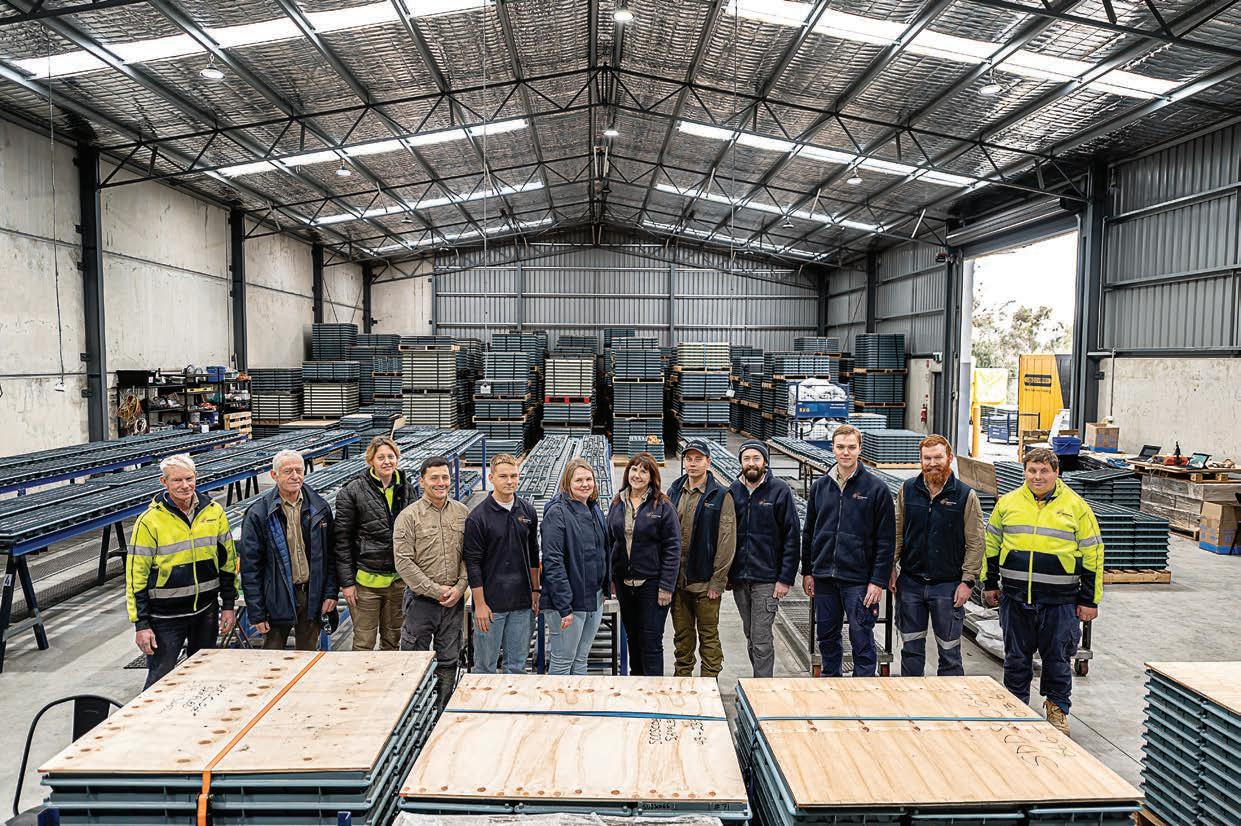
Victoria has long been associated with the gold panners of old – and the state may be in for a modern gold rush as a new era of technological transformation flourishes.
While gold may be seen by the layperson as a shiny, pretty metal with not much use outside of jewellery, the commodity is quickly becoming known for a different use.
A highly efficient electricity conductor, gold has the sought-after ability to carry tiny currents without losing energy, all while remaining corrosion-free.
It can be easily moulded into thin sheets or tiny wires without breaking and is compatible with other elements like copper and silicon, making it perfect for the creation of intricate circuitry.
Today, most electronics including phones, televisions, and game consoles have some amount of gold in them.
As populations boom and electronics become more accessible than ever, gold is finding itself at the centre of the technology era.
And the demand is only set to grow. But where will the world source this precious, finite metal?
Though new gold projects are cropping up across Australia, one could be forgiven for thinking Victoria’s resources were all but dried up.
According to Victorian-based Southern Cross Gold (SXG) managing director Michael Hudson, nothing could be further from the truth.
SXG is in the midst of exploring its highly prospective Sunday Creek gold-antimony project in the Victorian Goldfields, around 60km north of Melbourne.
Hudson believes Victoria, with modern knowledge, has abundant gold to be found below its quartz-rich soil, and he’s not alone.
In fact, it could be said that Victoria is experiencing its third gold rush with more gold produced annually today than it has for 100 years.
Of the explorers, Catalyst Metals’ Four Eagles gold project is nestled 70km north of the historic Bendigo Goldfields. Catalyst has gold mines in Western Australia and Tasmania, and now has its eye on developing its newlydiscovered gold zone in Victoria.
Joining Catalyst in the Bendigo region is Falcon Metals’ Pyramid Hill project, which was staked in 2017 and now covers an area of over 7000 square kilometres. ECR Minerals holds three tenements in Creswick, Baileston, and Tambo, where exploration is currently returning some promising results.
These projects are in their relative infancy in the grand scheme of pit-to-port production, but there’s one operation used as the blueprint for a successful Victorian gold mine: Fosterville.
Agnico Eagle, the world’s second largest gold producer, operates the Fosterville mine in central Victoria. Gold was first discovered in the area in 1894 and the present-day Fosterville began operations in 2005, with production progressing humbly from near-surface, low-grade mineralisation.
The tables turned for the previous owner, Kirkland Lake Gold, in 2015 when high-grade gold mineralisation was spotted at depth, leading to the discovery of the well-known Eagle deposit, followed swiftly by the ultrahigh-grade Swan zone in 2016 which made Fosterville the highest-grade underground gold mine globally.
In March 2023, Fosterville celebrated the production of its four millionth ounce of gold.
In less than a decade, Fosterville, and now Sunday Creek, have rebadged the Victorian gold opportunity.
These deposits form high-grade projects that are geologically different
to the style of deposits that made Victoria famous in the 1800s.
SXG’s geologists have now turned this understanding into commercial reality.
Aiming to join Fosterville in the gold production ranks, SXG has been steadily ramping up exploration at its Sunday Creek project in an effort to bring the operation online.
Australian Mining sat down with Hudson to discuss the project and SXG’s outlook for the future of Victoria’s gold sector as a company poised to thrive in its next iteration.
“Although we have drilled almost 60km of diamond drilling over the last
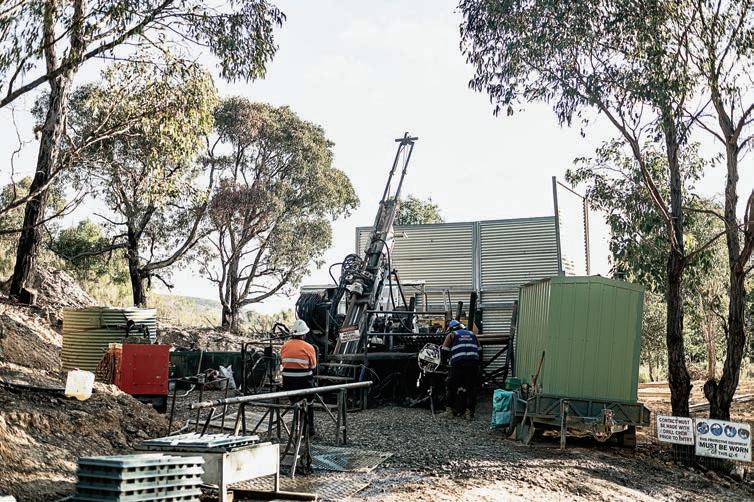
two years, we are still early into our discovery with only three per cent of the 10km trend tested,” Hudson told Australian Mining. “Sunday Creek is a top quartile discovery in terms of gold grades and has the opportunity to become one of the world’s highest margin mines in the future.
“We are doing the traditional technical work in the background that a discovery like this demands, including metallurgy, early mining studies, environmental baseline studies and significant social and governmental work to ensure we bring all stakeholders along with us as the project rapidly develops.”
Victorian gold explorers like SXG are highly attuned to the world’s everincreasing need for electronics and, by extension, gold.
SXG is also interested in Sunday Creek’s antimony potential, itself a highly critical metal in the renewable and defence sectors and a close metal associate to gold in Victoria.
“The race to achieve a low-carbon world coupled with the rise of AI (artificial intelligence) means that the search for and eventual extraction of all critical metals, including gold, is one of the world’s least understood challenges,” Hudson said. “So we need to reimagine the value that scarce resources can create for a better mining business all around.
“A healthy mining sector creates a much stronger outcome for all stakeholders including financial, social, environmental and safety outcomes and is the foundation to sustainable downstream supply chains.”
Looking to the future of the sector, Hudson sees the main challenges prospective producers face include capital expenditure overruns, growing production costs, environmental
constraints, political instability, declining reserves, permitting timeframes and a major lack of new Tier 1 discoveries.
“As an explorer, my focus inevitably falls on the last point,” Hudson said. “We are facing decreasing discovery rates, with near surface ‘low hanging fruit’ mostly gone, and permitting timeframes becoming unrealistically long (17 years is the global average from discovery to development).
“It will take a holistic approach by the private sector, governments and society as a whole to super-charge discovery rates to get anywhere close to the amount of metal that is required for the energy and artificial intelligence revolution.”
Hudson is confident the Sunday Creek site is one such project set to meet the needs of a changing world.
SXG has a plan to put it on a path to production within the next five years. In the short term, this will include increasing the number of drill rigs on site from five to six over the coming months, with each rig expected to drill around 10,000m a year.
The company’s longer-term goal will see it undertake the next stage of metallurgical test work, advance mining and engineering studies, and continue working with stakeholders to reach an eventual licence to mine.
Part of the plan is SXG’s soon-to-befinalised merger with Canada-based Mawson Gold, which owns 49 per cent of SXG. The merger will consolidate ownership of the Sunday Creek asset, which will then be listed on both the ASX and Toronto Stock Exchange.
The merger will achieve a simpler, dual-listed structure with broader access to global capital markets and attract an expected lower cost of equity capital.

we need to ensure we complete the right work, at the right time, at the right cost of capital,” Husdon said. “For exploration companies, equity financing is the only option for financing a discovery.
“Share counts can grow by hundreds of per cent in only a few years and ruin the value a discovery can create, if not managed very carefully. This is easier said than done.
opportunity nor scale.”
It’s an ambitious plan, but such is the nature of discovery. And SXG is at the forefront of Victoria’s next generation of gold explorers set to usher in new life to the state’s gold sector.
Major mining operations like Fosterville are proving high-margin and high-grade gold is still waiting to be uncovered across Victoria, and SXG may just be the next giant to emerge and stake its claim in a golden future. AM


SUNDAY CREEK IS EXPECTED TO RAMP UP DRILLING EXPLORATION TO REACH 60,000M IN THE NEXT YEAR.

THEJO’S RANGE OF MINERAL PROCESSING AND BULK MATERIAL HANDLING PRODUCTS AND SERVICES IS HELPING AUSTRALIA’S MINES KEEP ON TRACK.
Since launching into the Australian mining sector in 2012, Thejo has established a strong reputation, which, as Thejo Australia chief operating officer Andrew Thompson explained, is in part thanks to the legacy of the international brand.
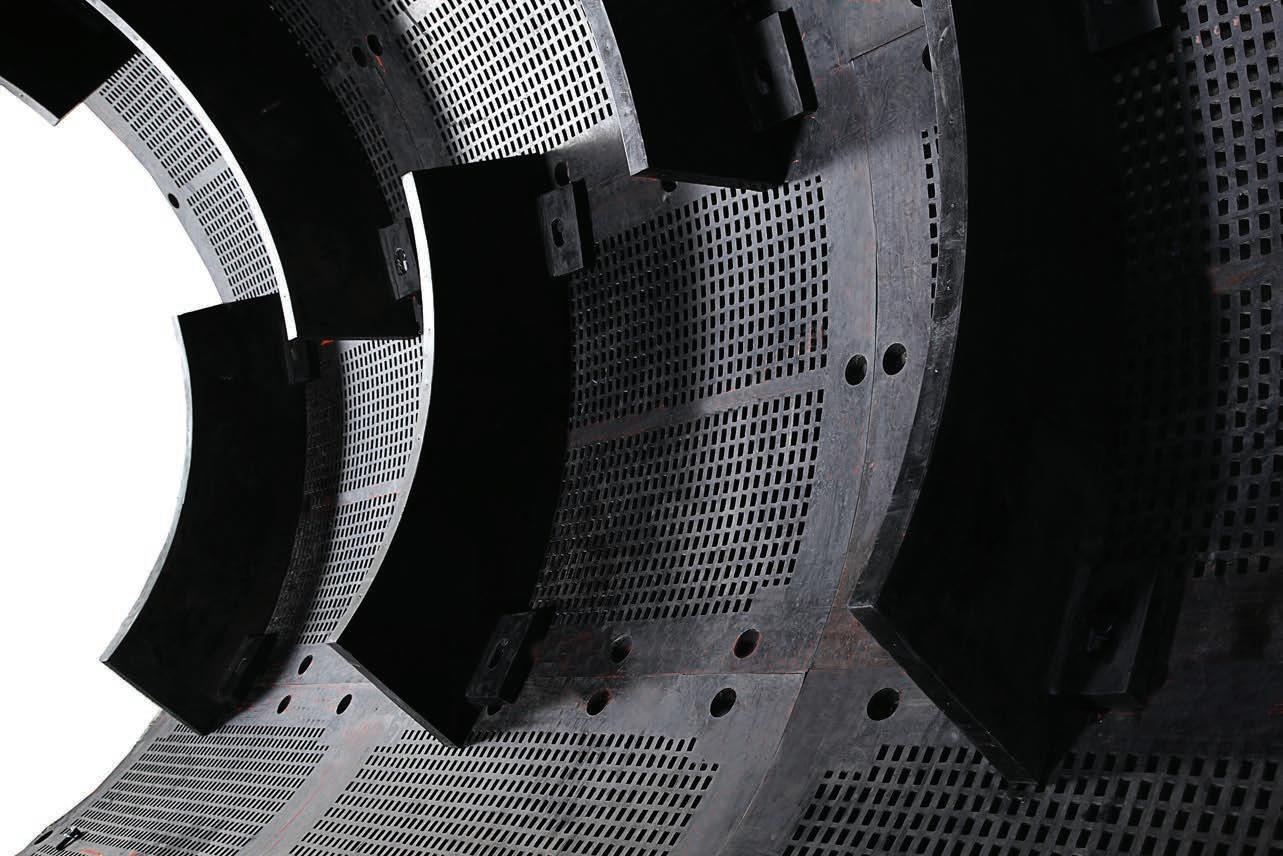
“Our mission is to combine a commitment to quality and a welldesigned and built product with flexibility and a timely delivery to market.”
“Thejo Engineering has a worldwide footprint spanning India, Brazil, Saudi Arabia, the United Arab Emirates, Chile and Australia,” Thompson told Australian Mining. “Since Thejo Australia launched, we’ve been offering solutions that have been tested and perfected across the globe.”
Thejo Engineering started out in India 50 years ago with a commitment to developing next-level mineral processing and bulk material handling solutions.
Research and development (R&D) has always been a central focus for Thejo, and the company’s Australian arm is no different.
“We have been busy expanding our capabilities to bring our solutions to more mines,” Thompson said. “Our expanded product offering covers every aspect of mineral processing and bulk material handling equipment.”
Whether it’s chute lining, mill lining, screening, filtration and dewatering systems, corrosion protection, rubber lining, or a complete range of conveyor belting and conveyor care products, Thejo and its team of engineering experts are pushing to take the next leap in product evolution.
“We’re continuing to invest in R&D and product development,” Thompson said. “The vision of our founders has always been to be a worldclass company.
“That’s why we undergo rigorous product development and testing to ensure we’re giving our customers toptier solutions.
Thompson said regular inspection and maintenance plays a critical role in increasing the service life of any asset.
“Predictive, real-time remote monitoring can be used to minimise unplanned downtime,” he said.
“Through industry partnerships, Thejo is able to offer real-time monitoring equipment for abrasive wear in multiple applications, including mill lining and conveyor belts, while a belt cleaner monitoring system is under site trial as we speak.”
Thejo’s range of products features conveyor belting and components, installation equipment and vulcanisers, and transfer chute design, repair and replacement, including wear liners, dust suppression and flow promotion.
The company also offers comminution equipment such as liners for mills, pulp lifters, trommel design and supply, all types of screen media and accessories, as well as consumables for filter presses, and slurry handling pipes, spools and hoses.
But it’s not only products where Thejo is investing resources. The company’s services arm is providing its customers across Australia with complete material handling packages for the design, construction, supply and maintenance of conveyor systems and rubber linings.
This includes belt splicing, repair, pulley lagging and a complete belt replacement service. Thejo has over 40 trained belt and mechanical technicians employed full time including a
supervision team ready to be deployed to site as needed.
The company takes a holistic approach to its services, with designated operations, health and safety, training, and management teams to support its service crews in the field.
It’s an approach Thejo carries into its comprehensive rubber lining products and services, where the company provides both hot- and cold-applied rubber lining, including rubber-backed ceramic tiling, to provide suitable protection for plant equipment.
“We supply rubber linings for the most aggressive mining and quarrying applications,” Thompson said. “The benefits of rubber lining for this industry include high resistance to abrasion and corrosion, noise reduction, increased plant life and reduced downtime.
“Our customers know they can count on us to be available when they need us.
“We’re always responsive to enquiries and work with our customers to keep their conveyors and linings on track.” AM
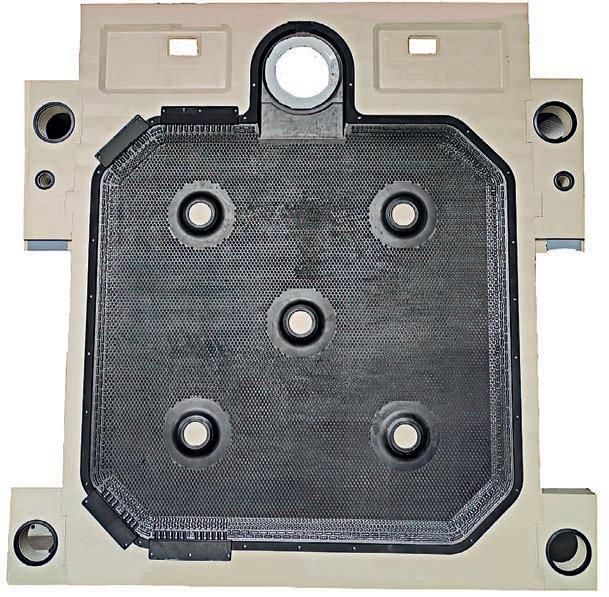


There’s no better place for a premier mining mainstay event than the heart of Australia’s resources industry: Western Australia.
The 2024 WA Mining Conference and Exhibition (WAME) will kick off at the Perth Convention and Exhibition Centre on October 9 for two days of mining excellence.
As WAME’s first year under the new ownership of Prime Creative Media, attendees will be treated to a night of celebration with the Australian Mining Prospect Awards set to light up the stage on the first night.
As for the rest of the event, this year’s WAME will showcase the mining industry’s digital evolution, exploring innovation and research while addressing the social and environmental standards helping to drive a more sustainable industry.
With digitalisation and automation pushing the industry into new frontiers, new technologies will be front and centre at WAME, with cybersecurity managers, technology heads and chief technology officers in attendance looking to discover the high-tech step-change.
Show director Siobhan Rocks said the 2024 event is designed to connect mining industry businesses on a whole other level.
“Western Australia is an absolutely vital market for the mining industry and we’re focusing on connecting buyers in that market,” Rocks said.
“We’re making it so that they don’t have to come all the way over to the eastern seaboard to talk to people within mining communities.”
Building on the success of last year’s show, the 2024 event will feature an expanded range of exhibitors, with big names including Epiroc, ifm, Motion, RaptorTech and Blackwoods having already secured their spot on the floor.
“This really is a great event for key industry decision-makers to see what innovative solutions are available on the market,” Rocks said.
Last year’s WAME was one of the most successful to date, with almost 5000 visitors across the event. Engineers were a major presence in 2023, with Rocks noting they represented more than 20 per cent of visitors. Another 16 per cent of visitors identified as senior management.
“Engineers have also expressed a strong interest in the 2024 event, not only as visitors but also as exhibitors,” Rocks said.
Following popular demand, WAME has this year launched a new product category – advanced solutions from engineering companies – and the uptake has been impressive.
Other new industry categories at this year’s event include Mining 4.0, renewables and the circular economy.
The significantly expanded exhibition will showcase technical and digital innovations across the entire mining value chain.
WAME’s paid conference runs parallel to the free-to-attend exhibition and features more than 40 speakers sharing case studies and thought leadership from academia, industry and more.
The highly targeted conference will cover major industry themes including critical minerals and digital and autonomous systems. Speakers will illustrate the economic importance of WA and its contribution to the industry.
The likes of Rio Tinto and material tracking technology specialist Track’em are key stand-outs on the speaker line-up, with attendees able to expect the cutting-edge in
Major miners have always been well represented at WAME, with key personnel from the likes of BHP, Rio Tinto, Fortescue, South32 and Newcrest all on hand at the 2023 event.
“This year’s event will welcome leaders from mining companies, government and all the key bodies in Western Australia as part of our speaker line-up,” Rocks said.
“WAME will provide mining professionals with the technological insights set to shape the future of the
WA has long been considered the mining capital of Australia, a veritable cornucopia for the resources industry, where juniors and giants alike come to play. WAME brings all of this exciting potential together in a single unmissable event. AM
The WA Mining Conference and Exhibition will be held at the Perth Convention and Exhibition Centre from October 9–10. For more information, visit








IntelliZone® is a user-friendly proximity detection system that creates shaped, dynamic shutdown/caution/ operator zones to enhance miner safety.
• IECEx-certified for underground coal in Queensland and all of Australia since 2018 and EMESRT Level 7 & 9 compliant.
• Shaped-zone technology minimises nuisance alerts - works on standard or articulating equipment.
• Miner-bolter operator can stand close to the machine and remain in a safe area.
• Purpose-built for underground mining and can be installed on all mobile equipment.
• 2021 U.S. NIOSH Safety and Health Technology Innovation Award winner. OPERATOR










THIS YEAR’S THE PROSPECT AWARDS WILL BE HELD IN CONJUNCTION WITH WA MINING CONFERENCE AND EXHIBITION.

WHEN THE 2024 AUSTRALIAN MINING PROSPECT AWARDS TAKE PLACE IN OCTOBER, IT WILL MARK THE FIRST TIME THE EVENT HAS BEEN HELD IN CONJUNCTION WITH A MAJOR INDUSTRY CONFERENCE.
From the industry’s humble beginnings to its current cutting-edge practices, mining has long been a driving force in Australia’s growth. And the Australian Mining Prospect Awards highlight the continued pursuit for excellence across the sector.
This year’s awards, the only national program to stop, take a look at what the mining industry is doing, and reward those who are excelling and going above and beyond, will be hosted alongside the WA Mining Conference and Exhibition (WAME), which runs in Perth from October 9–10.
Show director Siobhan Rocks believes the significance of the awards is a major contributor to making
WAME 2024 a must-attend event for anyone in the mining industry.
“The Australian Mining Prospect Awards are more than just a night of celebration,” she said. “The event represents the culmination of hard work, innovation, and dedication within the mining sector.
“Our goal is to highlight those who are setting new standards and pushing the boundaries in mining.
“There is something for everyone and that’s why we decided to host the awards alongside the WA Mining Conference and Exhibition.”
This year’s awards night promises to be more impactful than ever.
With categories ranging from Safety Advocate of the Year to Excellence in Environmental Management and

Sustainability, the awards will recognise a wide range of accomplishments. Each category underscores the multi-faceted nature of the mining industry and the myriad of ways in which professionals contribute to its advancement.
One of the highlights of the Australian Mining Prospect Awards is the Innovative Mining Solution Award, which recognises a mine, company or project that demonstrates innovative ways to protect the environment. This award is particularly significant as it underscores the critical role of innovation in ensuring the sustainability and progression of the mining industry.
“Innovation is the lifeblood of the mining sector; it drives efficiency, enhances safety, and opens up new possibilities for exploration and production,” Rocks said. “The Innovative Mining Solution Award celebrates those who are at the forefront of this movement, showcasing the incredible advancements being made.
“The mining industry is constantly evolving, and these awards are a testament to the adaptability, resilience, and forward-thinking mindset of our professionals.
“By acknowledging their successes, we not only celebrate their achievements but help to inspire others in the industry.”
As part of WAME, the 2024 Prospect Awards represent an invaluable networking opportunity for people across the mining sector. Attendees will
have the opportunity to come together with peers to exchange ideas and celebrate their shared successes.
“The Australian Mining Prospect Awards provide a unique opportunity for industry professionals to reflect on the year’s achievements,” Rocks said. “The event is a chance to build connections, share knowledge, and celebrate the incredible work being done across the sector.”
This year’s Prospect Awards and WAME have been developed by Prime Creative Media to provide a complete, memorable and inspiring experience. From the awards dinner to innovative exhibitors to enlightening presentations at the conference, every detail has been designed to provide a first-class experience for all attendees.
“We want every guest to leave the event feeling inspired and appreciated,” Rocks said. “The mining industry is built on the dedication and hard work of countless individuals, and it’s important to take a moment to recognise them and celebrate it.”
The Prospect Awards and WAME are poised to come together as a highlight in the mining industry calendar, celebrating the best and brightest and setting the stage for continued excellence and innovation in the years to come. AM
The Australian Mining Prospect Awards will be held in Perth on October 9. For more information, visit prospectawards.com.au



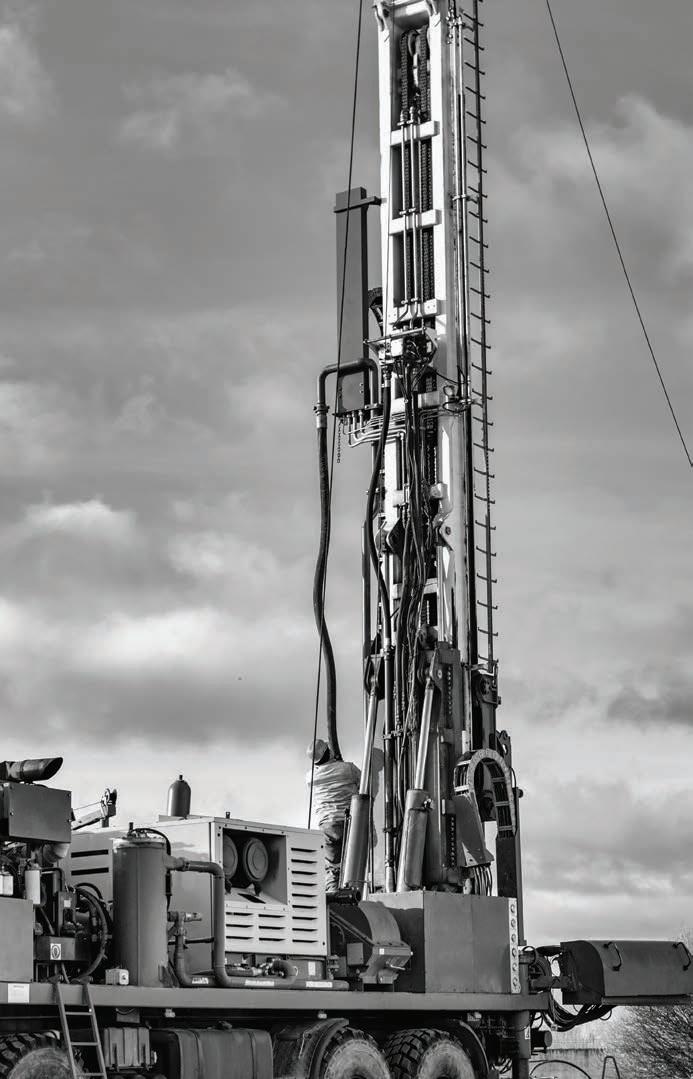
High efficiency skid mounted diesel-powered portable compressors for the drilling industry, with superior performance, proven reliability, best-in-class warranty and low cost of ownership.

With flow rates from 185 to 1500 cfm, the high efficiency ELGi Drill diesel powered portable compressors deliver superior performance and proven reliability.
Built to perform in the most challenging situations, ELGi Drill Portable compressors exceed expectations by delivering superior power, performance and reliability. If you want faster penetration and a better drilling average from a compressor that has a low fuel consumption and an exceptionally durable engine, all within a compact and robust package – then ELGi Drill is the right choice for you!
SEE OUR NEW! 500PSI COMPRESSOR ON DISPLAY AT THIS YEARS DRILL24 IN PERTH - STAND 10A OCTOBER 15TH - 17TH


9–10 October 2024 Perth Convention & Exhibition Centre
Featuring a highly targeted conference, seminar series, and 100+ leading mining suppliers.

A COLLABORATION BETWEEN LEADING PEAK BODIES AUSTMINE AND AUSIMM HAS LED TO A PARADIGM-SHIFTING EVENT: THE GLOBAL RESOURCES INNOVATION EXPO.
For nearly two decades, Austmine’s highly successful biennial innovation conference has delivered the latest in resources thought leadership at a single premium offering.
Now poised to reach new levels, the partnership between Austmine and AusIMM will deliver a strengthened ‘by industry, for industry’ international conference and exhibition that is set to become a powerful catalyst in propelling the Australian resources industry toward innovative new directions.
To be held in Brisbane in May 2025, the Global Resources Innovation Expo (GRX25) will bring together leaders, innovators and professionals from the resources and aligned sectors to mobilise and accelerate a sustainable technology-led future.
As a supercharged evolution of the Austmine conference, GRX25 is an event “not to be missed”.
“We are very proud that our Austmine conference has become the leading innovation conference on the global mining calendar,” Austmine chief executive officer Chris Gibbs Stewart told Australian Mining
“Since its inception in 2005, we have showcased world-leading METS (mining equipment, technology and services) organisations with a directed focus on driving the importance of innovation in our industry.
“Our partnership with AusIMM allows us to amplify aligned messages, connect with broader audiences and offer highly relevant content to the global resources sector.
“Through this collaboration, we are uniting our powerful communities to drive important conversations, showcase innovation, and elevate the industry to greater heights.”

Gibbs Stewart said the central mission of GRX25 is to shine a spotlight on innovation in the resources sector, offering an exciting forum for leaders and change-makers from across the globe to connect, share and learn.
“The conference gives people a place to come together and have strategic conversations, opening up a dialogue between mining companies, stakeholders from industry and government, innovators, and others who are invested in the resources sector,” she said.
AusIMM chief executive officer Stephen Durkin said more than 2000 delegates and 150 companies are

and METS sector to a global audience,” Durkin told Australian Mining
“This annual event will bring our members and the broader community together to connect, collaborate, innovate, and lead the transition to a sustainable future.”
Last year saw AusIMM celebrate 130 years of supporting the careers of resources professionals, while Austmine recently marked 35 years of driving industry thought leadership. With so much history and experience, AusIMM and Austmine have helped lead the resources sector through periods of rapid growth and change.
Gibbs Stewart believes the Australian mining industry is at a critical point, with it more important than ever for resources professionals, companies and government to work collaboratively to drive the world’s energy transition.
“Now, more than ever, innovation is an imperative,” she said. “If you look at the Austmine conference over the last 20 years, you can trace the evolution of technology as it took place.
“That’s why GRX25 is such an important event. It provides an annual event to highlight those things we’re doing well and see what we can do better to drive new cutting-edge ideas for the





THE BULK HANDLING AWARDS ARE BACK AND BIGGER THAN EVER.
September 18 is shaping up to be the night of nights for the Australian bulk handling industry.
From 7.00pm, the Melbourne Convention and Exhibition Centre will be awash with attendees keen to take part in the Australian Bulk Handling Awards, the only such program specifically for the bulk solids handling industry.
Held in conjunction with the 2024 Australian Bulk Handling Expo (BULK2024), the awards program promises to be an event to remember –and sponsor Kinder Australia is excited to be a part of the action.
“Kinder Australia has always been involved in the bulk handling industry,” Kinder Australia sales and marketing manager Sam Veal told Australian Mining. “We see that sponsoring the event is a great way to give back to the industry, recognising others for their contributions.”
Awards range from innovative technology to safety and supply, but all exist to celebrate those going above and beyond in the bulk handling sector.
“It’s always exciting to see new faces, products, entrants and initiatives in the marketplace,” Veal said. “The awards are a great way to both visualise and celebrate the sector’s movements.
“The industry has given Kinder and all involved a lot over the years, and it’s good to be able to give back to them through this sponsorship.”
Kinder Australia is sponsoring the award for dust control technology, application or practice, which recognises an outstanding implementation or project that helps to keep dust creation in the bulk solids handling process to a minimum.
The award ties in well with Kinder’s AirScrape contactless conveyor belt skirting, which the company will be displaying on the exhibition floor across the two days of BULK2024.
“We’ll be showcasing some products that we believe will be the missing link for the industry,” Veal said. “AirScrape in particular is an advanced, unique solution for the bulk handling industry.”
AirScrape acts as a side seal for conveyors, suspended over the belt. With its diagonal arrangement of hardened lamellae, built into a contactless polyurethane skit, air is led from the outside into the middle of the belt, creating a powerful air suction – mitigating dust, especially at transfer points.
“We see AirScrape as an incredible solution, and one we believe the market is commanding” Veal said. “The market wants to be assured that operators are
BULK2024 WILL COMBINE A STRONG CONFERENCE PROGRAM WITH A MAJOR EXHIBITION.
doing all they can to help mitigate the issue of dust in operations, especially as we see the issues caused by conditions such as silicosis.”
connect with colleagues and peers while showcasing solutions that will help the bulk solids handling industry move its products to where they are needed most – both domestically and internationally.
This year’s event will feature an expansive trade floor, showcasing the latest solutions for the industry, as well as an informative two-day conference examining how businesses can remain cutting-edge in a constantly changing world.
exhibition floor and see what others have

and encourages others to help the industry evolve.” AM
BULK2024 and the Bulk Handling Awards will be held at the Melbourne Convention and Exhibition Centre from September 18–19. Head to bulkhandlingexpo.com.au for more info.
AUSIMM FELLOW MARK ADAMS IS KEEN TO BE PART OF THE ACTION WHEN THE MILL OPERATORS CONFERENCE OPENS ITS DOORS IN OCTOBER.
Since its inception in June 1978, AusIMM’s Mill Operators (MillOps) Conference has been pushing the boundaries of what it means to be in the mineral processing industry.
This once-regional gathering has steadily grown into a global event –and when this year’s iteration opens its doors in Perth from October 21–23, its promising to be the biggest yet.
Set to attract more than 600 industry professionals, MillOps 2024 will be a hub for networking, learning and growth, and keynote speaker Mark
“In this industry, the people make the difference,” Adams told Australian Mining. “I’m really interested to hear the innovative ideas attendees will have about how we’re going to better the sector in the future.”
Adams’ career has spanned almost the same length of time as MillOps.
From working in the underground mines of Zambia and Botswana to becoming asset president for BHP World Minerals’ Cannington operation in Queensland (now owned by South32), Adams has worked through some of the key events that have shaped the industry.


“I’m an underground miner by profession but I was seconded to the metallurgical division at Mount Isa for 18 months and I thought it was good to try something a bit different,” Adams said.
“I got to meet and work with an exceptional group of metallurgists there who helped me to understand what made the metallurgy industry work.”
Adams took that experience with him when he moved to Western Australia. Since then, he’s been involved in some key projects.
“We spend a lot of money on mining, so it’s important we focus on safety and maximising the value of what we extract,” he said. “I often talk about mining being like a relay race; when
someone moves on they can’t drop the baton, they have to hand it over to the next person so they can finish what the first person started.”
Adams will draw on this wealth of experience for his keynote speech, with the current state of nickel a key focus.
“I’m going to talk a bit about the value chain of operations I’ve been involved in, as well as in-situ recovery and in-situ leaching,” he said.
“In-situ recovery and leaching are, I believe, the next major aspect we need to consider to restore our position on the nickel cost curve. They will also help us extract orebodies that are not currently seen as being economic.”

Attendees can also look forward to addresses from leaders at Newmont, IGO and BHP across the three days.
Networking drinks and a conference dinner will provide excellent opportunities for attendees to connect and build relationships.
There are also several key themes shaping the conference, including updates and newly commissioned plants, best practice in existing operations, operation and optimisation of key units, and environmental, social and governance (ESG).
But, as Adams said, the true value of the conference will come from those who are in attendance.
“We have some quite exceptional processing people in Australia who are at the top of their game,” Adams said.
“MillOps will be about really listening to them and understanding what they want to do differently to progress to the future of metallurgy.” AM
AusIMM’s Mill Operators Conference 2024 will be held in Perth from October 21–23. Head to ausimm.com/conferencesand-events/mill-operators for more info.








EVENT SUBMISSIONS CAN BE EMAILED TO TOM.PARKER@PRIMECREATIVE.COM.AU

International Future Mining Conference
Sydney | September 2–4
The 6th International Future Mining Conference will explore transformative technologies, champion innovation and push the boundaries of possibility.
The carefully curated 2024 conference program will review the digital leap, mining in extreme environments, future skills requirements, opportunity exploration, energy innovations and a green mining future.
Experience the world of digital transformation, the vast potential of space mining and explore decarbonisation strategies, circular economy models and waste management in Sydney from September 2–4.
• ausimm.com/conferences-and-events/ future-mining
Australian Mining Prospect Awards
Perth | October 9
Mining has always been a part of Australia’s landscape, playing a major part in the development of this nation from its early days.
The sector remains vibrant and innovative, and for more than a decade,
the Australian Mining Prospect Awards have been the only national awards program to stop, take a look at what the mining industry is doing, and reward those who are excelling and going above and beyond, recognising and rewarding innovation.
The Awards are the most esteemed and prestigious awards program for the mining and minerals processing industry within Australia.
• prospectawards.com.au
WA Mining Conference and Exhibition
Perth | October 9–10
The WA Mining Conference and Exhibition will integrate the innovation and research ecosystem while addressing the social and environmental standards driving a more sustainably conscious industry. The largely expanded exhibition will showcase the technical and digital innovation across the entire mining value chain, while the highly targeted conference will illustrate the economic importance of Western Australia and its contribution the resource technology sector, its innovation capability, its job creation, and the attraction of capital to the state.
WA Mining is the ultimate event for mining and engineering professionals,
showcasing the technical and digital evolution transforming the mining industry in Western Australia. • waminingexpo.com.au
Mill Operators Conference
Perth | October 21–23
Now in its 16th iteration, AusIMM’s Mill Operators Conference 2024 is an acclaimed industry event that brings together metallurgists, geometallurgists, engineers, leaders, executives and other industry professionals to discuss advancing best practice, emerging technologies and global factors impacting mill operations. AusIMM is thrilled to share a remarkable number of highquality abstracts, guaranteeing that its 2024 program will be one of the best to date.
• ausimm.com/conferences-and-events/ mill-operators
IMARC
Sydney | October 29–31
The International Mining and Resources Conference (IMARC) is where people from across the entire industry come together to deliver ideas and inspiration. Learn from in excess of 500 mining leaders and resource experts throughout
seven concurrent conferences with a program covering the entire mining value chain. Attend one of the many networking events or catch up with industry colleagues on the exhibition show floor featuring more than 470 leading companies.
There will be practically endless opportunities to network, brainstorm and share knowledge over the three days at the ICC Sydney.
• imarcglobal.com
Sydney | September 2–4 2025

In 2025, Australia’s longest-running mining exhibition will return to Sydney Showground to bring together the largest community of mining suppliers and professionals all under one roof. As the key event on the mining calendar, Asia-Pacific’s International Mining Exhibition (AIMEX) is an internationally renowned platform showcasing the latest mining technology, equipment and services, and offering a unique opportunity for leading suppliers and buyers to conduct face-to-face business, learn about the latest trends and network in an interactive forum.
• aimex.com.au




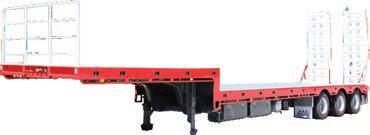




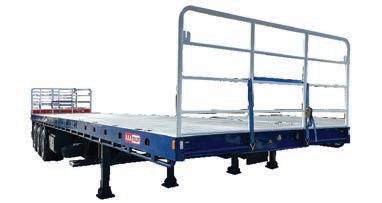





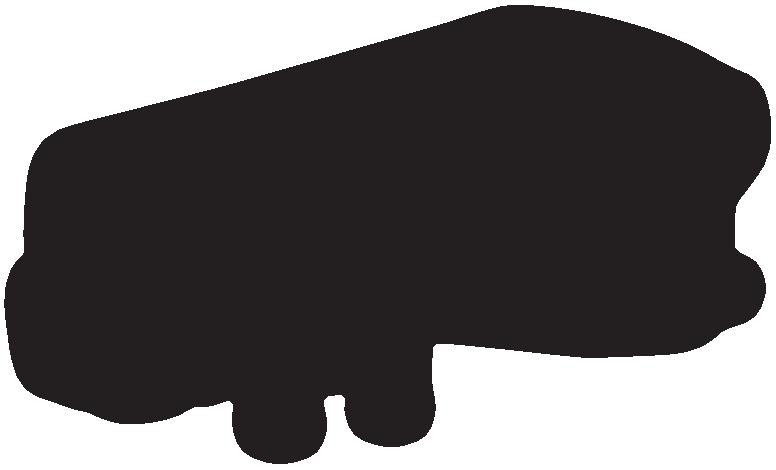










Certified Rebuild programs help you benefit from the multiple lives designed into Cat® machines, power trains and major components. They are “built to be rebuilt” for maximum value and longer life. Maximise the investment in your asset with full utilisation of a second life, at a fraction of the cost of buying new.
Access to advanced condition monitoring service with HDAdvantage™ program
Sustainability – reducing waste by reusing and recycling quality material

Finance options available


Call Hastings Deering on 131 228 or scan here to find out more
*Terms & Conditions apply.
**Offer ends 31 December 2024